Physical Address
304 North Cardinal St.
Dorchester Center, MA 02124
Children with musculoskeletal injuries and afflictions are brought for care because of pain, deformity, or loss of function. Because of their rapid physical growth and the special properties of their developing bones, children often pose special problems for the clinician.
Musculoskeletal problems in children fall into several general categories.
Trauma (discussed here and in Chapter 6 )
Congenital problems—problems resulting from genetic factors and from exposure to teratogens, as well as deformations stemming from insults later in pregnancy, many of which are associated with anomalies of other organ systems (discussed here and in Chapter 1 , Chapter 16 , Chapter 2 )
Infections (see Chapter 13 )
Inflammatory processes, such as the collagen vascular diseases, vasculitides, rheumatoid arthritis, and inflammatory bowel disease (see Chapter 11 , Chapter 7 )
Metabolic diseases (see Chapter 11 , Chapter 14 , Chapter 9 )
Neoplastic disorders (see Chapter 12 )
This chapter focuses on primary musculoskeletal problems, and the discussion is divided into eight sections: (1) development of the skeletal system, (2) physical assessment, (3) musculoskeletal trauma, (4) disorders of the neck and spine, (5) disorders of the upper extremity, (6) disorders of the lower extremity, (7) generalized musculoskeletal disorders, and (8) sports medicine.
The assessment, diagnosis, and management of pediatric orthopedic problems necessitate a clear understanding of the physiology of the growing musculoskeletal system. The process of growth begins in utero and continues until the end of puberty. Linear growth occurs as the result of multiplication of chondrocytes in the epiphyses, which align themselves vertically, forming a transitional zone of endochondral ossification in the metaphyses. The shafts of long bones widen, and flat bones enlarge through the deposition and mineralization of osteoid by the periosteum. Hence, genetic and congenital disorders that affect connective tissue and the skeleton tend to cause abnormal growth.
The terminal arterial loops and sinusoidal veins that form the vascular bed of growing metaphyses have sluggish blood flow, which increases the risk of thrombosis and of the deposition of bacteria during periods of bacteremia. As a result, there is a greater risk of developing hematogenous osteomyelitis in pediatric patients than in adults. Furthermore, the epiphyseal plates, which are incompletely formed in infancy, are a less effective barrier to extension of infection into adjacent joints, and the relatively thin diaphyseal cortices tend to permit rupture outward under the overlying periosteum. Similarly, penetration of vascular channels through the vertebral end plates into the intervertebral disks makes diskitis more likely than vertebral osteomyelitis in early childhood (see Chapter 13 ).
A thorough understanding of musculoskeletal development and of the radiographic findings at differing stages is particularly important in the diagnosis and management of orthopedic injuries. At birth, only a few epiphyses have begun to ossify; the remainder is cartilaginous and thus is invisible radiographically. With development, other epiphyses begin to ossify, enlarge, and mature in such an orderly fashion that one can estimate a child’s age from the number and configuration of ossification centers ( Figs. 22.1 and 22.2 ). The epiphyseal plates (physes), which are sites of cartilaginous proliferation and growth, do not begin to ossify and thereby close until puberty ( Fig. 22.3 ). This process starts and ends earlier in females than in males. When skeletal injuries involve sites where ossification has not begun or is incomplete, plain radiographic findings may appear normal or may not reflect the full extent of the injury. This necessitates greater reliance on clinical findings and appropriate usage of advanced imaging.
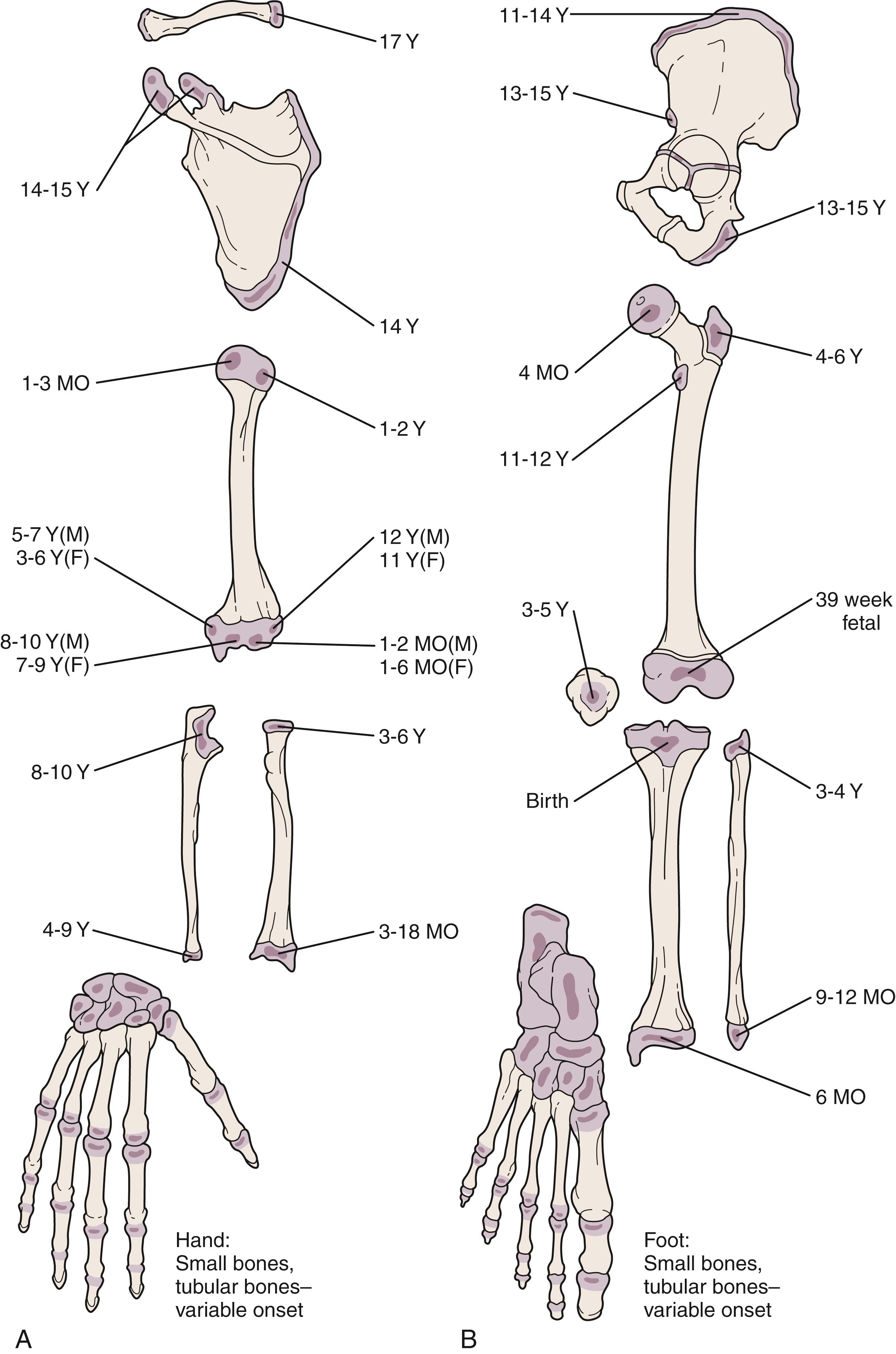
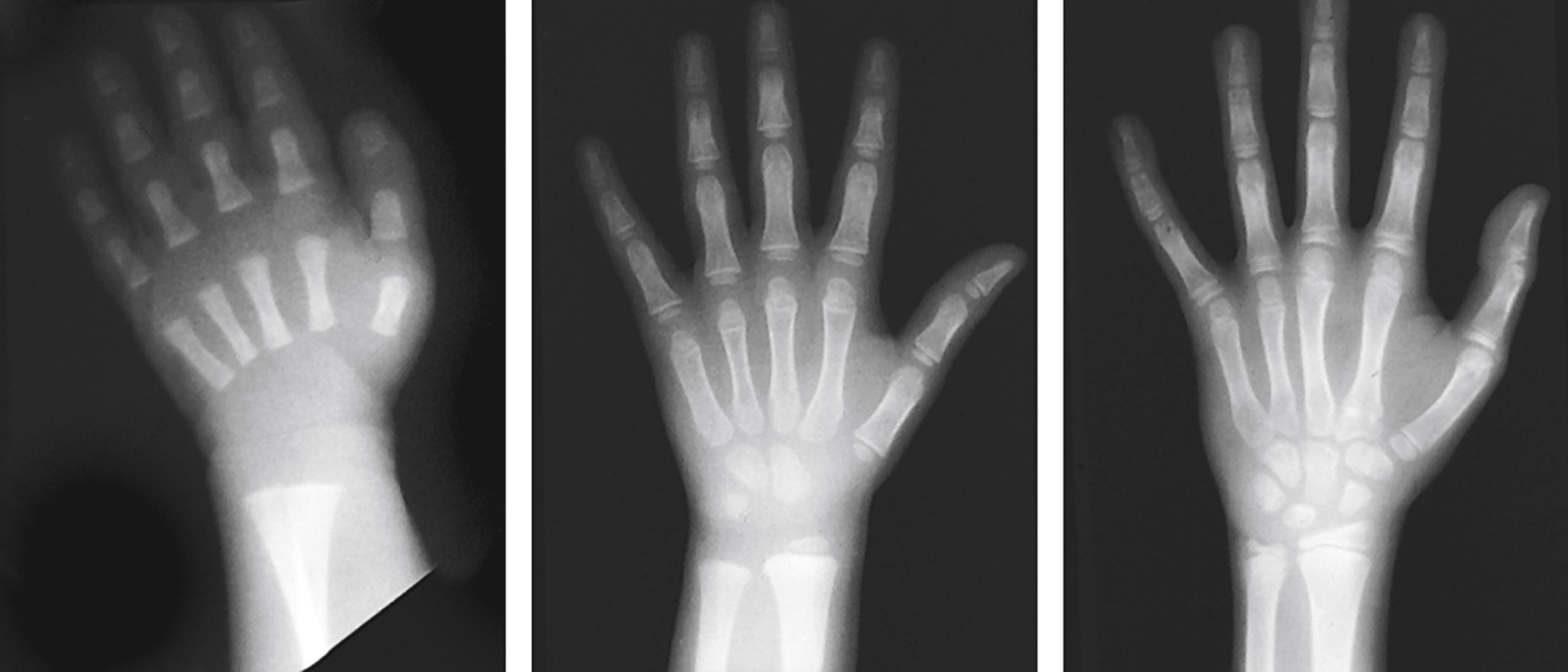
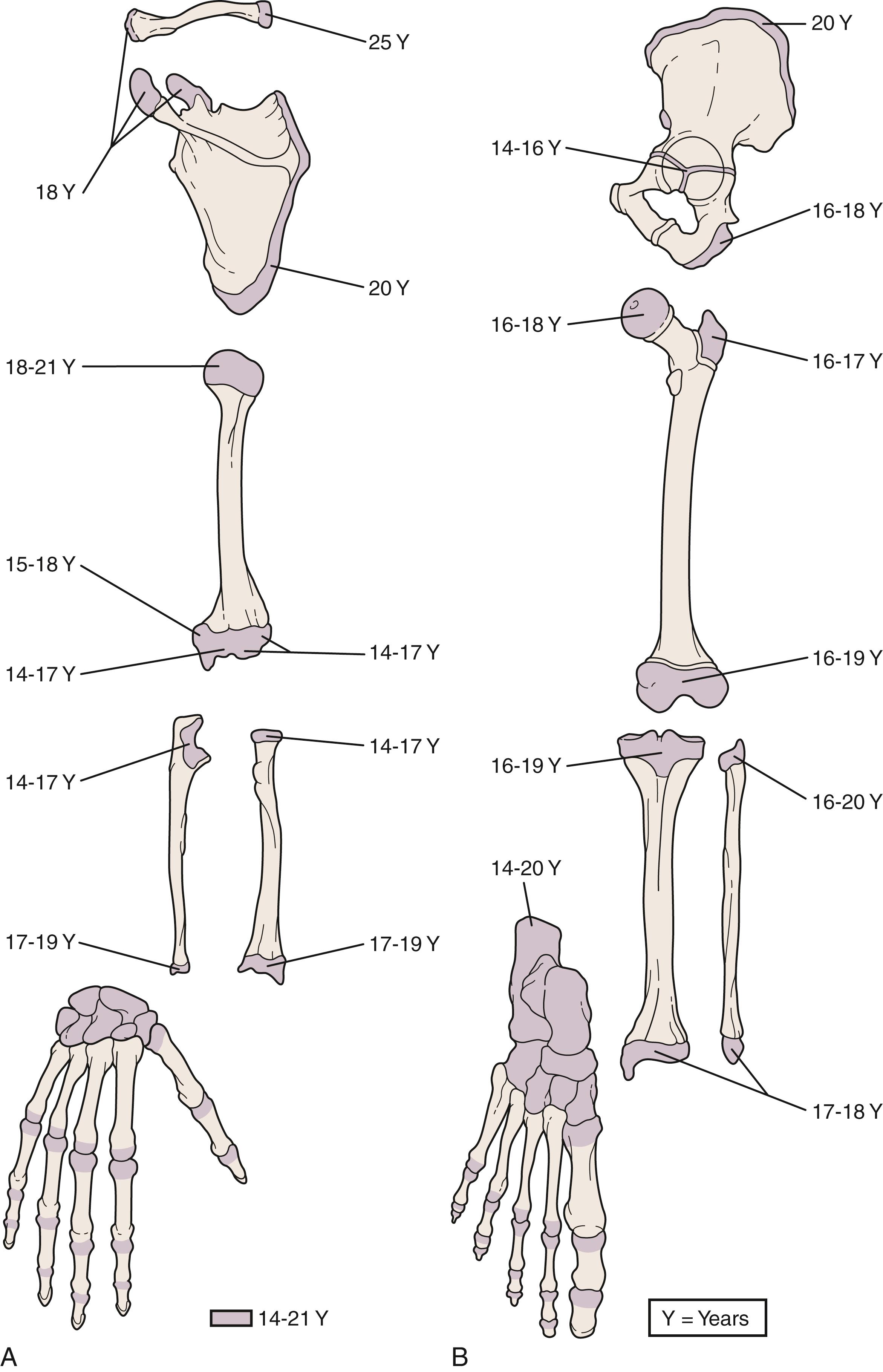
While the growth plate is open, it is weaker to deforming forces than nearby ligaments. As a result, injuries that occur near joints are more likely to result in physeal disruption than in ligamentous tearing. As a result, sprains and dislocations are less common in younger children than in adolescents and adults. Similarly, avulsion fractures at sites where strong muscular attachments join secondary ossification centers are unique to children and adolescents. When there is displacement of a physeal fracture and the fragments are not anatomically reduced, growth disturbances may occur.
The periosteum of a child is much thicker than that of an adult, strips more easily from the bone, and is rarely disrupted completely when the underlying bone is fractured. Because of the immature elements in the rapidly growing skeleton of the child, the bone has more viscoelasticity and can sustain plastic deformation more easily than the adult skeleton.
Fracture patterns in children often differ from those in adults. Their fractures can be considerably more difficult to detect clinically and radiographically, and if their physes are involved, growth disturbances may occur. Children do have advantages, however, in that their actively growing bones heal more rapidly and have a remarkable capacity for remodeling, which is the spontaneous correction through skeletal growth of certain posttraumatic bony deformities.
Finally, numerous genetic, metabolic, endocrine, renal, and inflammatory processes can affect not only growth and ultimate height but also skeletal maturation—delaying it or accelerating it. Comparison of the patient’s actual bone age, as determined by the number of radiographically visible ossification centers, with their chronologic age can help in the diagnosis of these underlying disorders.
Key historical points in the evaluation of both traumatic and atraumatic orthopedic complaints are displayed in Table 22.1 .
| Traumatic Etiology | Nontraumatic Etiology |
|---|---|
|
|
|
|
|
|
|
|
|
|
|
This information helps considerably in narrowing the list of differential diagnostic possibilities. |
| This information helps localize the site or sites of injury and potential injury severity, points to the risk of possible associated injuries, gives clues to the possible existence of underlying disorders that may predispose to injury, and may occasionally raise a suspicion of abuse. |
The orthopedic examination involves a systematic assessment of posture, stance, and gait; the symmetry or asymmetry of paired musculoskeletal structures and their motion; muscle strength and tone; and neurovascular status. In pediatrics, the patient’s developmental level is a major consideration, not only in terms of the interpretation of findings, but also in terms of the manner in which the examination is conducted. Patience and often some degree of creativity are required on the part of the examiner if the patient is very young. Often, information can be gleaned from an initial period of observation of the child’s demeanor and spontaneous activity. This can be assisted by providing age-appropriate toys while the history is being taken and by engaging the patient in play before starting a more formal physical examination. This also helps to alleviate anxiety and gain the child’s trust, enhancing his or her cooperation. After spontaneous activity is observed, the relevant parts of the orthopedic examination are typically done by region.
A complete orthopedic examination that assesses each bone, muscle, joint, tendon, and ligament is lengthy, detailed, and rarely indicated. Even in multiple-trauma victims and patients whose symptoms point toward an underlying systemic disorder, each region is screened and a full assessment done only of those regions where local musculoskeletal abnormalities are found. Similarly, in patients with focal injuries or deformities, the examination can generally be focused on the region involved, with the clinician bearing in mind referral patterns for pain and the maxim that all extremities “begin at the back.” Finally, in performing routine physical examinations on healthy children, after a general screening examination of spontaneous movement, posture, gait, station, and stance, the assessment of the musculoskeletal system is focused on areas at risk for the child’s age (e.g., the hip for dislocation in the neonate, the spine for scoliosis in the preadolescent and adolescent).
In the regional examination, the area of concern is inspected visually for spontaneous movement, guarding, size, swelling, deformity, and the appearance of overlying skin, and when possible findings are compared with its paired structure. After this, the normal and affected sides are gently palpated for warmth, induration, and tenderness. Muscle mass, tone, and reflexes on the affected side are compared with those on the normal, and the presence or absence of spasm is noted. If asymmetry in muscle mass is detected, the circumference is measured bilaterally at a point equidistant from a fixed bony landmark. The child is then asked to move the extremity or is handed objects to get him or her to do so, and active motion is observed. If this appears limited, passive range of motion is tested first on the normal and then on the affected side, taking care not to cause severe pain. Strength is tested against gravity and then against resistance ( Table 22.2 ), being careful to stay within the limits of pain. Sensation and vascular status are also evaluated.
| Grade | Physical Finding |
|---|---|
| 0/5 | No movement seen |
| 1/5 | Muscle can move joint with gravity eliminated |
| 2/5 | Muscle can move joint against gravity but not against added resistance |
| 3/5 | Muscle can move joint against slight resistance |
| 4/5 | Muscle can move joint against moderate added resistance |
| 5/5 | Normal strength |
Joints are further inspected to determine whether there is erythema, obliteration of landmarks that may indicate the presence of effusion, evidence of deformity, and position of comfort. Further evaluation to detect joint effusion is done by pressing on one side of a visible joint while feeling for the protrusion of fluid on the other. The joints are palpated to check for evidence of heat and tenderness, range of motion is assessed, and evidence of pain on motion is determined.
Assessment of ligamentous stability around joints is discussed under specific sections of the regional examination. However, it is important to remember that in cases of acute trauma, especially when deformity or hemarthrosis is evident on initial assessment, tests of ligamentous stability should be deferred, the extremity splinted, and radiographs obtained to check for possible underlying fracture.
With the examiner in front and the patient standing, the sternocleidomastoid muscles, the bony prominences of the clavicles, and the respective heights of the acromioclavicular (AC) joints, nipples, and anterior iliac crests and sides of the chest wall are inspected for symmetry. The patient is then turned and viewed from behind, and the shoulder and scapular height, the muscle bulk of the trapezius muscles, and the height of the posterior iliac crests and of the depressions over the sacroiliac joints are checked for symmetry. Trapezius strength is determined by having the patient shrug his or her shoulders, first against gravity and then against resistance, as the examiner presses down on the shoulders. The muscles supplying the scapula are tested by having the patient press his or her outstretched arms against a wall. Winging of the scapula during this maneuver is suggestive of weakness of the serratus anterior muscle. The line of the spinous processes of the vertebrae is observed for straightness, and the position of the head over the trunk is noted. Normally the head is aligned over the midline of the sacrum.
Next, the sternocleidomastoid and paraspinous muscles of the neck are palpated to assess for bulk, tone, tenderness, and spasm, and the spinous processes of the cervical vertebrae are palpated to assess for tenderness and step-off. In the immobilized trauma patient, these observations are made largely with the patient supine on a backboard and then log-rolled onto his or her side. Importantly, in checking for neck injury, the cervical spine can be cleared clinically if the patient is awake and alert and has no complaint of neck pain, no evidence of tenderness or paraspinous muscle spasm, and no extremely painful injury elsewhere. If the patient’s level of consciousness is not normal or there is a major distracting injury, the cervical spine cannot be cleared, even if radiographic findings are normal because spinal cord injury can be present in the absence of bony abnormalities.
Range of neck motion is assessed by having the patient move his or her head. A normal child can touch his or her chin to the chest, extend the neck to look directly above, and bend laterally to 45 degrees. They are also capable of symmetrical lateral rotation when turning the head from side to side. Strength is tested by applying pressure to the forehead while the patient flexes his or her neck and to the occiput as the patient extends, and by applying resistance to the opposite side of the head as the patient bends and rotates laterally.
Viewed from the side, the normal child has a lordotic curve in the cervical area with a bony prominence at C7, a mild thoracic kyphosis, a lumbar lordosis, and a sacral kyphosis. Each patient is checked for the presence, absence, or accentuation of these curves. The midline of the back is inspected for evidence of abnormal pigmentation and the presence of hemangiomas, nevi, hairy tufts, dimples, masses, or defects, which may be associated with underlying bony or neural anomalies (see Chapter 16 ).
Flexion, extension, rotation, and lateral bending of the thoracolumbar spine are primarily motions of the thoracolumbar junction and the lumbar area. Most children can bend forward to touch their toes, bend laterally 20 to 30 degrees (with the pelvis held stable by the examiner’s hands on the iliac crests), and rotate 20 to 30 degrees in either direction.
Examination of the back for spinal deformity is assisted by the use of the Adams Forward Bend Test ( Fig. 22.4 ). For this, the examiner stands behind the patient, who is then asked to bend forward with arms extended and the palms of the hands together. The surface of the back in the lumbar and thoracic regions is examined for asymmetrical elevation of the paravertebral spinous area, thus indicating a structural rotation of the spine and the possibility of scoliosis (see Fig. 22.4B ). The examiner should also note any evidence of missing spinous processes (step-off) or their deviation from the midline and palpate the paravertebral muscles for spasm and tenderness. Increased kyphosis, especially in the thoracic region, may be detected when viewing the patient from the side (see Fig. 22.4C ), as can lack of reversal of the lumbar lordosis, which may indicate muscle spasm or abnormality of the lumbar spine. Leg length inequality may be evaluated during the upright standing portion of this test (see the Lower Extremity Examination section, later) and, if present, should be corrected with appropriate lifts under the short side in order not to cause a false forward bend test.
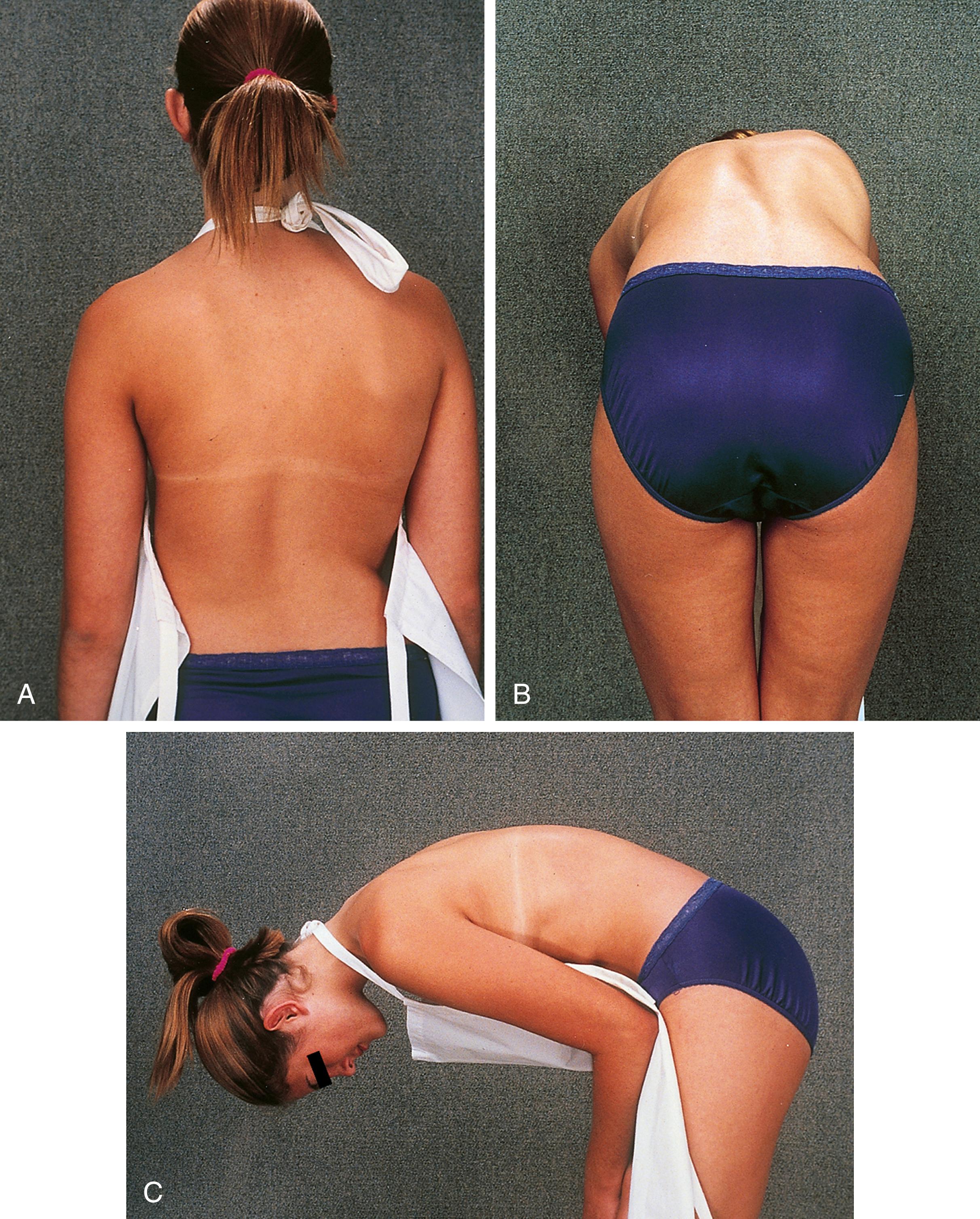
Any examination of the spine must include a neurologic assessment of strength, tone, reflexes, and sensation. The Straight Leg Raising Test ( Fig. 22.5 ) can be helpful in demonstrating nerve root pathology in patients with slipped disks, spinal or paraspinal masses, or inflammatory processes. The test is performed with the patient lying supine on the examining table. The limb to be tested is grasped behind the ankle and elevated passively into hip flexion with the knee fully extended. This maneuver stretches the sciatic nerve as it passes behind the hip joint, and if one of its several roots has been irritated by a protruded disk, mass, or inflammatory process, pain will be felt with only 15 to 30 degrees of hip flexion. Normally the straight leg can be brought to 90 degrees of hip flexion without difficulty.
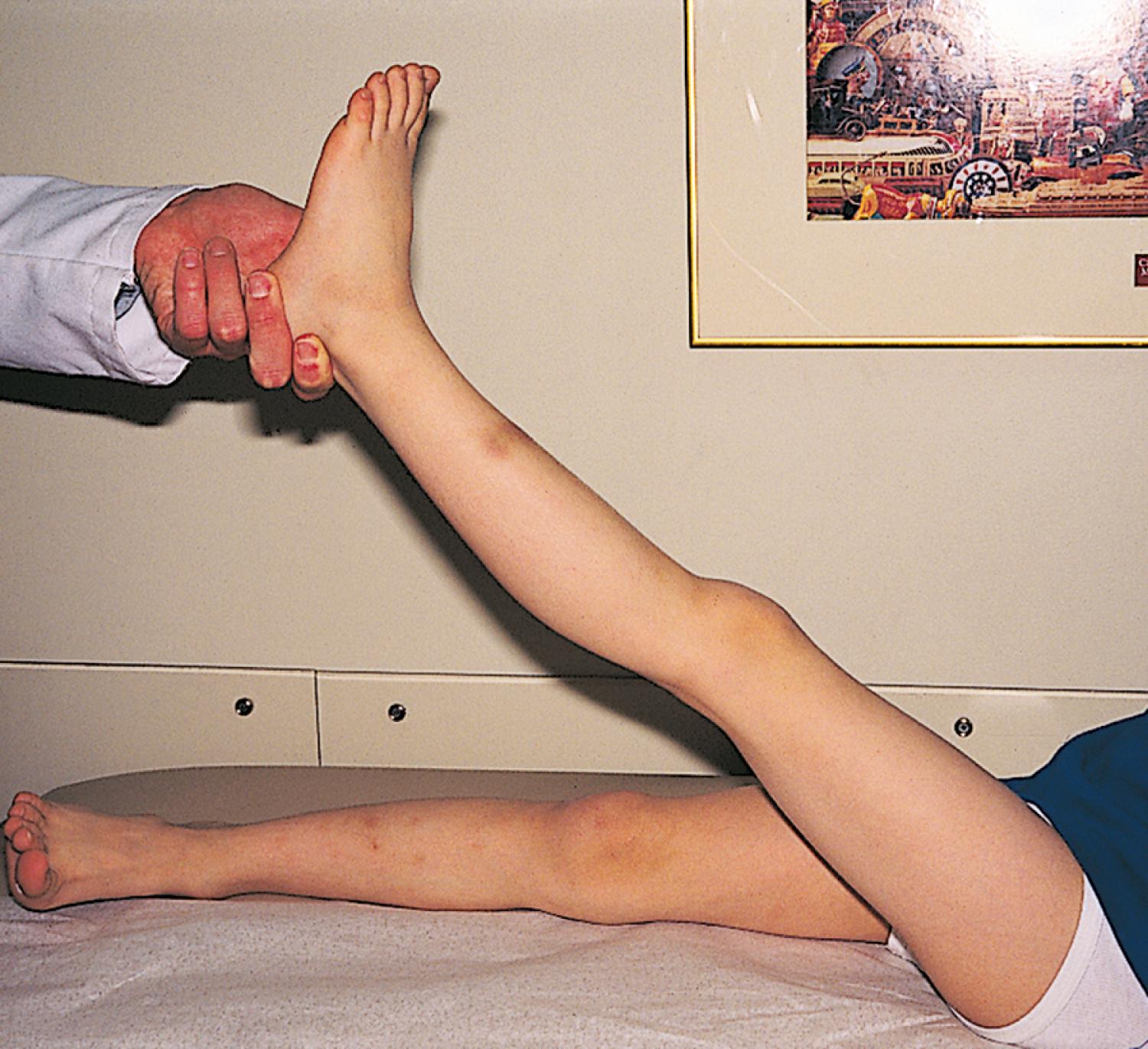
When examining the shoulder, first the position of the upper limbs is observed, at the same time noting whether there is any swelling, asymmetry of height, or visible landmarks and looking for any difference in spontaneous movement. Prominent landmarks that are easily palpable include the acromion process lying laterally and subcutaneously, the clavicle, the spine of the scapula, the coracoid process, and the bicipital groove. Any displacement or tenderness of these structures should be noted. Swelling of the glenohumeral joint capsule and atrophy of the shoulder muscles are best appreciated by viewing from above with the patient seated and by comparison with the normal side.
Assessing range of motion is important because many shoulder problems are manifested by a loss of normal motion. The shoulder is a ball-and-socket joint with six components of movement. Abduction, a function of the deltoid muscle, is tested by having the patient raise the extended, supinated arm up so that the hand is directly above the shoulder (180-degree abduction). To test adduction, the patient is asked to flex his or her shoulder to 20 to 30 degrees and then draw the upper arm diagonally across his or her body (75 degrees is normal). Flexion is assessed by having him or her raise the extended pronated arm up and forward until it is parallel to the floor; extension is tested by having him or her return the arm to the neutral position and then lift the arm up and backward (45 to 60 degrees is normal). To check rotation, the upper arm is held to the side with the elbow flexed to 90 degrees and the child is asked to turn the forearm toward the body (medial) and then out to the side (lateral) (60 to 90 degrees is normal).
In the normal relationship of the extended, supinated forearm to the upper arm, there is 5 to 10 degrees of lateral (valgus) angulation, termed the carrying angle ( Fig. 22.6 ). When this angle is greater than 10 degrees, the deformity is termed cubitus valgus and, when less or reversed, cubitus varus (gunstock deformity). The range of motion of the hinge joint of the elbow has four components: (1) extension, a function of the triceps (normally to 0 degrees); (2) flexion, a function of the biceps (normally to 145 degrees); (3) supination (normally to 90 degrees); and (4) pronation (80 to 90 degrees). The latter two components are tested by having the patient turn the palm up and down respectively, with the elbow flexed.
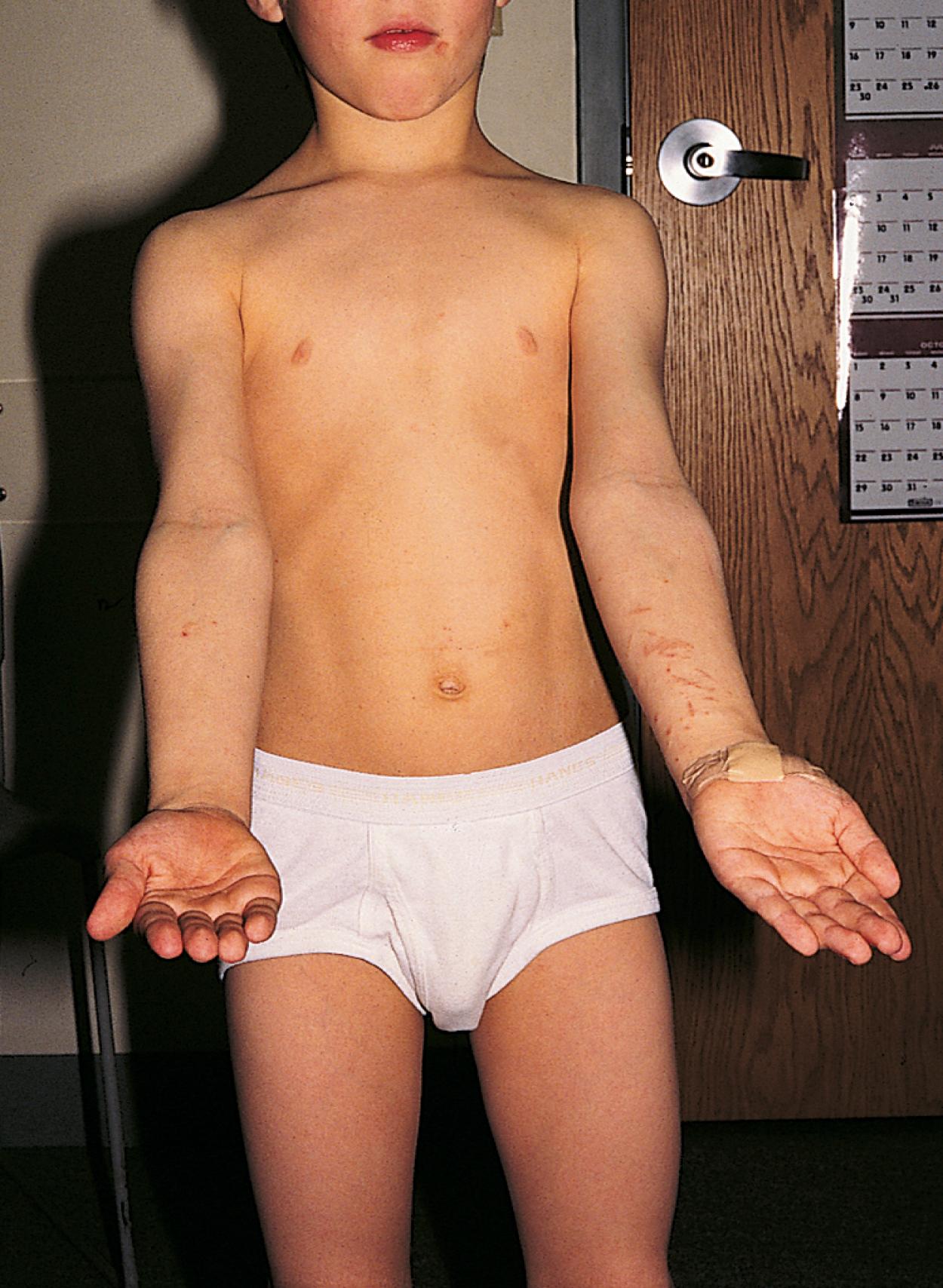
Because of the proximity of the brachial artery and the median, radial, and ulnar nerves to the elbow joint, injuries of the elbow necessitate a careful neurovascular examination.
During examination of the wrist and hand, one should observe skin color, check capillary refill, and palpate the radial and ulnar pulses to assess circulation. Any swelling or edema should be noted, as well as any abnormal posture or position. The presence of intraarticular fluid in the wrist is manifested by swelling and tenderness, especially evident dorsally, and by restriction of wrist motion. Wrist motion has four components: flexion with the hand held down (normally 70 to 80 degrees); extension with the hand held up (normally 70 degrees); and ulnar and radial deviation (normally 25 degrees and 15 to 20 degrees, respectively).
Examination of hand function can be particularly challenging in the young. Observation of the position at rest (normally a loose fist with all the fingers pointing in the same direction and with the same degree of flexion) and of use during play is often helpful. Having the parent perform various hand and finger motions while trying to get the child to imitate these can be helpful in some cases. Handing the child a small object or a thin piece of paper may suffice for assessing opposition of thumb to fingers, tested in the older child by having them touch the tip of the thumb to the tip of the little finger. Normal ranges of motion in the hand are 90 degrees of flexion and 45 degrees of extension for the metacarpophalangeal joints, full extension and 100 degrees of flexion for the proximal interphalangeal (PIP) joints, and full extension and 90 degrees of flexion for the distal interphalangeal joints.
Because the bones of the hand are subcutaneous, displaced fractures and dislocations can be readily evident on inspection. Laceration or rupture of the tendons is common because of their superficial location. Those involving flexor tendons result in extensor tendon overpull ( Fig. 22.7 ), with the affected digit lying in greater extension than its neighbors at rest. Conversely, extensor tendon lacerations result in flexor muscle overpull, with the opposite result.
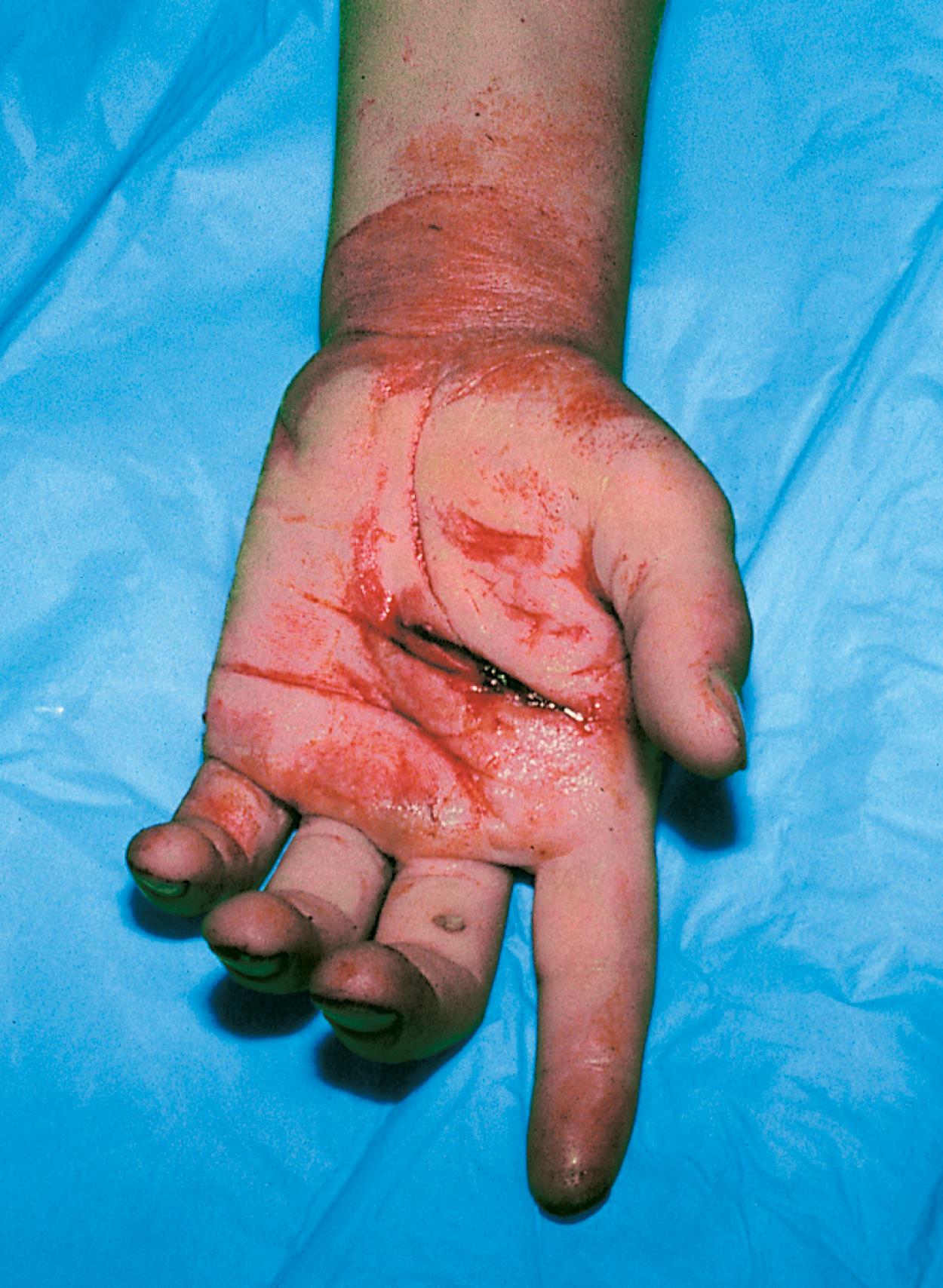
Functional testing of the tendons and intrinsic muscles of the hand is generally possible in older children. They can be asked to extend the fingers at the metacarpophalangeal joints and each interphalangeal joint. Function of the flexor digitorum profundus muscle is tested by holding the PIP joint extended while the patient flexes the tip of the finger. To test the superficialis flexor tendon, adjacent distal interphalangeal joints are held in extension, and the patient is asked to flex the finger being tested at the PIP joint. The intrinsic muscles of the hand are evaluated by having the child adduct and abduct the fingers toward and away from the middle finger. Sensation is best tested using two-point discrimination and pinprick in older children and by touch in very young children.
Muscle strength in the upper extremity is largely tested during assessment of range of motion of the joints, with and without resistance. Signs of neural dysfunction with injury of the upper extremity are listed in Table 22.3 .
| Nerve | Sign |
|---|---|
| Radial | ↓ Strength of wrist and finger extensors |
| ↓ Sensation in web space between thumb and index finger, dorsum of hand to PIP joints, and radial aspect of ring finger | |
| Ulnar | ↓ Strength of wrist flexion and adduction |
| ↓ Strength of finger spread | |
| ↓ Sensation over ulnar aspect of palm and dorsum of hand, little finger, and ulnar aspect of ring finger | |
| Median | ↓ Strength of wrist flexion and abduction |
| ↓ Strength of flexion of PIP joints | |
| ↓ Strength of opposition of thumb to base of little finger | |
| ↓ Sensation over radial aspect of palm, thumb, index, and long fingers | |
| Anterior interosseous | ↓ Strength of flexion of the distal interphalangeal joints of the index finger and thumb |
Examination of the hip begins by assessing gait and stance, checking the latter to see if the anterior superior and posterior superior iliac spines and the greater trochanters are level. If not, a leg-length discrepancy should be suspected and leg length measured. Total length is measured from the bottom of the anterior superior iliac spine to the medial malleolus of the ankle with the patient supine. If inequality is found, the knees are flexed to 90 degrees with the feet flat on the examination table. If, as the examiner looks from the foot of the examination table, one knee appears higher than the other, the tibias are unequal in length; if one knee is anterior to the other when viewed from the side, the discrepancy involves the femurs. If total leg lengths are equal, the inequality apparent when the patient is standing may be due to pelvic obliquity or flexion contracture of the hip. The latter may also be associated with a compensatory accentuation of lumbar lordosis.
The thighs are checked next for symmetry and signs of atrophy. If atrophy is found, circumference should be measured and compared at a fixed point below the greater trochanters.
Because the hip lies deep and is surrounded by muscles, direct inspection is impossible and palpation is of limited value (although the femoral triangle, greater trochanter, and posterior aspect should be palpated to check for tenderness). As a result, assessment of the position of comfort (abduction and external rotation are seen with effusion, hemarthrosis, and fracture; see Figs. 22.15C and 22.91B ), weight bearing, range of motion, and pain on motion are particularly important (for hip examination in the neonate, see the Developmental Dislocation of the Hip section).
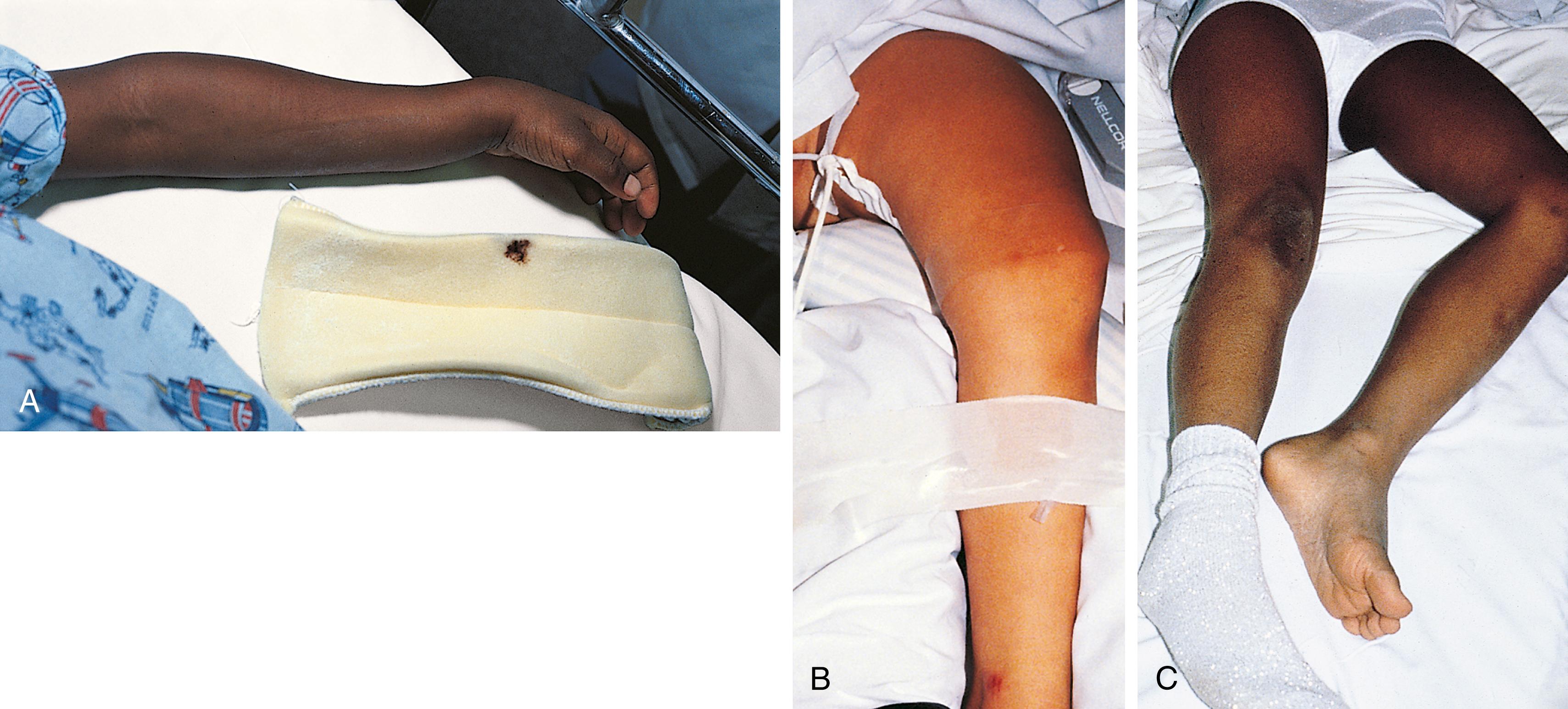
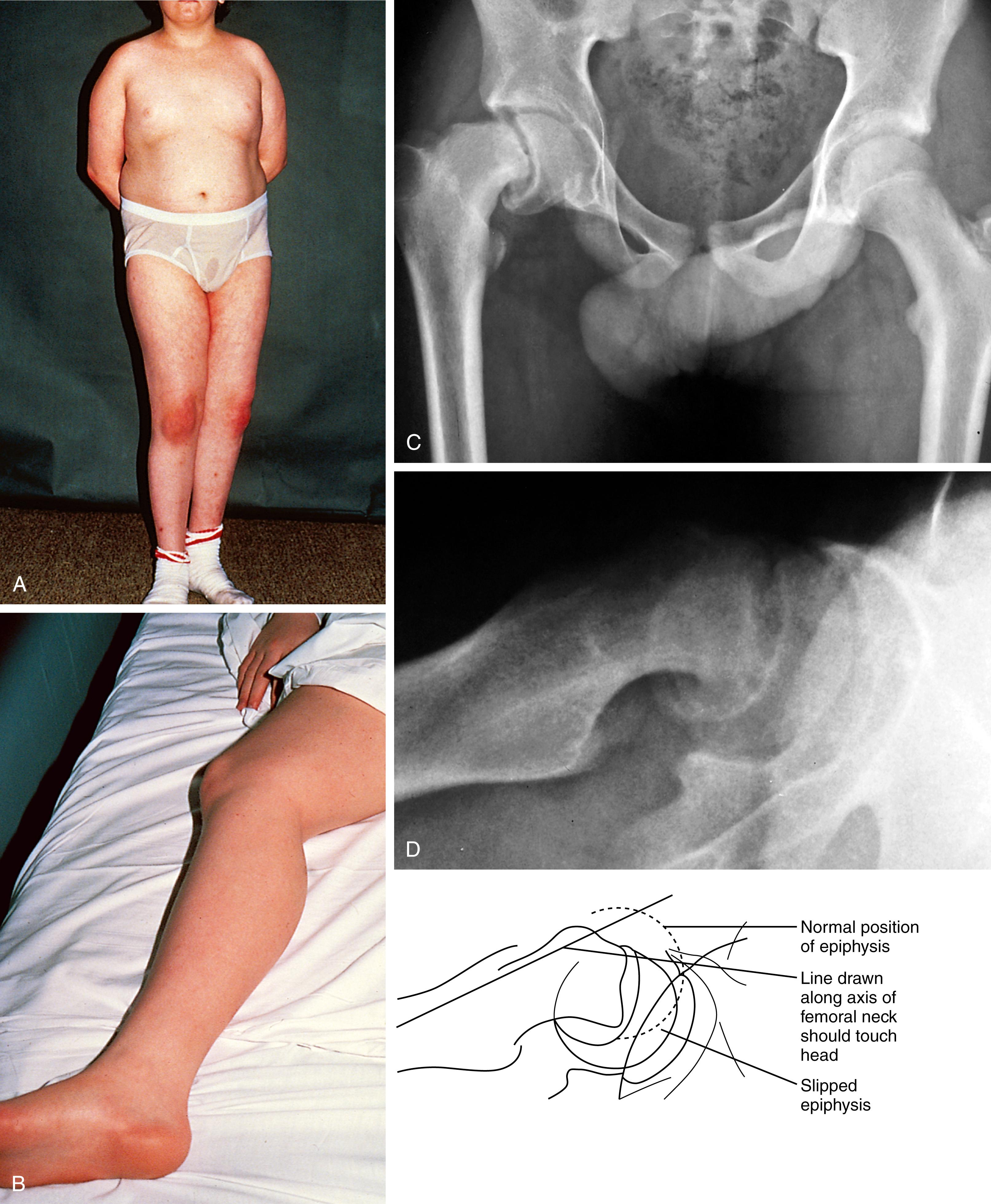
In evaluating range of motion of the hip, care must be taken to distinguish true hip motion from that occurring in combination with pelvic rotation or trunk flexion. The range of hip flexion is normally about 120 degrees. It is tested with the child lying supine. The hip to be tested is passively flexed while the contralateral hip and pelvis are observed or stabilized by one hand. The limit of flexion is reached when movement of the contralateral pelvis is noted. Alternatively, both hips can be flexed simultaneously to stabilize the pelvis and eliminate truncal flexion. The Thomas test is performed by flexing both hips so that the thighs touch the abdomen. Then one is held in place, thereby eliminating lumbar lordosis and movement of the lumbosacral joint, and the patient is asked to extend the hip to be tested. Normally, he or she should be able to extend the hip to 0 degrees of flexion ( Fig. 22.8A ). Failure to do this indicates the presence of a hip flexion contracture, which is a positive result on the Thomas test (see Fig. 22.8B ). Next, the knee and thigh are held with the hip and knee flexed to 90 degrees, and internal and external rotation are tested and recorded in degrees. Abduction and adduction are also checked with the hip flexed to 90 degrees. While the examiner places the thumb and index finger of one hand over the patient’s pelvis, attempting to span the distance between the anterior superior iliac spines, the hip to be tested is abducted and then adducted. The limit is determined by the point at which the pelvis begins to move (normally 45 degrees of abduction and 30 degrees of adduction). Extension is tested with the patient prone by having him or her lift the leg up from the table (normal, 20 to 30 degrees). Internal and external rotation are also tested with the patient prone and the hip and leg in extension.
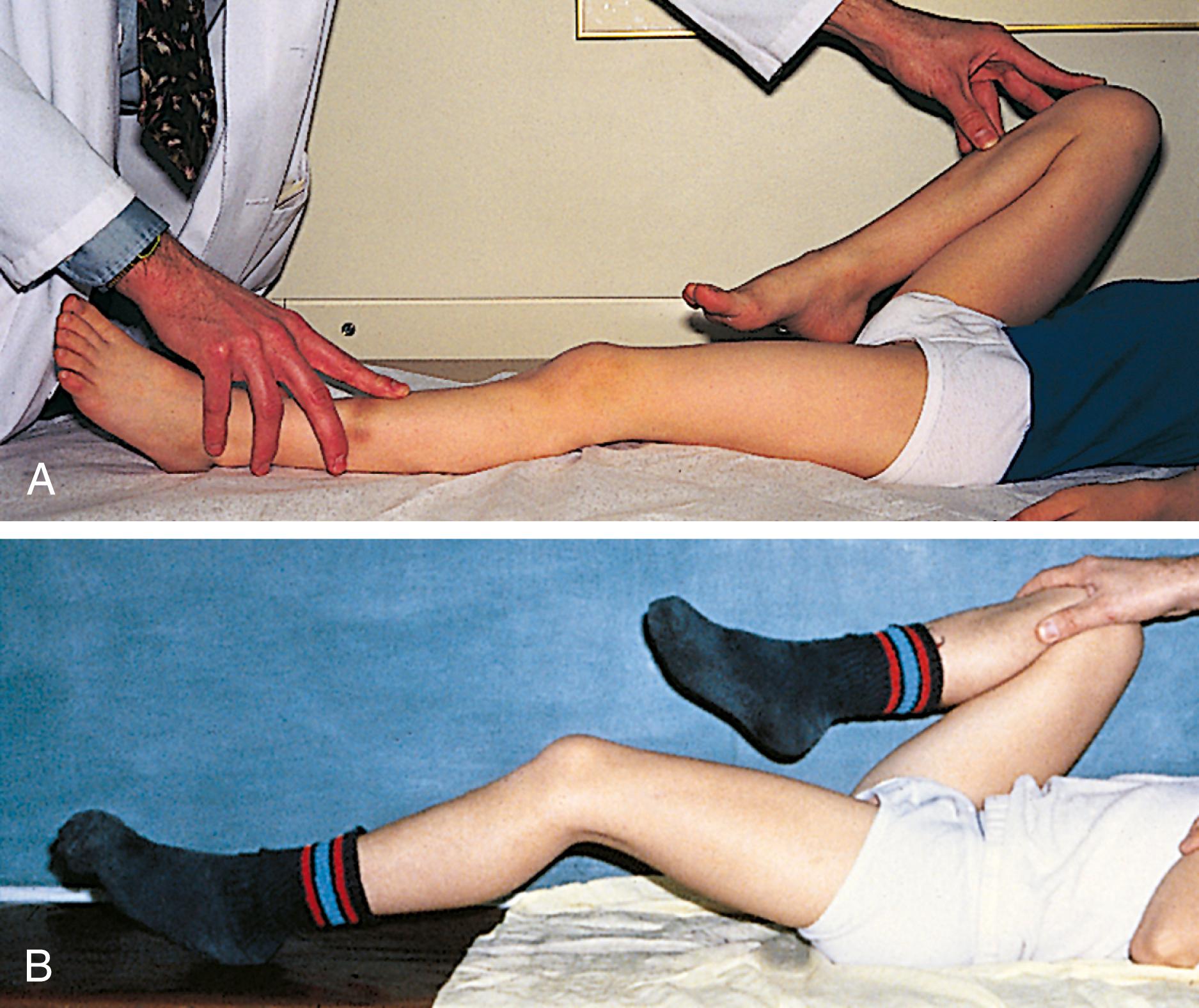
When hip abductor weakness is suspected on the basis of the finding of a gait abnormality, the Trendelenburg test ( Fig. 22.9 ) is performed. This involves having the child stand and asking him or her to lift one leg up. Normally, the pelvis should rise slightly on the side of the leg that is lifted. If instead it drops, abductor weakness is present on the opposite side, and the Trendelenburg test is positive.
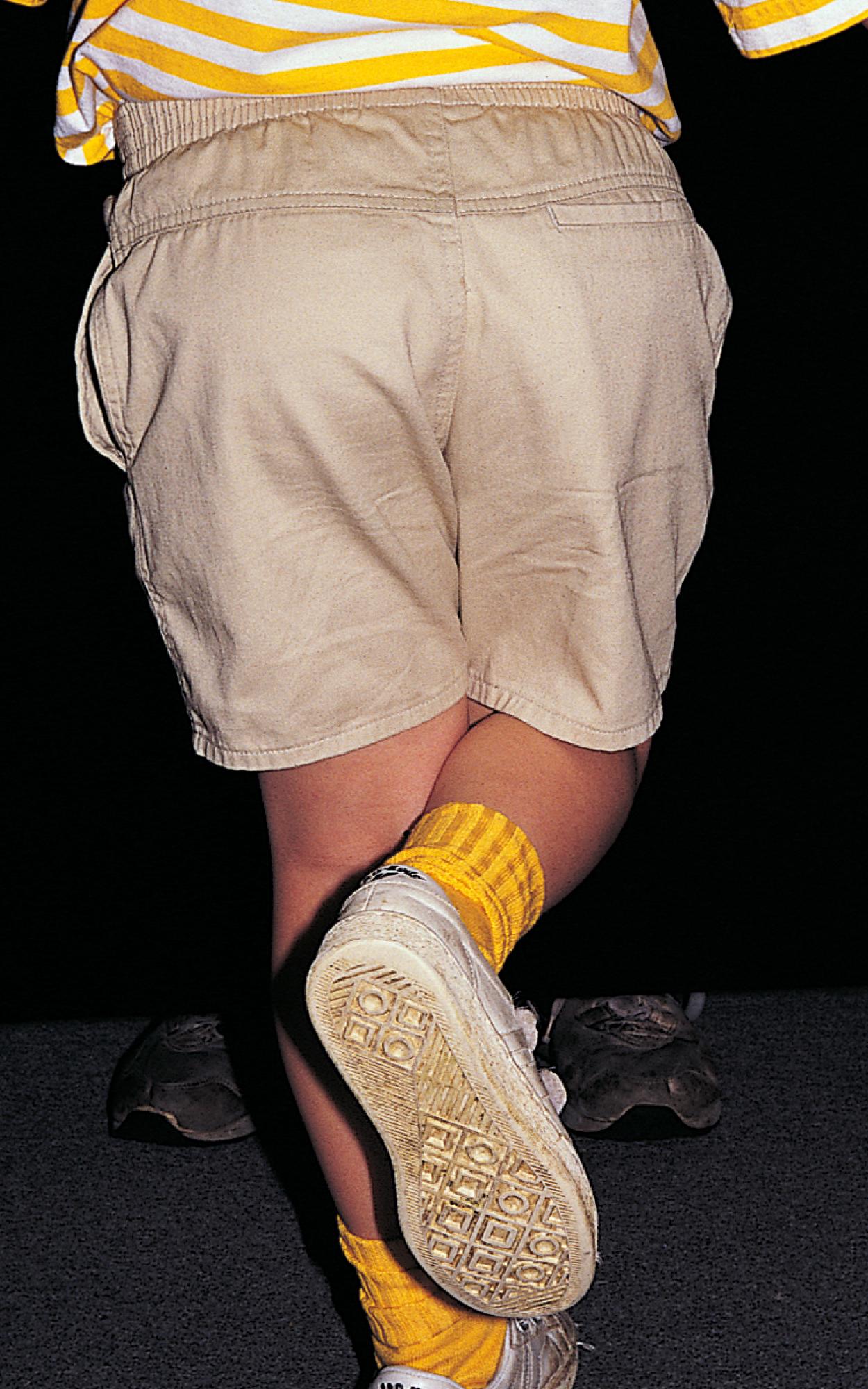
Knee pain is a common reason for seeking orthopedic care, and is often referred from the hip; thus any patient presenting with knee pain should always be examined for possible limitation of hip motion or pain on motion of the hip.
The knee examination begins with the examiner viewing the joint from the front, side, and back, looking for differences in contour, swelling or masses, and changes in overlying skin. From the front, the knee is inspected for valgus (lower leg points away from the midline) or varus (lower leg deviates toward the midline) deformity and for evidence of effusion, manifested by obliteration of the normal depressions around the patella or by generalized swelling. In viewing the knee from its lateral aspect, the examiner looks for incomplete extension resulting from flexion contracture or excess hyperextension (recurvatum deformity), as well as for symmetry of the tibial tuberosities. From the rear, the popliteal fossae are checked for symmetry and evidence of swelling. The thighs are also observed for comparative size and contour.
The knees are palpated to assess warmth and check for tenderness along the medial and lateral joint lines, the medial and collateral ligaments, the patella and its supporting ligaments, the femoral and tibial condyles, and the tibial tubercles. Palpation is easier with the knee flexed because the skeletal landmarks are more readily seen and felt, and the muscles, tendons, and ligaments are relaxed in this position.
When there is evidence of a marked effusion, landmarks are obscured and the patella is readily ballotable. This is seen with intraarticular hemorrhage, arthritis, and synovitis, and range of motion is usually significantly limited. If landmarks are only mildly obscured (suggestive of a mild joint effusion or fluid collection in the bursae), pressure should be applied over the suprapatellar pouch with the thumb and index finger of one hand, milking down any fluid present while simultaneously pushing the patella up toward the femoral condyles with the other hand ( Fig. 22.10 ). If fluid is present, the patella is ballotable, and a palpable click is noted as the patella strikes the front of the femur.
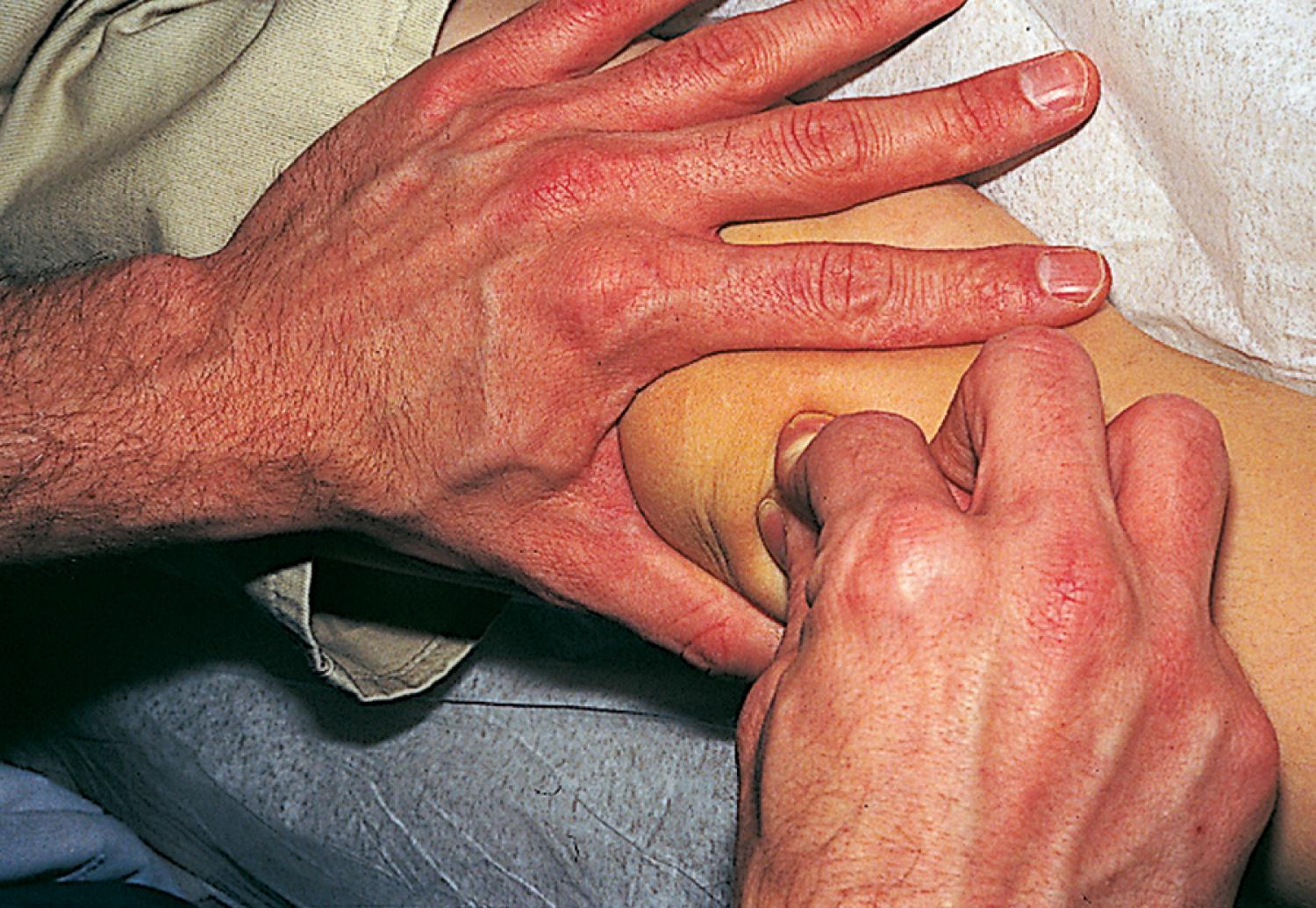
The knee is primarily a hinge joint and is normally capable of 130 to 140 degrees of flexion and 5 degrees of hyperextension. However, it can also rotate approximately 10 degrees internally and externally, and this involves rotation of the tibia on the femur. Flexion is tested with the patient either sitting or lying prone. To test extension, the examiner can have the patient either sit and try to straighten the leg to 0 degrees of flexion or try to lift the straightened leg from the examination table while lying supine. Rotation is assessed by turning the foot medially and then laterally with the knee flexed.
With the knees flexed to 80 to 90 degrees, the patellas should face forward when viewed from the front and be located squarely at the ends of the femurs when seen from the side. The apprehension test ( Fig. 22.11 ) is performed to check for a subluxating or dislocating patella. With the patient sitting, the examiner supports the lower leg and holds the knee flexed to 30 degrees. The patella is then gently pushed laterally. Any abnormal amount of lateral displacement, pain, or apprehension in response to this maneuver indicates a positive test.
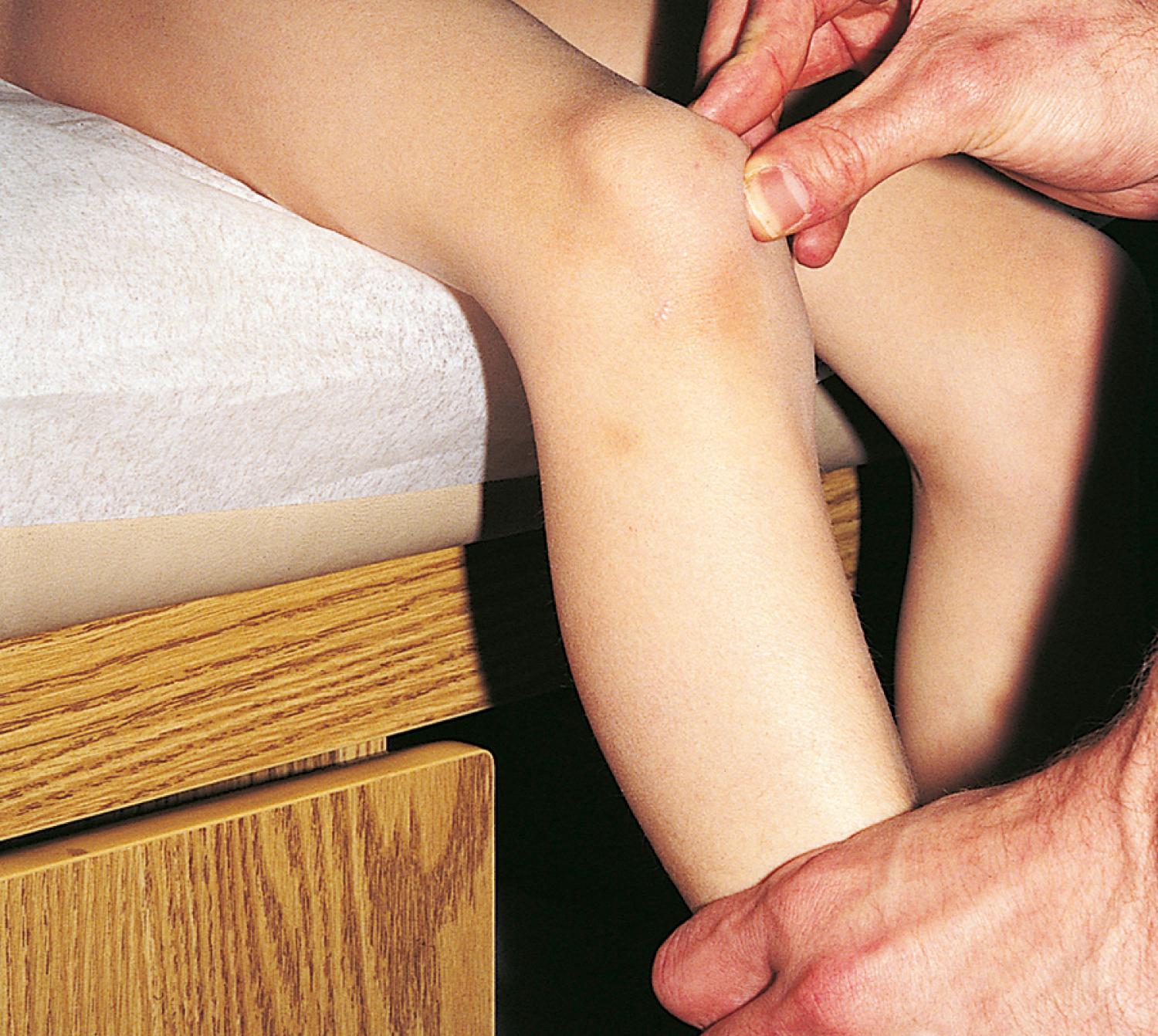
Ligamentous stability of the knee should be assessed in the mediolateral and anteroposterior planes. In patients with acute injuries, especially those involving significant pain and swelling, this should be deferred until radiographs have been obtained to check for associated fractures.
The abduction/adduction stress test is used to determine the degree of stability of the medial and lateral collateral ligaments. With the supine patient’s thigh moved to the side of the examination table and the knee flexed to 30 degrees, the examiner holds the distal thigh in one hand while grasping the inside of the lower leg with the other. To test the medial collaterals, the examiner applies valgus stress by pressing medially against the distal thigh with the upper hand while gently abducting the lower leg. To check the lateral collaterals, the examiner applies varus stress by pressing laterally on the inside of the distal thigh while gently adducting the lower leg. Normally the joint line should open no more than 1 cm on either side.
Anteroposterior ligamentous stability is provided by the anterior and posterior cruciate ligaments of the knee. They are tested by the anterior and posterior drawer and Lachman tests. The former are performed with the patient supine; the hip and knee flexed to 45 and 90 degrees, respectively; and the foot planted on the examining table, stabilized by the examiner’s thigh or buttock. The examiner then grasps the proximal tibia with his or her fingers behind the knee and the thumbs over the anterior joint line and gently pulls and pushes ( Fig. 22.12 ). In a positive anterior drawer test, the tibia moves forward more than 0.5 to 1 cm, indicating instability of the anterior cruciate ligament. Movement backward more than 0.5 to 1 cm indicates instability of the posterior cruciate ligament. In the Lachman test ( Fig. 22.13 ) for anterior cruciate tears, the knee is flexed to 15 degrees. The examiner grasps the distal femur with one hand and the proximal tibia with the other. The thumb of the lower hand is placed on the joint line, and the femur is pushed backward as the tibia is pulled forward. Abnormal anterior displacement of the tibia on the femur can be seen and felt if instability is present. The amount of excursion is estimated in millimeters, and the end point is recorded as soft or firm.
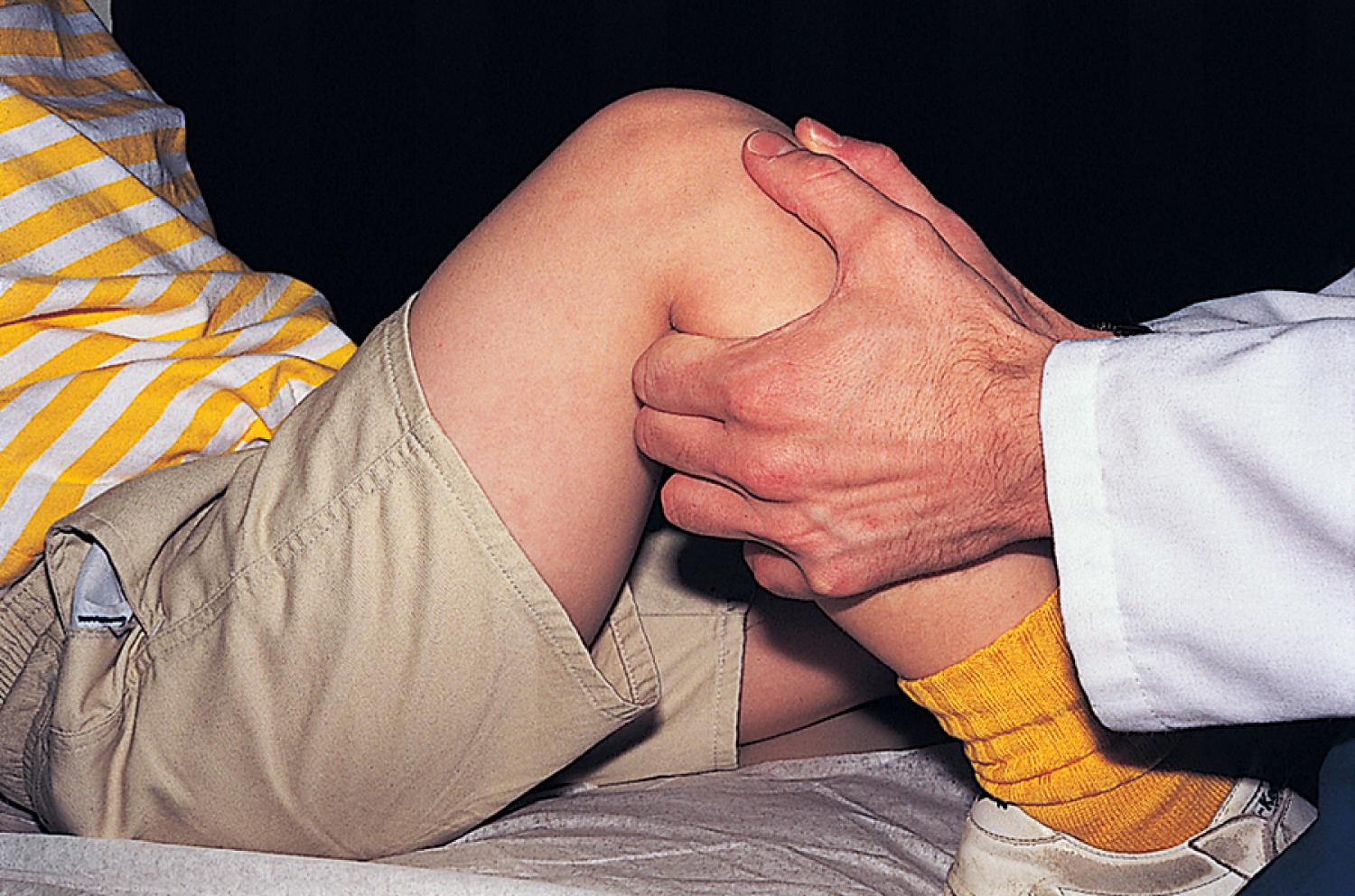
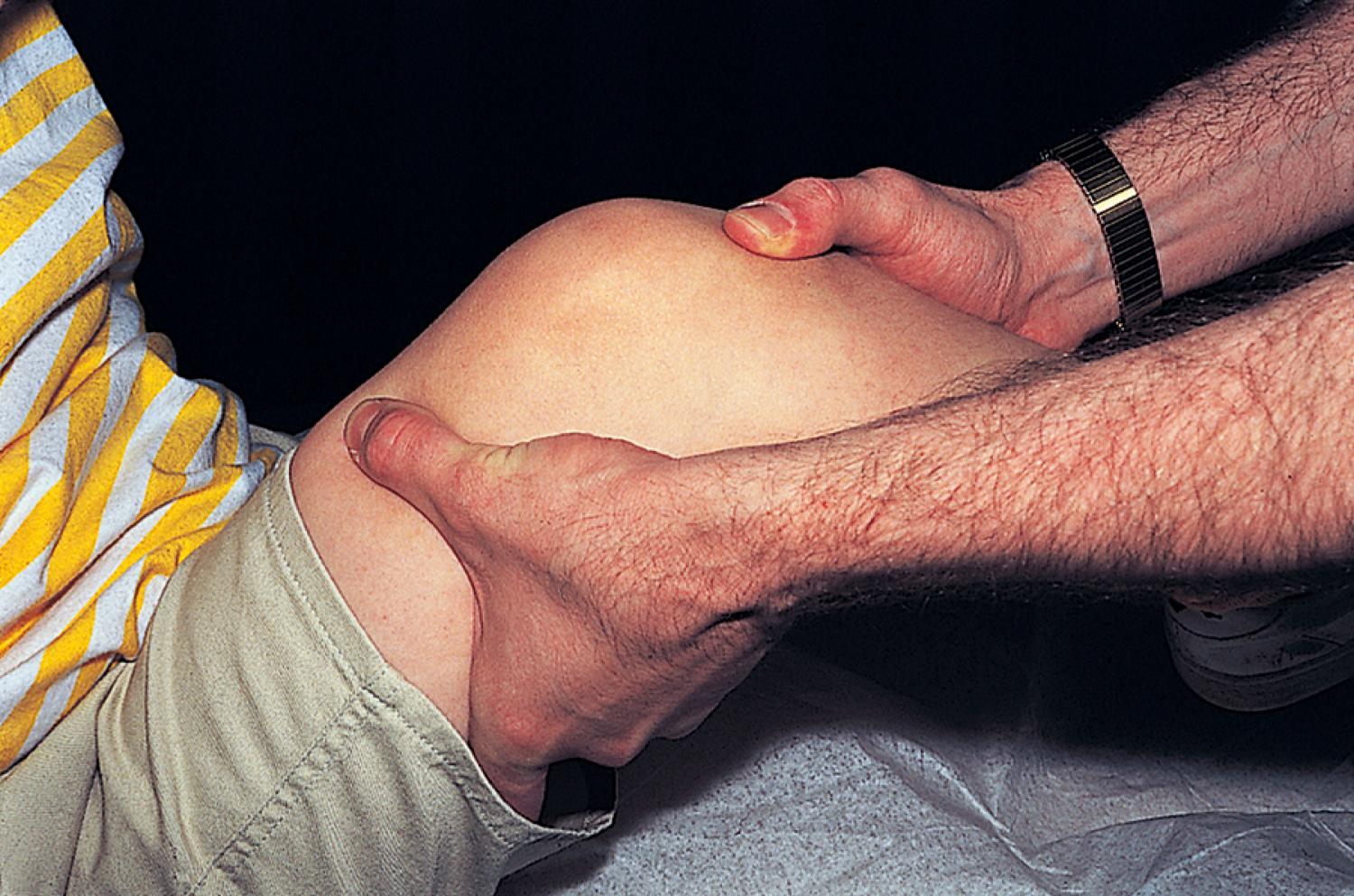
Examination of the ankle begins with inspection for evidence of deformity, swelling, change in color of overlying skin, and abnormal position (especially with weight bearing). Palpation is performed to detect warmth and to localize tenderness. In the neutral position, the long axis of the foot should be at 90 degrees to the long axis of the tibia. Normally a child can dorsiflex 20 degrees and plantar flex 30 to 50 degrees from the neutral position, as well as invert and evert approximately 5 degrees. Dorsiflexion and plantar flexion can be checked by observing passive and active motion, with and without resistance, but are most easily tested by having the ambulating child walk on his or her heels and toes, respectively. Similarly, inversion is tested by having him or her walk on the outside of the feet and eversion by having him or her walk on the medial sides.
Tests for ligamentous instability can be important after severe ankle sprains. The anterior drawer test is used to assess the stability of the anterior talofibular ligament. With the patient’s legs dangling over the side of the examination table and the foot in a few degrees of plantar flexion, the examiner grasps the anterior aspect of the distal tibia with one hand while holding the calcaneus cupped in the palm of the other. The calcaneus is then drawn anteriorly while the tibia is pushed posteriorly. Normally there should be no movement, but with instability of the anterior talofibular ligament, the talus slides anteriorly. Lateral instability is seen only with major tears of the anterior talofibular and calcaneofibular ligaments, occasionally accompanied by tears of the posterior talofibular ligament, and is tested by inverting the calcaneus with one hand while grasping the distal tibia with the other. When instability is present, the talus gaps and rocks in the ankle mortise. Medial instability is exceptionally rare because of the strength of the fan-shaped deltoid ligament. To test for medial instability, the tibia and calcaneus are held in the same manner as they are in testing lateral instability, but the foot is everted instead. Gross gaping of the ankle mortise is felt when there is a major tear.
Between the onset of walking and 3 years old, children tend to have a wide-based gait and toddlers often hold their arms out to the side to assist balance. By 3 years old, children achieve a normal smooth and rhythmic heel-to-toe gait, consisting of two main phases: stance and swing. The stance phase begins when the heel strikes the ground, bears all the weight, and progresses to foot flat, midstance, and push-off as weight is transferred from the heel to the metatarsal heads. The swing phase starts with acceleration after push-off and progresses through mid-swing to deceleration just before heel strike. During the swing phase, as the leg moves forward, so does the opposite arm. Because stance occupies 60% of the time and weight is borne in this phase, most gait disorders are more evident during the stance phase than during the swing phase. Normally the distance between the two heels (width of the base) is between 5 and 10 cm, the pelvis and trunk shift laterally about 2.5 cm from stance to stance, the center of gravity rises and falls no more than 5 cm, and the pelvis rotates forward about 40 degrees during swing.
Gait is best observed by having the patient walk back and forth in a hall or in a room with a mirror at one end. As the patient walks, the examiner focuses first on overall movement and then on the motion of the pelvis, hips, thighs, knees, lower legs, ankles, and feet in succession, both coming and going. In doing so, he or she looks for the pattern of heel-to-toe motion, for shortening of the stance phase, for evidence of limitation of joint motion or weakness, and for positional changes of the extremities.
Most acute and many chronic disturbances of gait in childhood are caused by pain. Others stem from weakness or spasticity caused by neurologic or muscular disorders, from leg length inequality, or from deformity. Important historical points are the time of onset of the abnormal gait and the circumstances surrounding it; the duration; whether the abnormal gait is constant or intermittent and, if intermittent, the time of day it is most apparent (morning gait disturbance is more associated with juvenile idiopathic arthritis; evening, with fatigability associated with neuromuscular disorders); and its relation to activity or exercise, including its effect on running or climbing stairs. The examiner should note any associated pain and its location, bearing in mind referral patterns (low back to buttocks and lateral thigh; hip to groin, medial thigh, knee, and sometimes buttock) and attempting to determine whether the pain is constant (suggestive of tumor or infection) or intermittent.
An antalgic gait is a limp caused by pain on weight bearing that results in shortening of the stance phase on the affected side. It can be due to pain referred from the back or pain anywhere in the lower extremity. Causes include traumatic or pathologic fractures, infection, inflammatory disorders, malignancy, tight shoes, or a lesion on the sole of the foot. Careful physical examination combined with a complete history usually enables localization of the problem.
Patients with leg length inequality manifest depression of the trunk and pelvis during the stance phase on the shorter leg. Some children try to compensate for the leg length inequality by toe-walking on the shorter extremity.
Patients with limited hip motion compensate by thrusting the pelvis and trunk forward in the swing phase. When knee flexion is limited, children tend to hike up the pelvis on the involved side during the swing phase and circumduct the leg to clear the foot from the floor. A circumduction gait can also be related to a painful condition involving the ankle or a limitation of ankle motion. By circumducting the leg laterally during swing phase, the patient reduces the need for ankle motion.
Patients with weakness of the hip abductors (gluteus medius muscle) have a Trendelenburg gait. Because they are unable to maintain a level pelvis and linear progression of their center of gravity, their pelvis tilts toward the unsupported side and their shoulder lurches toward the weak side during stance phase to maintain their center of gravity over the foot. Patients with weakness of the gluteus maximus (seen most commonly in children with Duchenne muscular dystrophy) have to hyperextend their trunk and pelvis to maintain their center of gravity posterior to the hip joint (see Chapter 16 ). Proximal muscle weakness may also be demonstrated by observing a child getting up from the floor unassisted. A Gower sign indicates weak hip extensors and abductors, necessitating that the patient use his arms to assist in standing by placing his hands on his anterior thighs and pushing up, progressively moving his hands upward along the thighs until erect posture is achieved (see Chapter 16 ). Children with weakness of the quadriceps femoris muscle may have a relatively normal gait on level ground but difficulty climbing stairs. Weakness of the dorsiflexors of the foot results in foot drop and a steppage gait. Because the foot hangs down during the swing phase, the patient must lift the knee higher than usual to help the foot clear the floor and the forefoot tends to slap the floor on impact because smooth deceleration of the foot cannot be controlled. When the plantar flexors are weak, the patient is unable to push off at the end of the stance phase, and so the heel and forefoot come off the floor at the same time.
An equine gait, characterized by toe-walking or a toe-to-heel sequence during the stance phase, is seen in children with heel cord contracture and limited dorsiflexion. It is usually indicative of an underlying neurologic problem with spasticity. Patients with spastic cerebral palsy who are able to ambulate often manifest a stiff-legged scissors gait, in which one foot crosses over the other during the swing phase. Vestibular or cerebellar dysfunction or generalized weakness tends to result in a wide-based ataxic gait because of abnormal balance. Absence of the normal arm swing with walking is seen in patients with paresis or cerebellar disease; posturing of upper extremities may become more obvious with running.
The angular difference between the long axis of the foot and the forward line of progression during walking is called the foot progression angle. A minus value is assigned to in-toeing; a plus value is assigned to out-toeing. The normal range varies from 5 to 10 degrees to 10 to 20 degrees, respectively. The remaining rotational profile of the lower extremities can be examined with the patient in the prone position ( Fig. 22.14 ). The foot axis can be determined by a line marked from the middle of the heel on the plantar surface to the lateral side of the second toe (see Fig. 22.14A ). The hip excursion is the difference between the angular measure of the maximal prone internal rotation (see Fig. 22.14B ) and that for external rotation (see Fig. 22.14C ), and in the young child is usually negative, representing more internal rotation than external rotation. In the adolescent and adult, usually there is more external rotation, or a positive hip excursion angle. Finally, the axis of the tibia and fibula can be determined by looking down the lower extremity in the prone knee-flexed position and comparing the axis of the plane of motion of the knee (see Fig. 22.14D ) with the transmalleolar axis (see Fig. 22.14E ) estimated by palpating the malleoli. The normal axis is 15 to 25 degrees externally rotated.
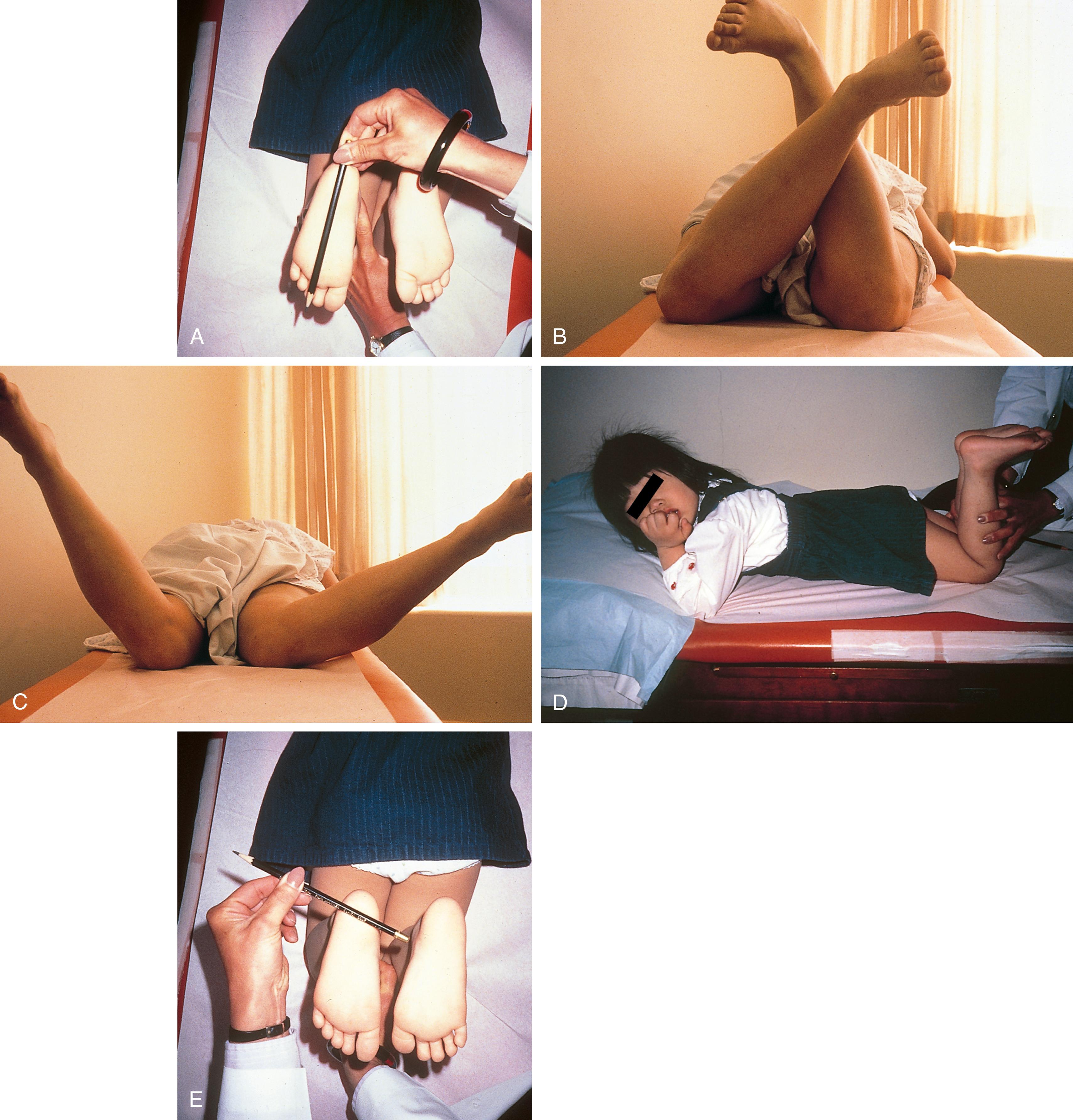
Femoral anteversion, internal tibial torsion, and metatarsus adductus are common causes of excessive in-toeing, or pigeon toe, and femoral eversion and external tibial torsion are common causes of out-toeing, or slew foot (see the Disorders of the Lower Extremity section, later).
Musculoskeletal injuries are common in childhood and adolescence, whether seen in isolation or as part of multisystem trauma. Although the management of life-threatening injuries to the airway, circulation, and central nervous system (CNS) must take precedence over treatment of accompanying musculoskeletal injuries in cases of multiple traumas, it must be kept in mind that fractures can result in significant blood loss. This is particularly true of pelvic and femoral fractures. Furthermore, prompt attention must be given to assessment of the status of neurovascular structures distal to obvious fractures because failure to recognize compromise may result in permanent loss of function.
Pain and fear in the young child combine to complicate the appropriate diagnosis of skeletal trauma. Many children are too young to give a firsthand history, and the cooperation of toddlers is often limited. A calm, empathetic manner is necessary to allay their fears. Taking a thorough history before any physical assessment helps the examiner establish rapport with the patient and the family. This should include questions concerning the type and direction of the injuring force, the position of the involved extremity at the time of the accident, and the events immediately following the injury. The presence of underlying disorders and the possibility of contamination of an open wound should be determined as well. Physicians also should be alert to signs suggestive of inflicted injury or child abuse. These include a history in which the mechanism of injury does not fit the type or severity of the fracture found, an unusual delay in presentation, and radiographic evidence of old healing fractures for which no medical attention was sought.
In cases of suspected fracture, splinting, elevation, and topical application of ice may help reduce discomfort and local swelling. Splinting is particularly important for displaced and unstable fractures because it prevents further soft tissue injuries. When pain is moderate to severe and there are no cardiovascular or CNS contraindications, analgesia should be administered promptly. Contrary to the opinion of many physicians, this does not obscure physical findings.
Before beginning the physical examination, it is wise for the examiner to talk with the child to further gain his or her trust. Older infants and toddlers are often more comfortable when allowed to sit on a parent’s lap and use of toys can help gain their cooperation. Because comparison of paired extremities is an integral part of orthopedic assessment, it is best to begin by examining the uninjured side, and it is wise to defer palpation of the most likely site of the injury on the affected side until last. If young children are highly anxious, it can be useful to instruct the parent in how to perform passive range of motion and palpation.
The first step in the physical examination is visual inspection of the injured area. The gross position of the extremity should be noted, and attention should be given to the presence or absence of deformity, distortion or abnormal angulation, and longitudinal shortening ( Fig. 22.15 ). The overlying skin and soft tissues are examined for evidence of swelling, ecchymoses, abrasions, punctures, and lacerations. Comparison with the opposite extremity should be performed and is helpful in all cases.
The location of open wounds is important in ascertaining whether an underlying fracture is open or closed and in assessing the risk of joint penetration. Small puncture wounds or lacerations overlying bony structures from which a bloody, fatty exudate is oozing usually reflect open fractures. Similarly, punctures or tears over joints must be assumed to communicate with the joint capsule ( Fig. 22.16A ). In patients with penetrating joint injuries, radiographs may demonstrate air in the joint, but absence of this does not rule out capsular penetration (see Fig. 22.16B ). CT scanning of the joint has been used in ruling out joint penetration; the “saline loading test,” an injection of methylene-blue dyed normal saline into the joint to assess the presence of a traumatic arthrotomy, is still used widely. Probing of such open wounds is contraindicated. The wound should be cleaned and covered with a sterile dressing until the consulting specialty service can provide an assessment.
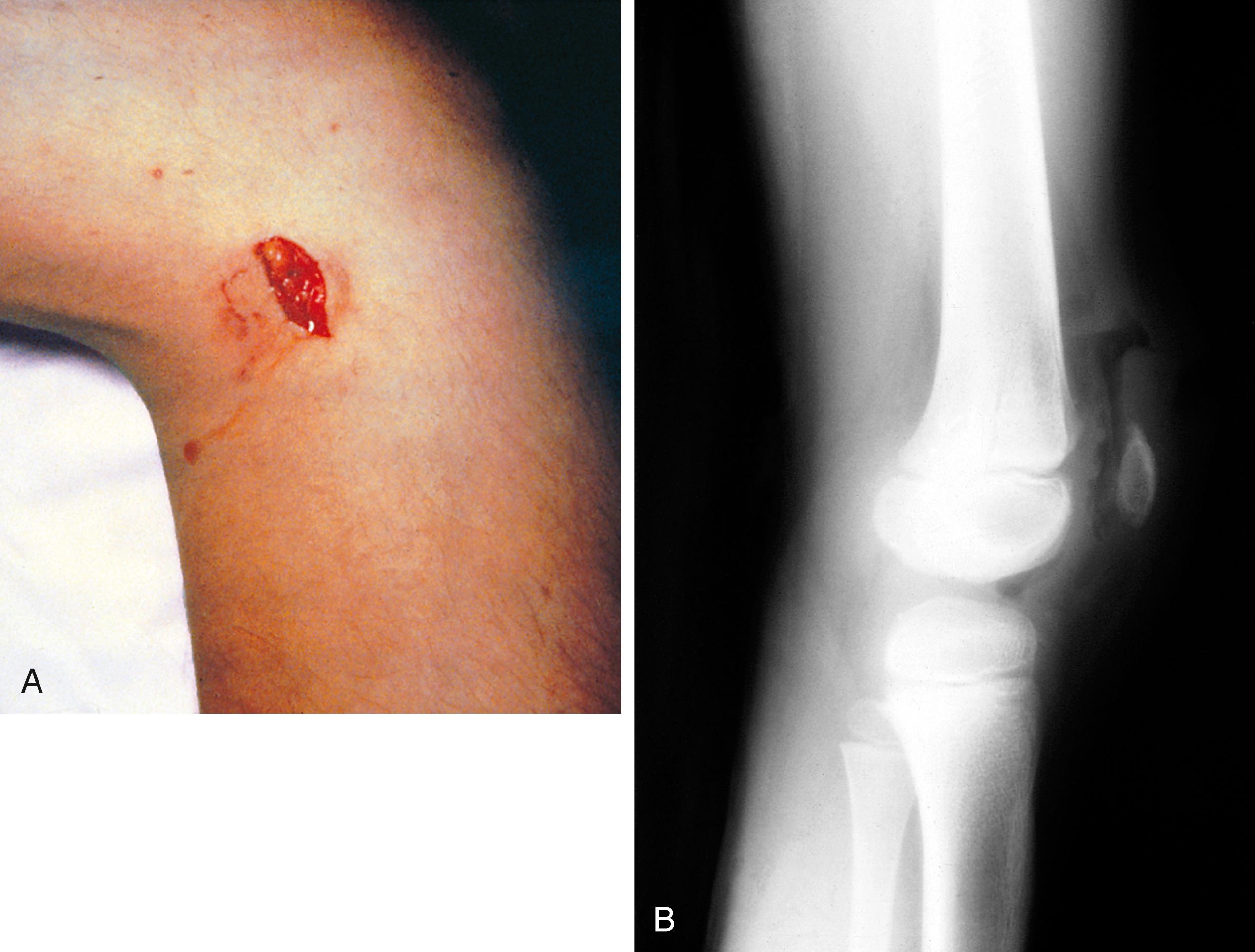
After inspection of the injured area, palpation and assessment of active and passive motion can be performed. It is crucial to remember that in examining an injured limb the entire extremity must be evaluated in order to detect less obvious associated injuries. Localized swelling and tenderness on palpation are significant findings and should alert the examiner to the high likelihood of an underlying fracture. Pain on motion and limitation of motion signal the need for careful scrutiny as well. Assessment of motion involves observation of spontaneous movement, attempts to get the patient to voluntarily move the involved part, and passive movement. Particular attention should be paid to the adjacent proximal and distal joints to avoid missing associated injuries. It can be difficult, however, to determine whether motion is limited because of pain, an associated injury, or fear and lack of cooperation.
Clinical findings vary depending on the nature of the fracture. Nondisplaced growth plate fractures typically present with mild, localized swelling and point tenderness ( Fig. 22.17 ). Because ligamentous injury is relatively uncommon in a child, the finding of point tenderness should suffice to prompt treating the injury as a fracture until proven otherwise. If initial radiographs appear normal, fracture can be confirmed on follow-up with repeat radiographs showing evidence of healing. Swelling is typically mild and occasionally imperceptible in cases of nondisplaced fractures. Careful palpation should disclose focal tenderness, however. Usually, the patient also experiences some degree of discomfort with motion or weight bearing, but limitations may be minimal. In contrast, fractures that completely disrupt the bone and displaced fractures are accompanied by more prominent swelling; more diffuse tenderness; and severe pain, which is markedly increased on motion ( Fig. 22.18 ; see Fig. 22.15A and B ). Crepitus may also be evident on gentle palpation. In examining children with these findings, manipulation must be kept to a minimum to prevent further injury.
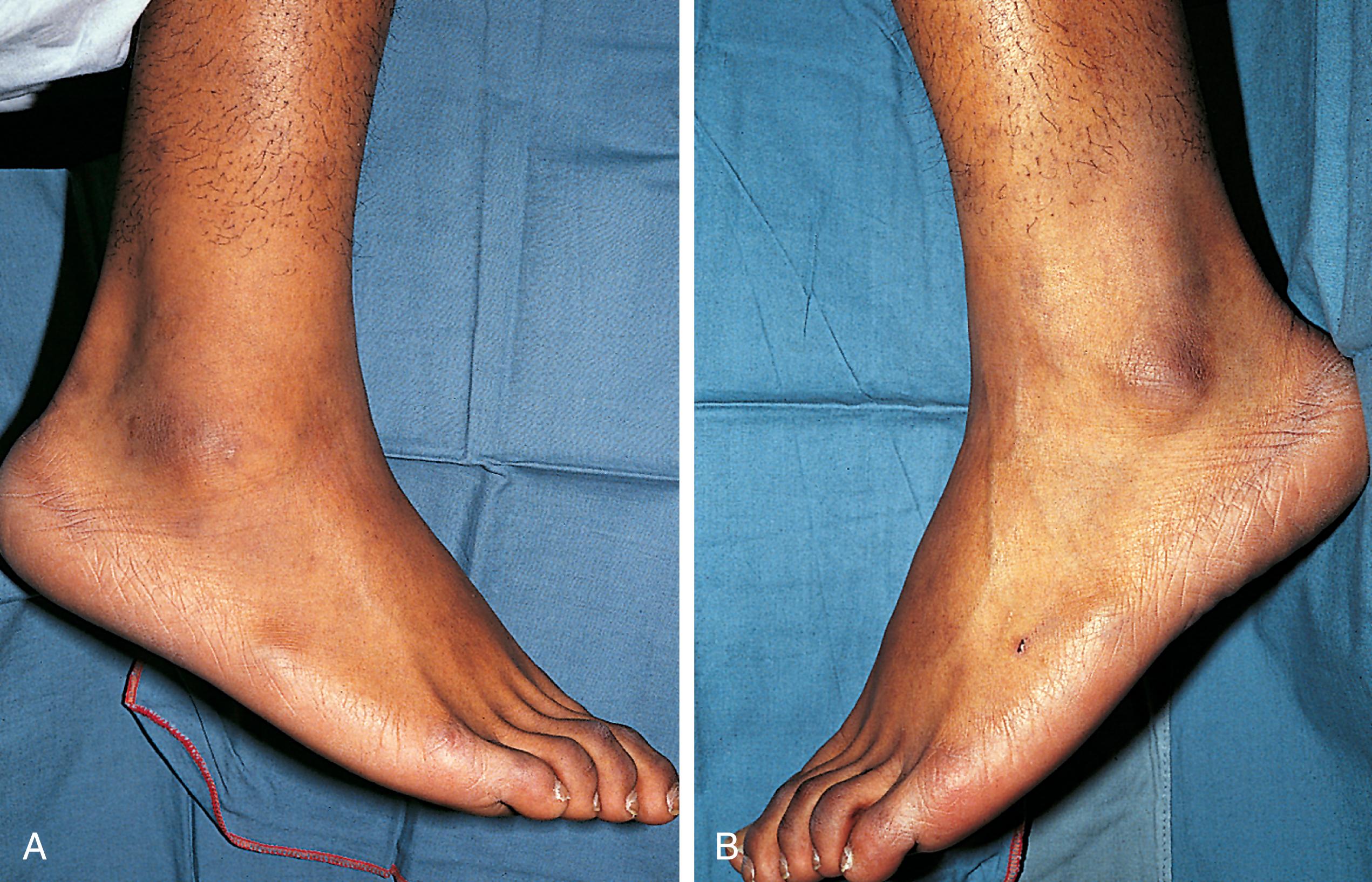
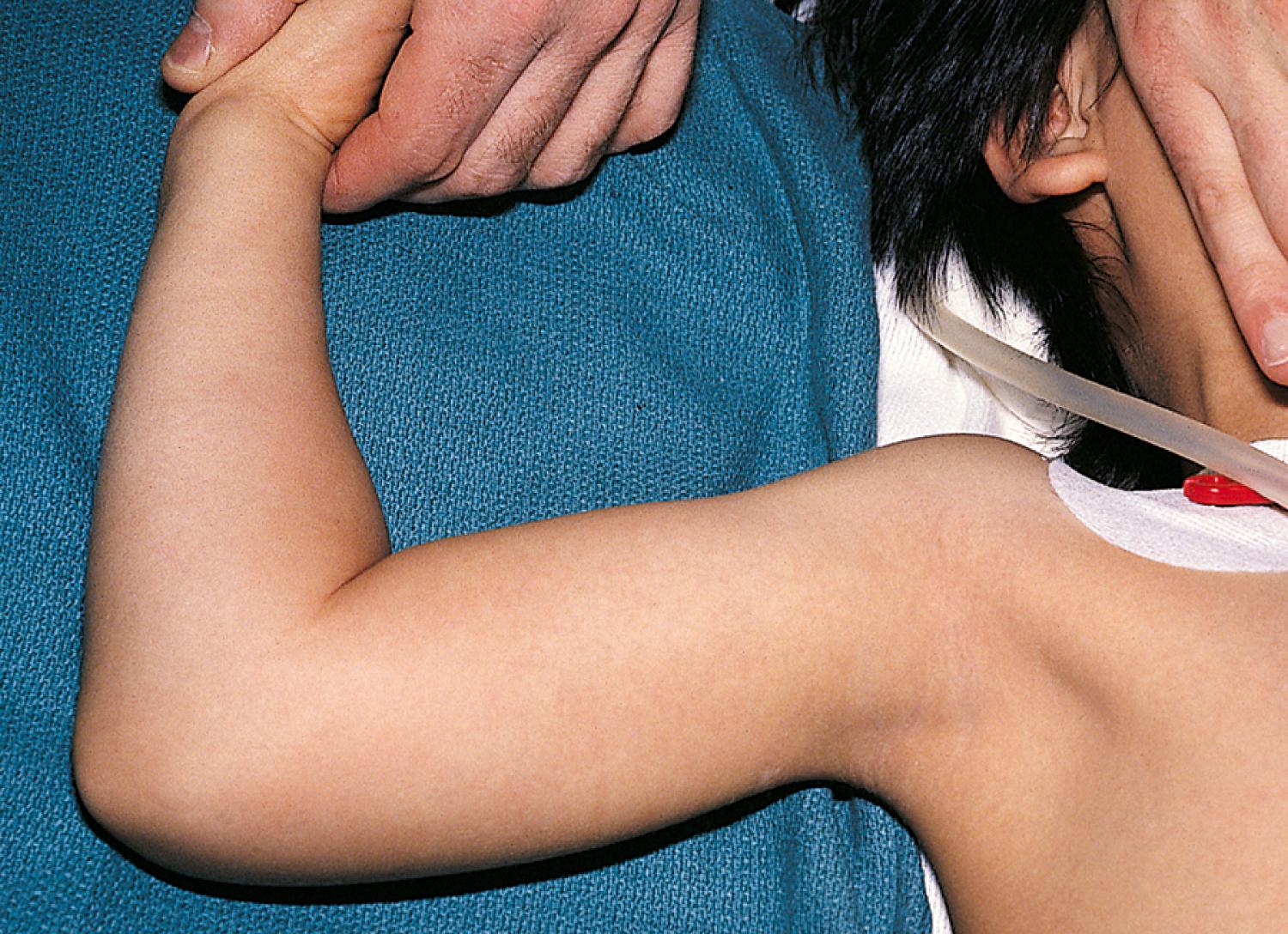
Assessment of neurovascular function distal to the injury is essential in evaluating any child with a potential fracture. This includes checking the integrity of pulses and speed of capillary refill, as well as testing sensory and motor function. Strength and sensation should be compared with those of the contralateral extremity but may be deferred in the setting of an acute fracture. Assessment of two-point discrimination is probably the best test of sensory function, but difficult to perform on a fearful child. While sensory changes are common and usually related to swelling and traction, anatomically explainable motor deficit is an important finding. Evidence of neurovascular compromise necessitates urgent, often operative, orthopedic treatment.
Supracondylar fractures of the humerus, fractures of the proximal tibia, fracture/dislocations of the knee, and severely displaced distal femur fractures are particularly likely to be associated with neurovascular injury. Ankle fractures and dislocations can result in skin necrosis due to localized loss of circulation if left deformed for prolonged periods of time.
Compartment syndrome should always be kept in mind when dealing with skeletal trauma; it is more commonly associated with high-energy mechanisms of injury, especially those with a crush component (motor vehicle accidents with long extraction times, limbs entrapped under heavy objects, etc.). Compartment syndrome results when intracompartmental pressures increase excessively within a closed fascial compartment due to bleeding and edema, resulting in neurovascular compromise and muscle ischemia. In the awake and alert patient, the clinical picture will be striking with severe swelling and tenseness of the affected limb, severe pain resulting in drastic increases in analgesic need, agitation and progressive neurological deficit in the limb. In the obtunded patient, these signs are absent and a high index of suspicion with a low threshold to proceed to fasciotomy must be maintained (see the Compartment Syndromes section).
In all cases of suspected extremity fractures, the injured part should be properly splinted and elevated, an ice pack applied, and analgesia administered prior to transport to the radiology suite. High-quality radiographs are essential in appropriate clinical decision-making. At a minimum, two radiographs taken at 90-degree angles are needed, anteroposterior and lateral views being the most common. Oblique views are helpful in fully disclosing the nature and extent of many fracture patterns, especially when the injury involves the ankle, elbow, hand, or foot. Radiographs should include the joints immediately proximal and distal to a fractured long bone to rule out fracture propagation and concomitant injuries. In certain settings, comparison views of the opposite side can provide more information, especially in injuries that have very subtle radiographic abnormalities. In some cases of displaced or angulated fractures, fractures in the setting of a bone lesion, potentially complex intraarticular fractures, and vertebral and pelvic fractures, a computed tomography (CT) scan can be useful. MRI is rarely utilized in the acute setting but may provide invaluable information in certain special cases (lateral condyle fractures of the distal humerus, tibial eminence fractures, etc.).
Particular care should be taken in interpreting pediatric radiographs because of the high incidence of subtle or even normal findings in patients with fractures. If the clinical picture strongly suggests a fracture, appropriate treatment should be initiated, even if the radiograph appears normal. Reassessment in 1 to 2 weeks can then clarify the exact nature of the injury.
Fractures should be described in terms of anatomic location, direction of the fracture line, type of fracture, and degree of angulation and of displacement. When the growth plate is involved, use of the Salter-Harris classification system is recommended.
Fracture pattern can give clues as to the amount of energy absorbed by the bone at the moment of injury. Low-energy mechanisms such as ground-level falls and twisting type injuries will result in spiral and oblique fractures. Direct, moderate-energy mechanisms such as sports collisions can result in transverse fractures or fractures with butterfly segments. High-energy mechanisms such as motor vehicle accidents and falls from heights will result in segmental or comminuted fracture patterns.
A common example of a nondisplaced spiral fracture is the toddler’s fracture (see Fig. 22.43 ), which results from a twist. Typically, the child will fall with the extremity caught underneath his or her body, or, more commonly, the leg will get caught on a slide while traveling down in an adult’s lap. Greenstick and torus fractures of the radius or ulna are incurred usually when the child falls on an outstretched arm with the wrist dorsiflexed. Vigorous repetitive shaking while holding a child by the hands, feet, or chest results in small metaphyseal chip or bucket-handle fractures, a major feature of nonaccidental trauma (see Chapter 6 ). Table 22.4 summarizes the major features of these various fracture patterns, which are illustrated in Figs. 22.19 through 22.27 .
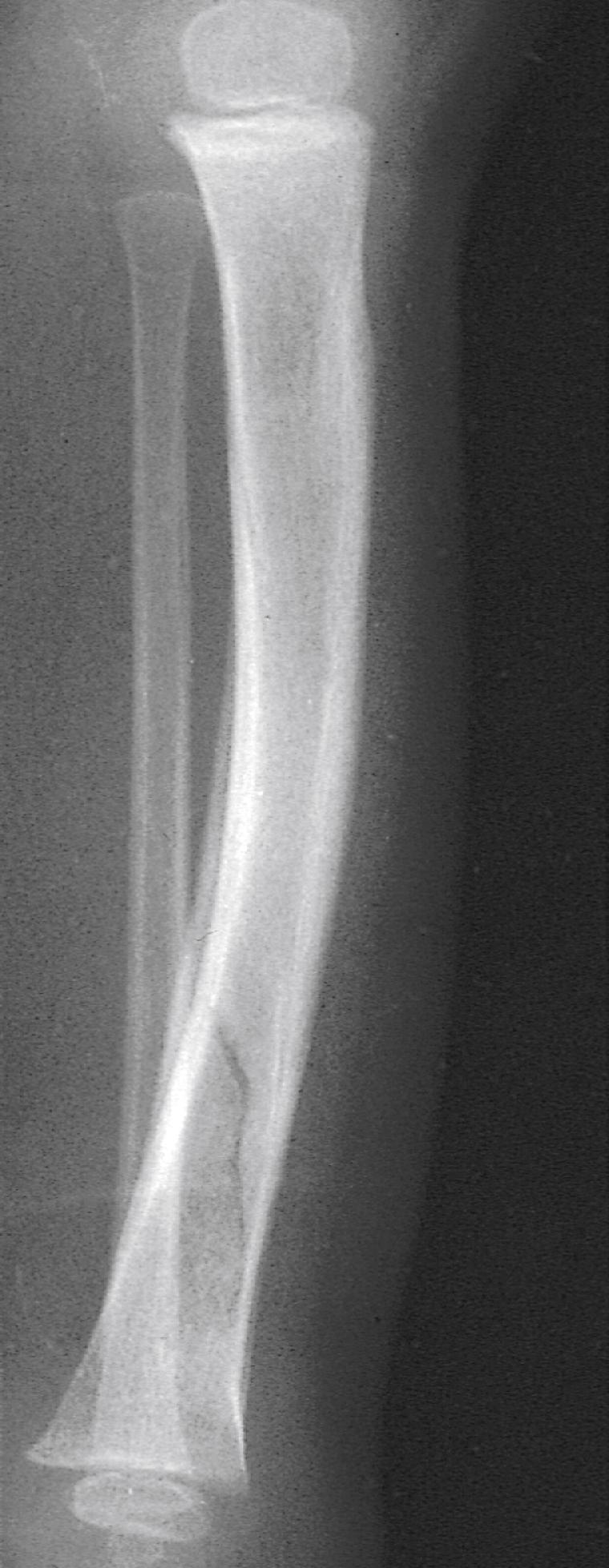
| Fracture Pattern | Major Feature | Radiographic Appearance |
|---|---|---|
| Longitudinal | Fracture line is parallel to the axis of a long bone | Fig. 22.19 |
| Transverse | Fracture line is perpendicular to the axis of a long bone | Fig. 22.20 ; see Fig. 22.28 |
| Oblique | Fracture line is at an angle relative to the axis of a bone | Fig. 22.21 |
| Spiral | Fracture line takes a curvilinear course around the axis of a bone | Fig. 22.22 ; see Fig. 22.43 |
| Impacted | Bone ends are crushed together, producing an indistinct fracture line | Fig. 22.23 |
| Comminuted | Fracturing forces produce more than two separate fragments | Fig. 22.24 |
| Bowing | Bone bends to the point of plastic deformation without fracturing | Fig. 22.25 |
| Greenstick | Fracture is complete except for a portion of the cortex on the compression side of the fracture, which is only plastically deformed | Fig. 22.26 ; see Fig. 22.25B |
| Torus | Bone buckles and bends rather than breaks | Fig. 22.27 ; see Fig. 22.29 |
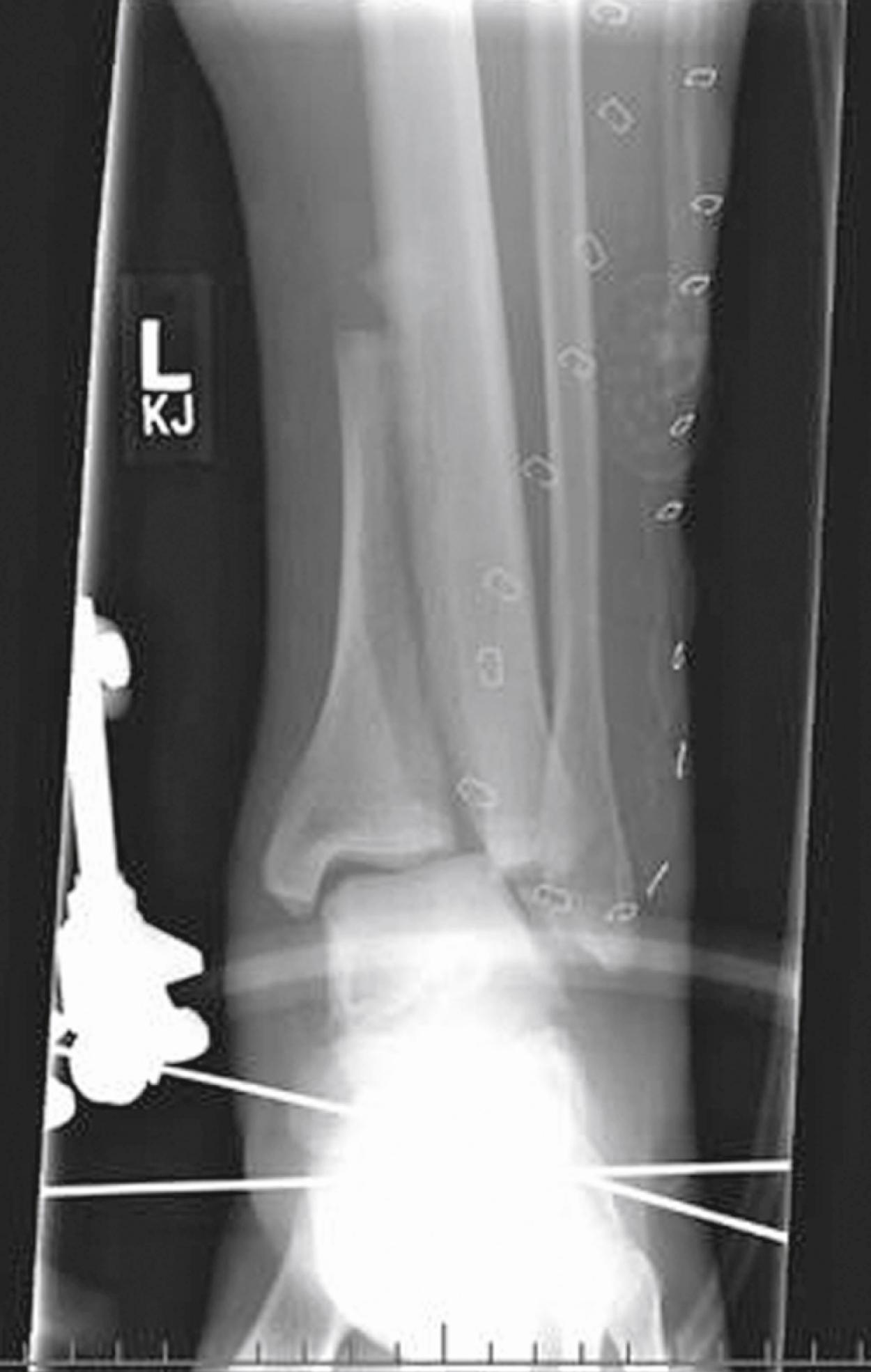
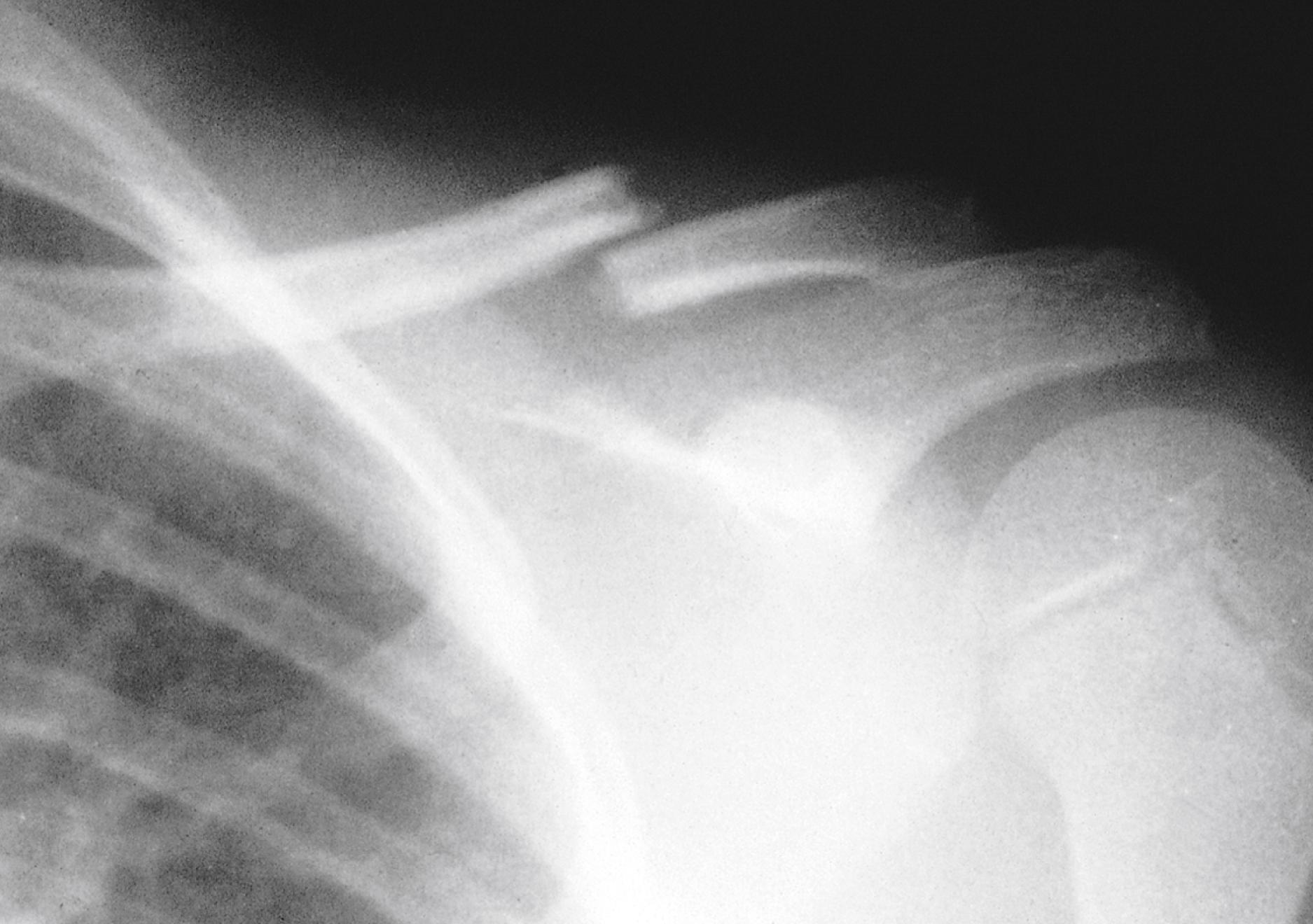
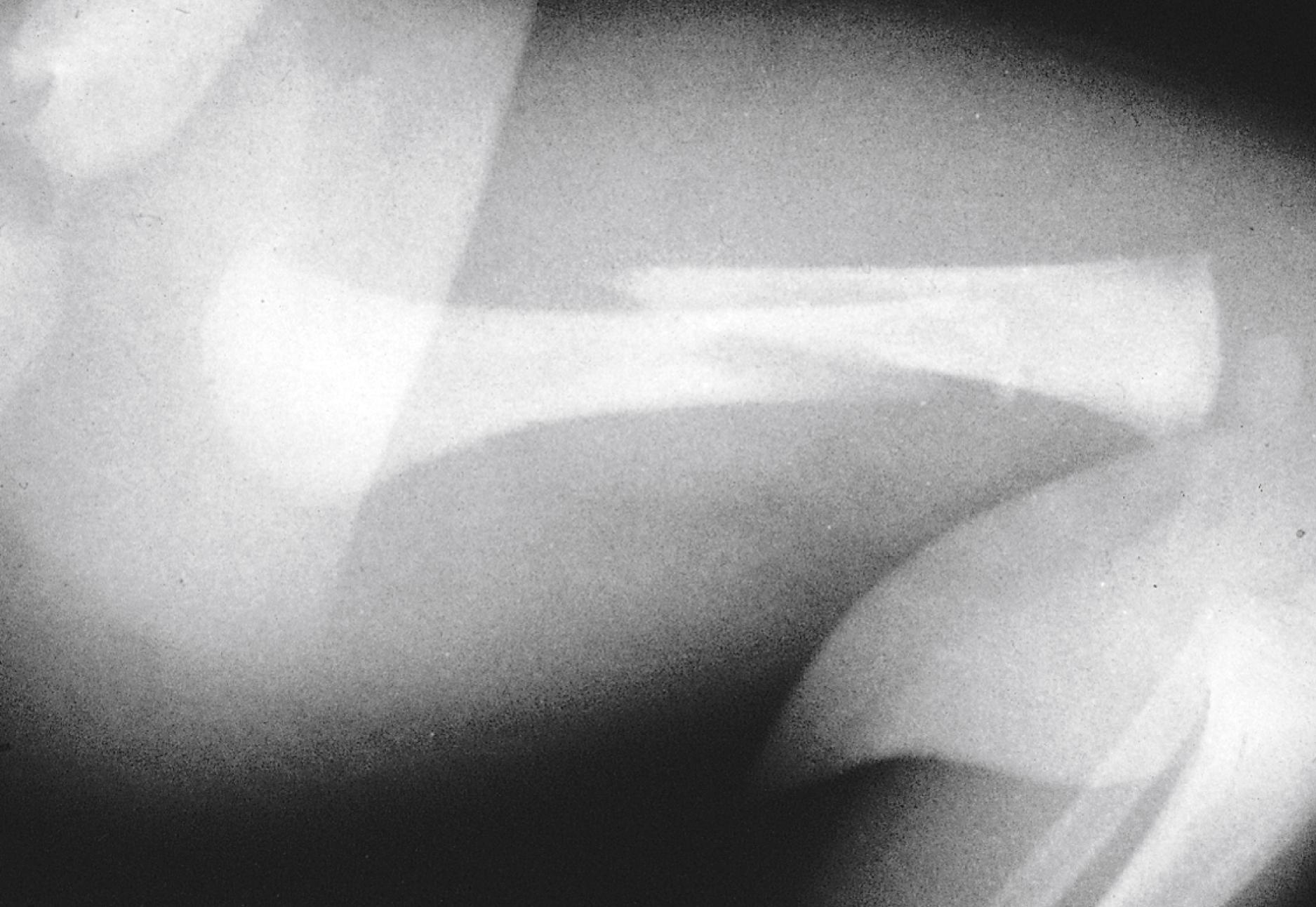
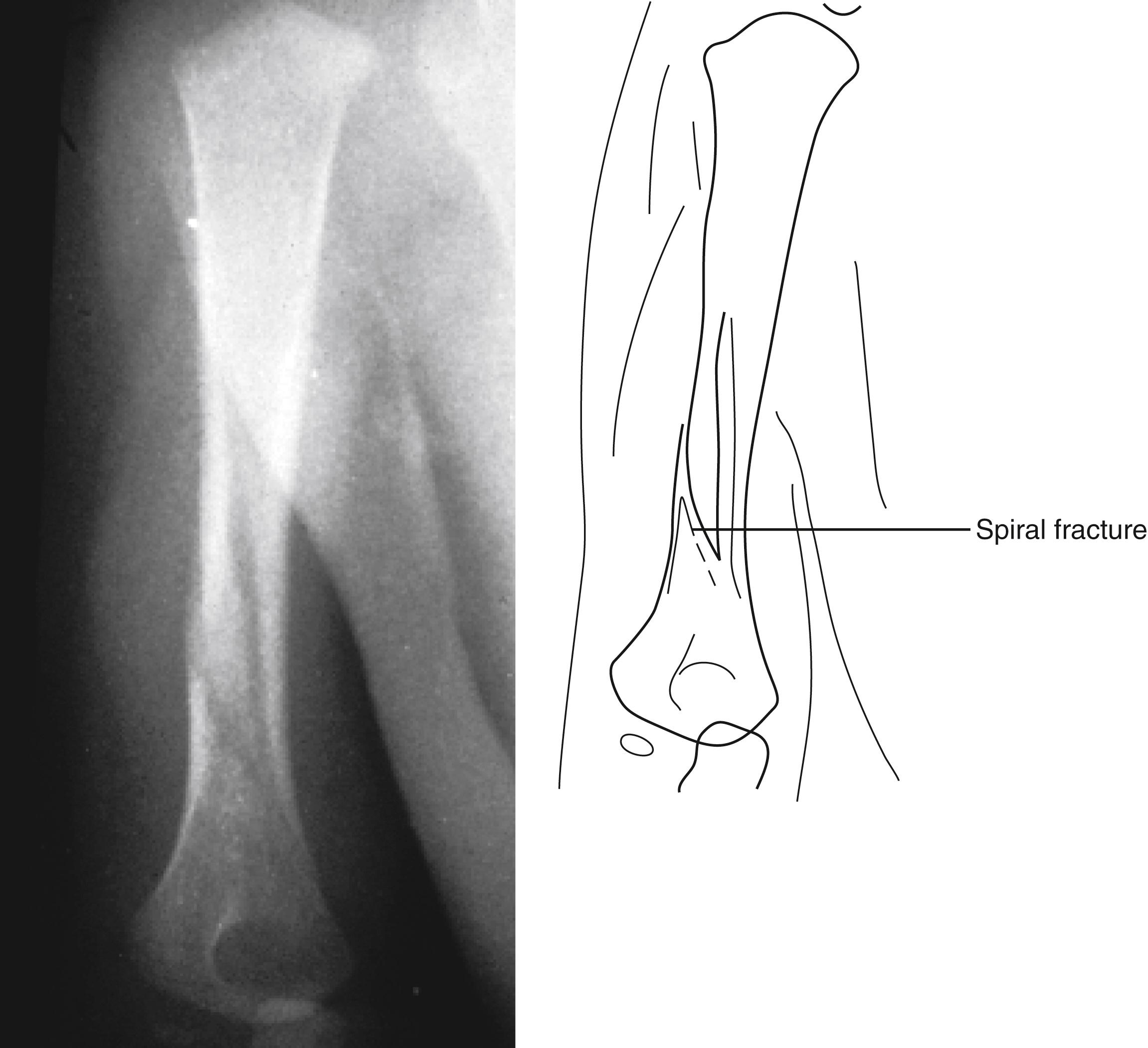
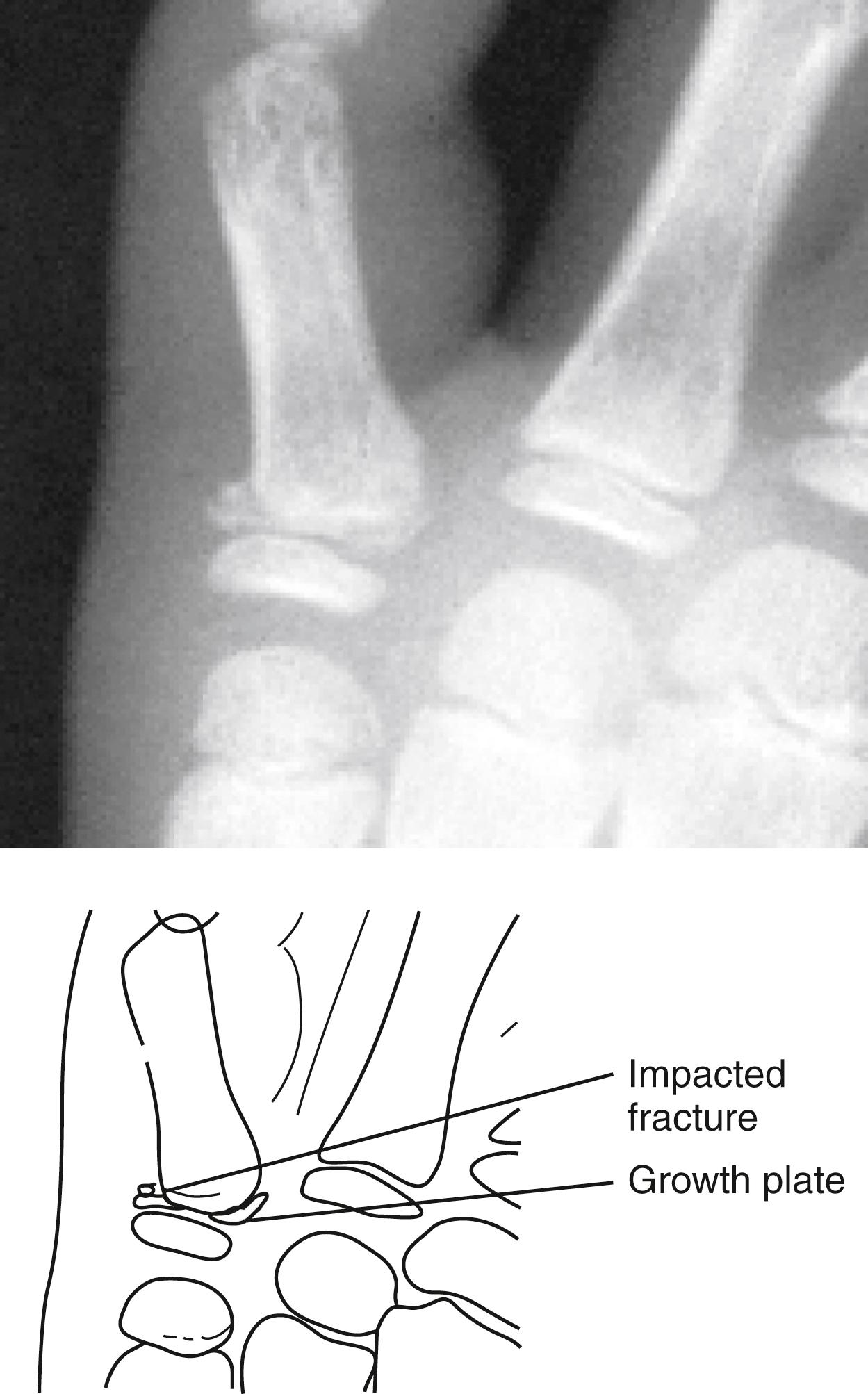
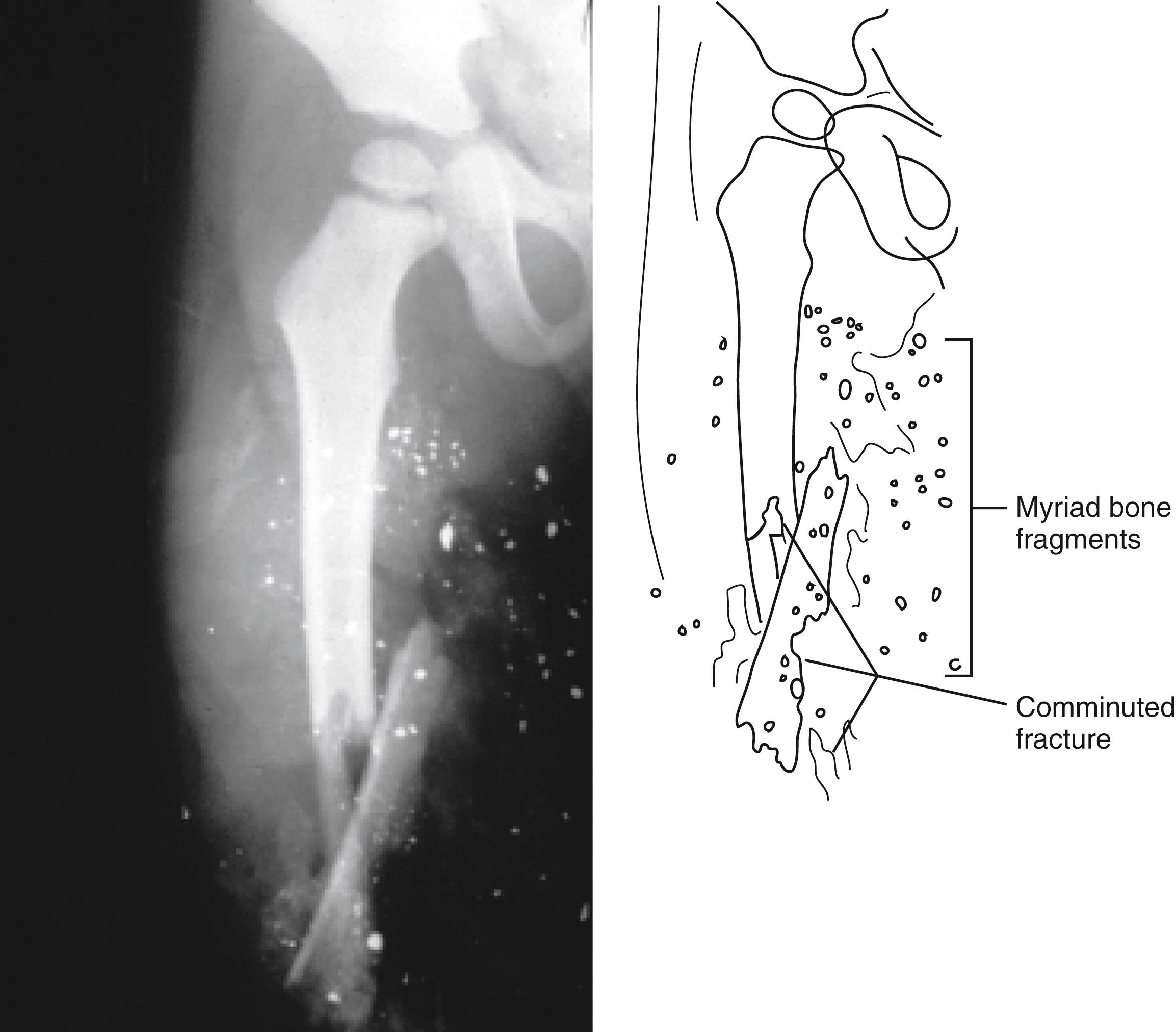
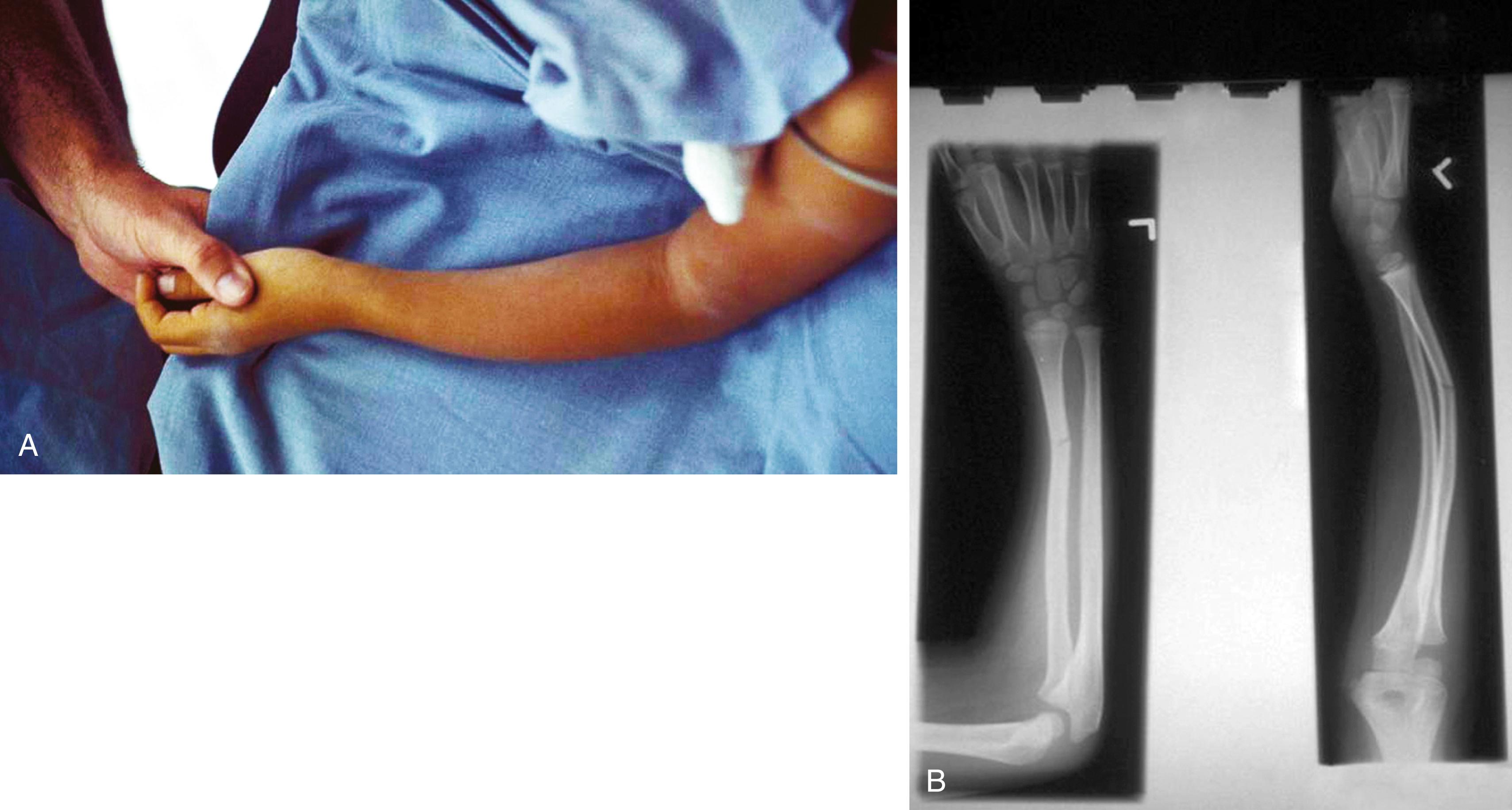
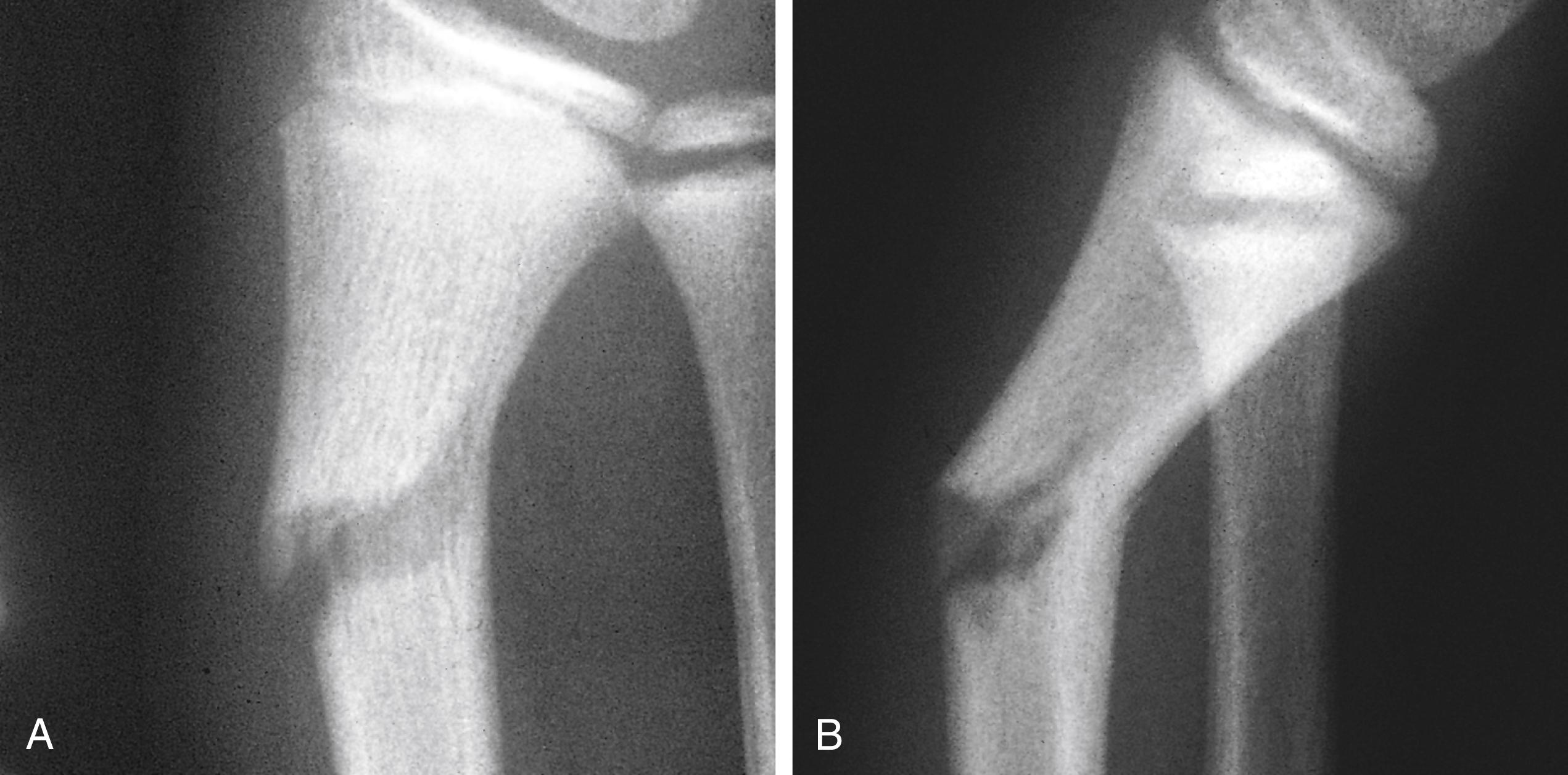
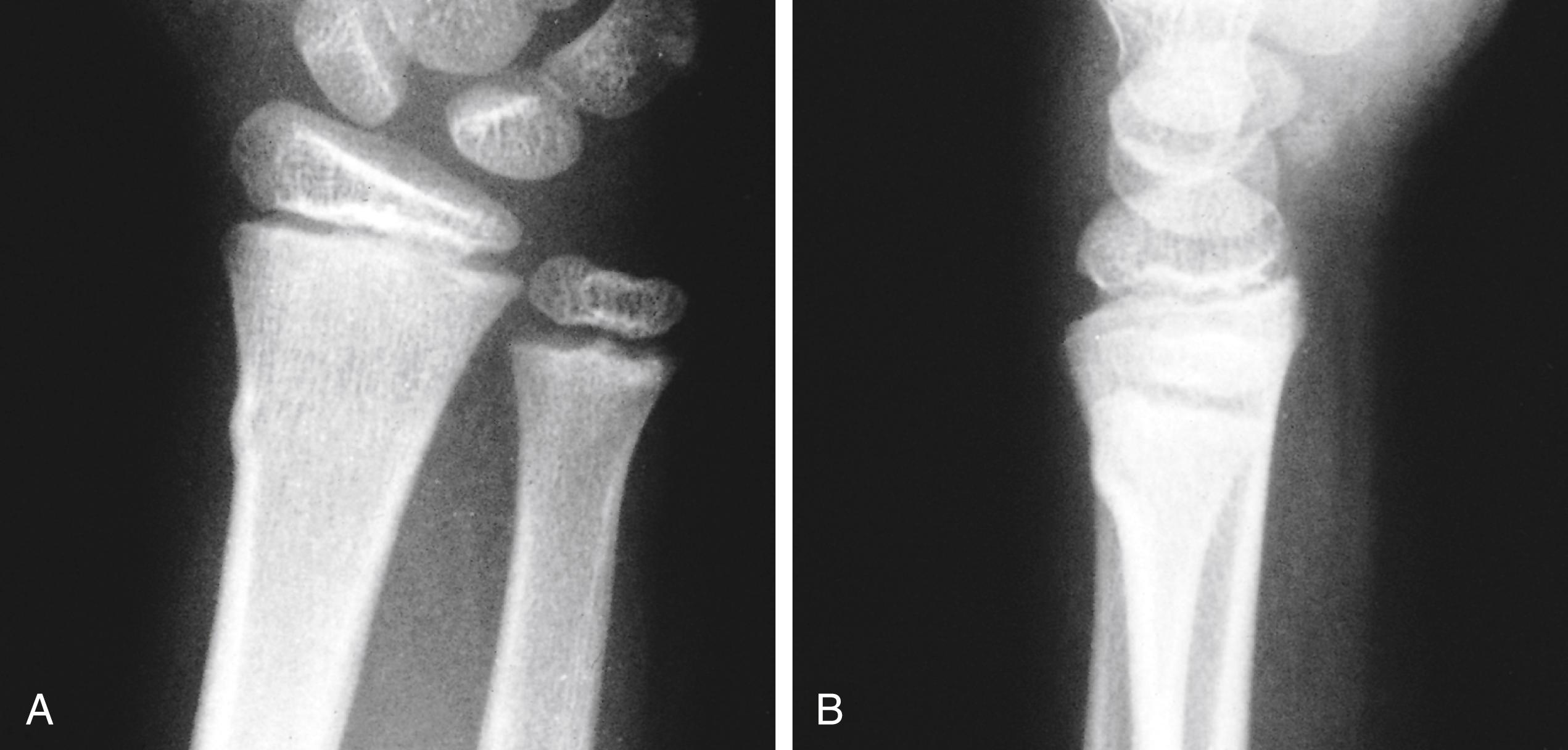
The anatomic location of the fracture line simply refers to that portion of the bone to which the injury force was applied. Table 22.5 presents types of fractures classified by anatomic location. These fractures are illustrated in Figs. 22.28 through 22.36 . There is some degree of overlap in this method of categorization.
| Type | Site | Radiographic Appearance |
|---|---|---|
| Diaphyseal | Fracture involves the central shaft of a long bone | Fig. 22.28 ; see Figure 21.21 , Figure 21.22 , and 21.25 |
| Metaphyseal | Fracture involves the widened end of a long bone | Fig. 22.29 ; see Fig. 22.26 and Chapter 6 |
| Epiphyseal | Fracture involves the chondro-osseous end of a long bone; such fractures can also be classified as Salter-Harris fractures | Fig. 22.30 |
| Articular | Fracture involves the cartilaginous joint surface | Fig. 22.31 ; see Figure 21.40 , Figure 21.41 |
| Intercondylar | Fracture is located between the condyles of a joint; this is one variant of articular fracture and could also be subclassified as a Salter-Harris fracture | Fig. 22.31A |
| Physeal | Fracture involves the growth center of long bone; these are subclassified according to the Salter-Harris system | Fig. 22.32 |
| Condylar | Fracture traverses the condyle of a joint | Fig. 22.33 |
| Supracondylar | Fracture line is located just proximal to the condyles of a joint | Fig. 22.34 |
| Epicondylar | Fracture involves an area juxtaposed to the condylar surface of a joint | Fig. 22.35 |
| Subcapital | Fracture is located just below the epiphyseal head of certain bones | Fig. 22.36 |
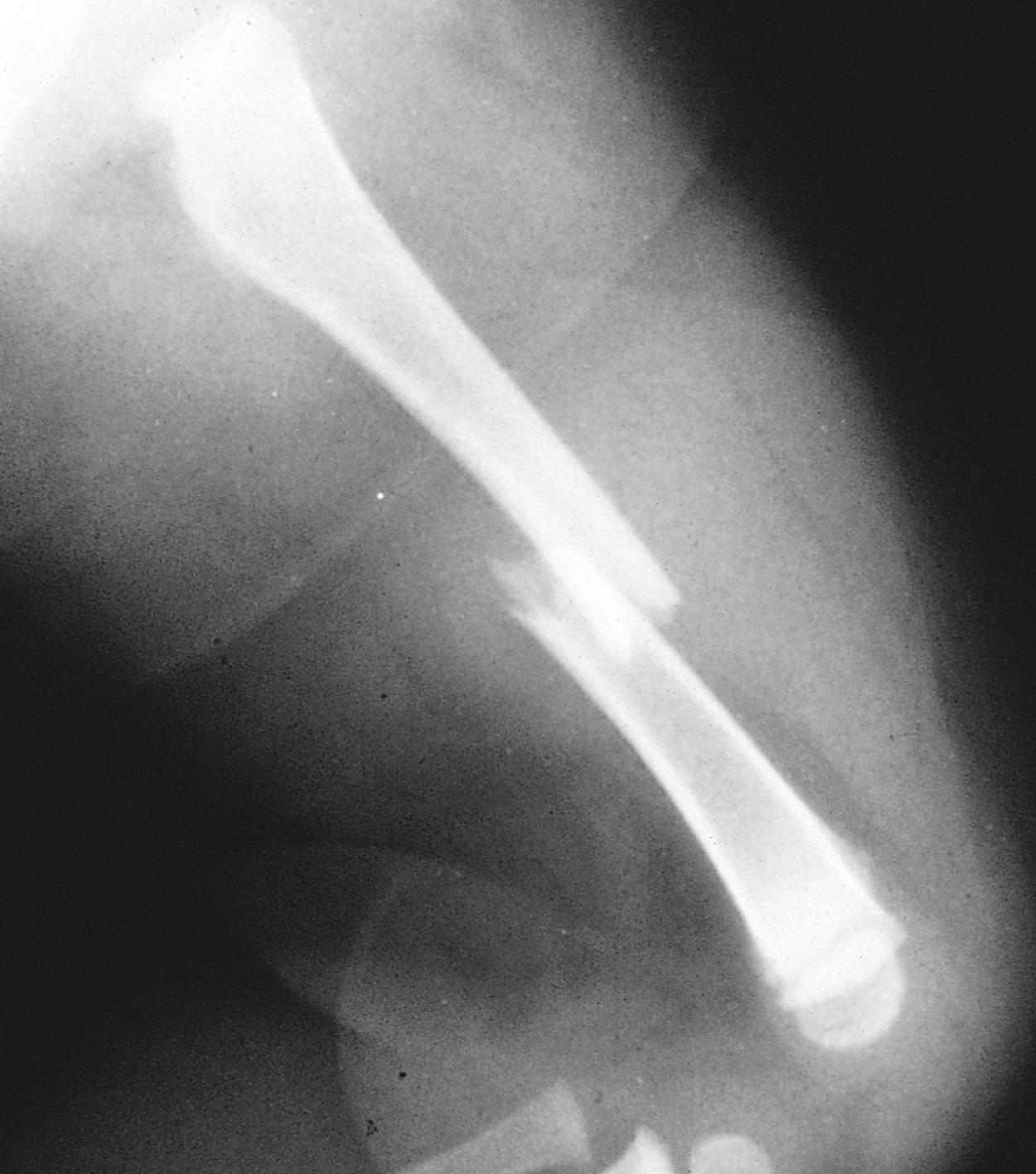
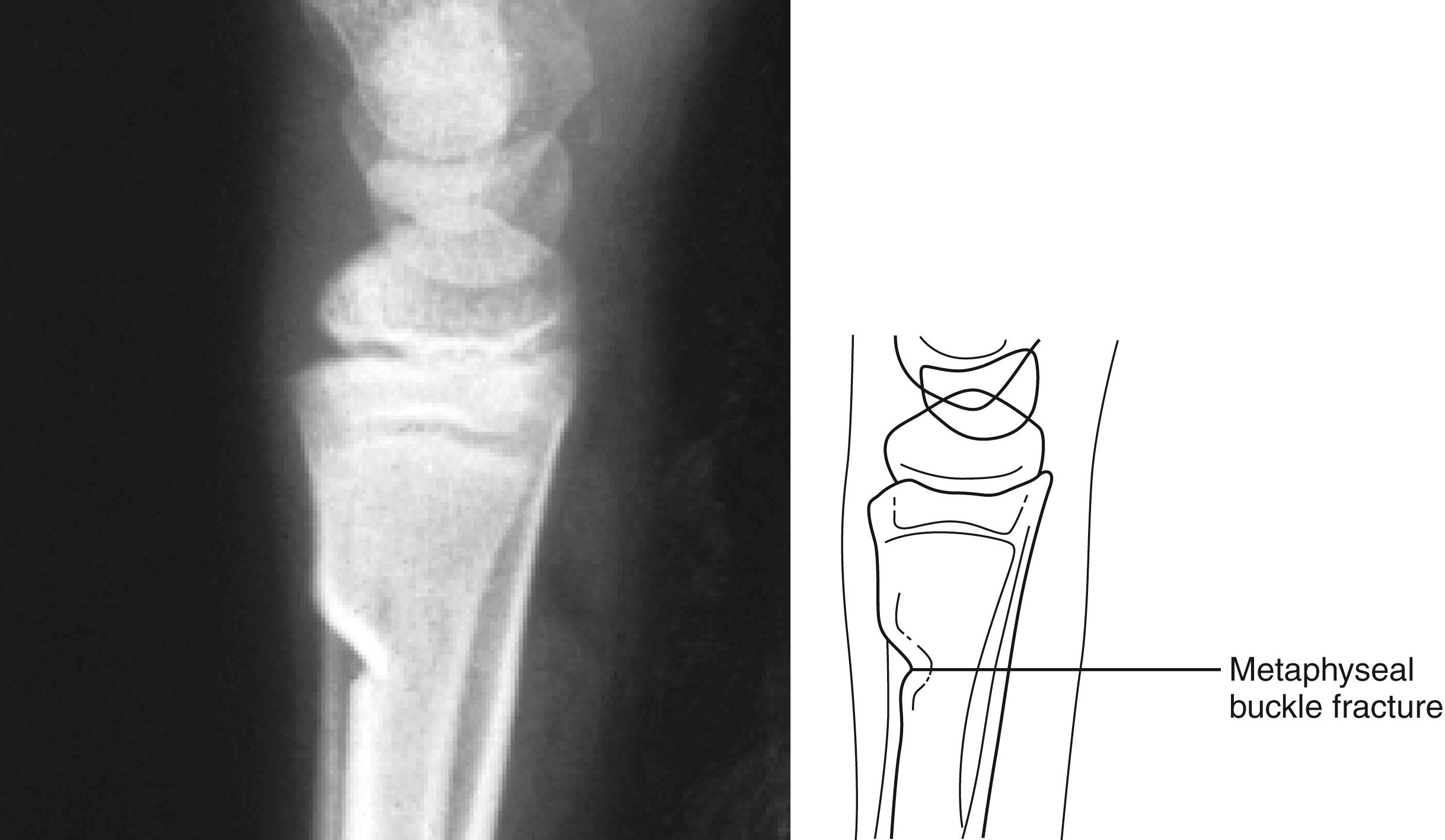
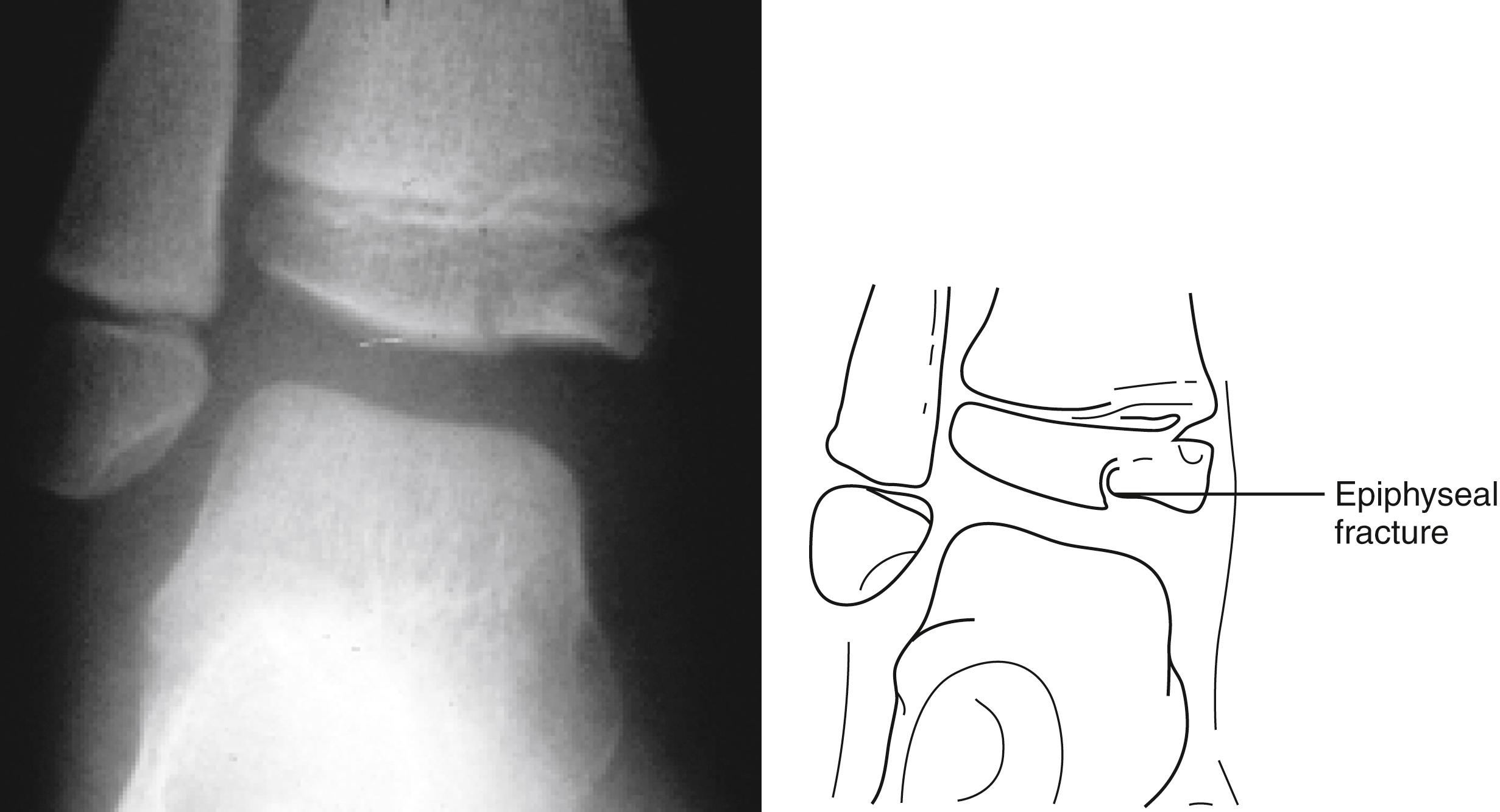
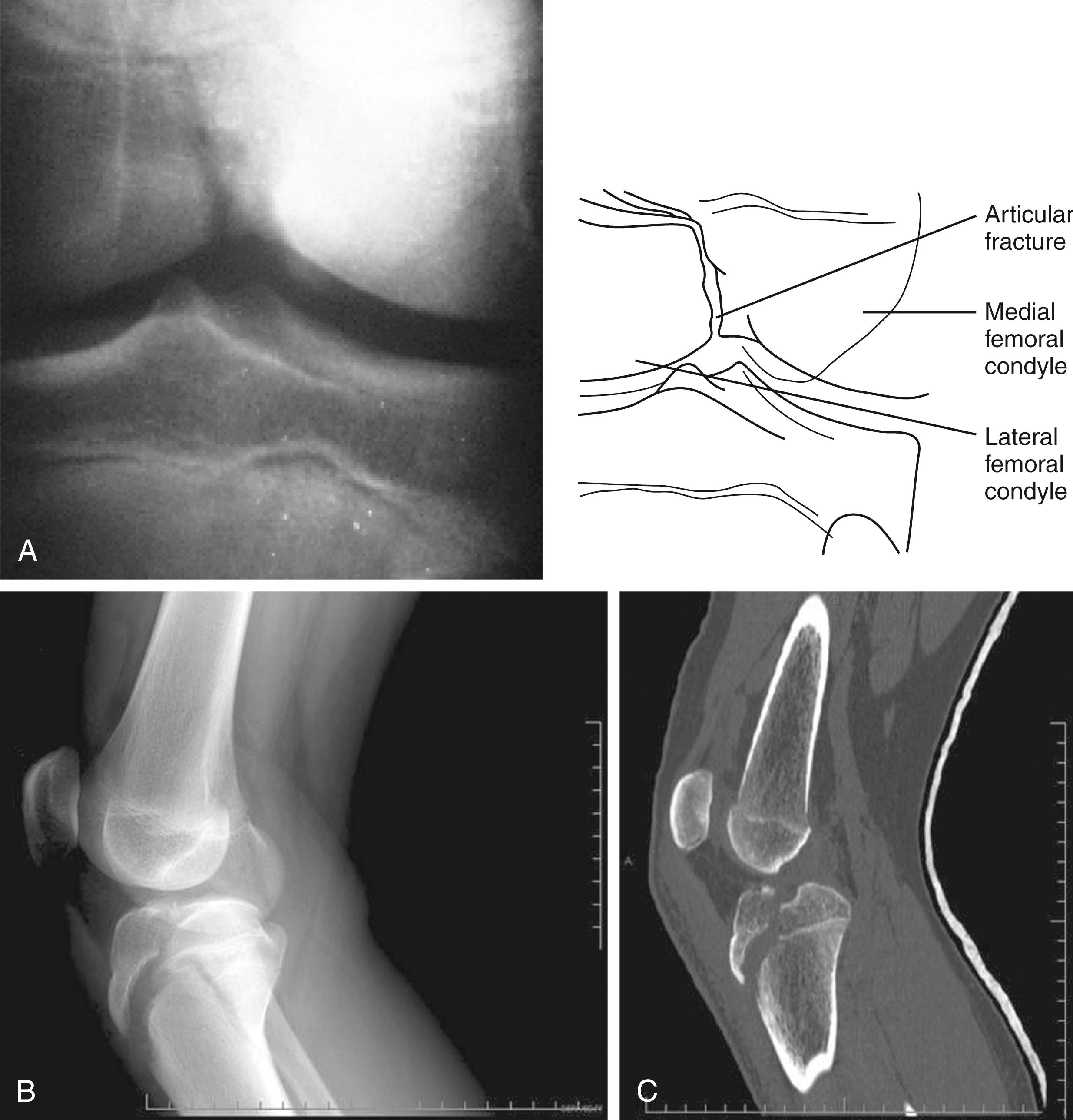
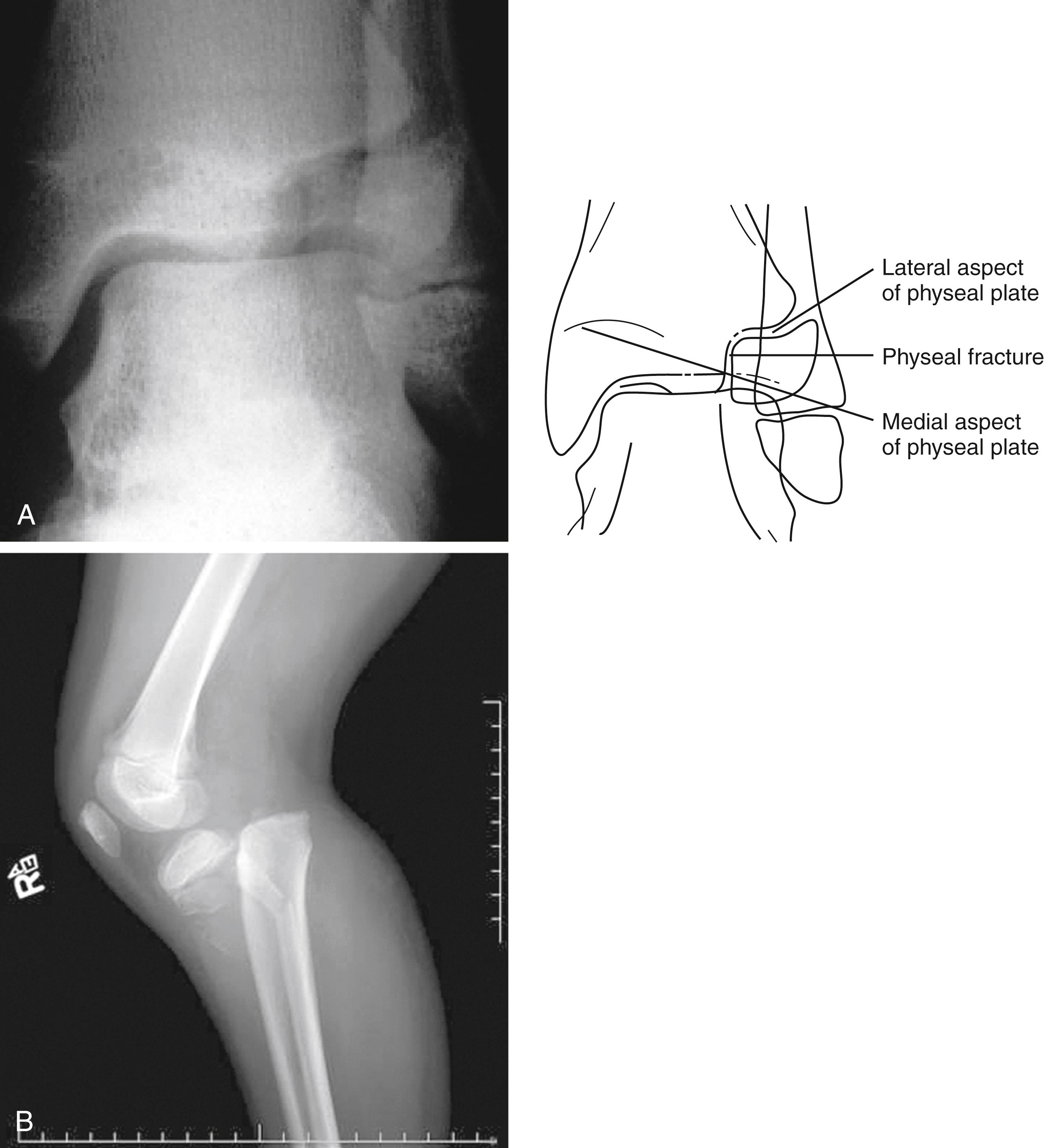
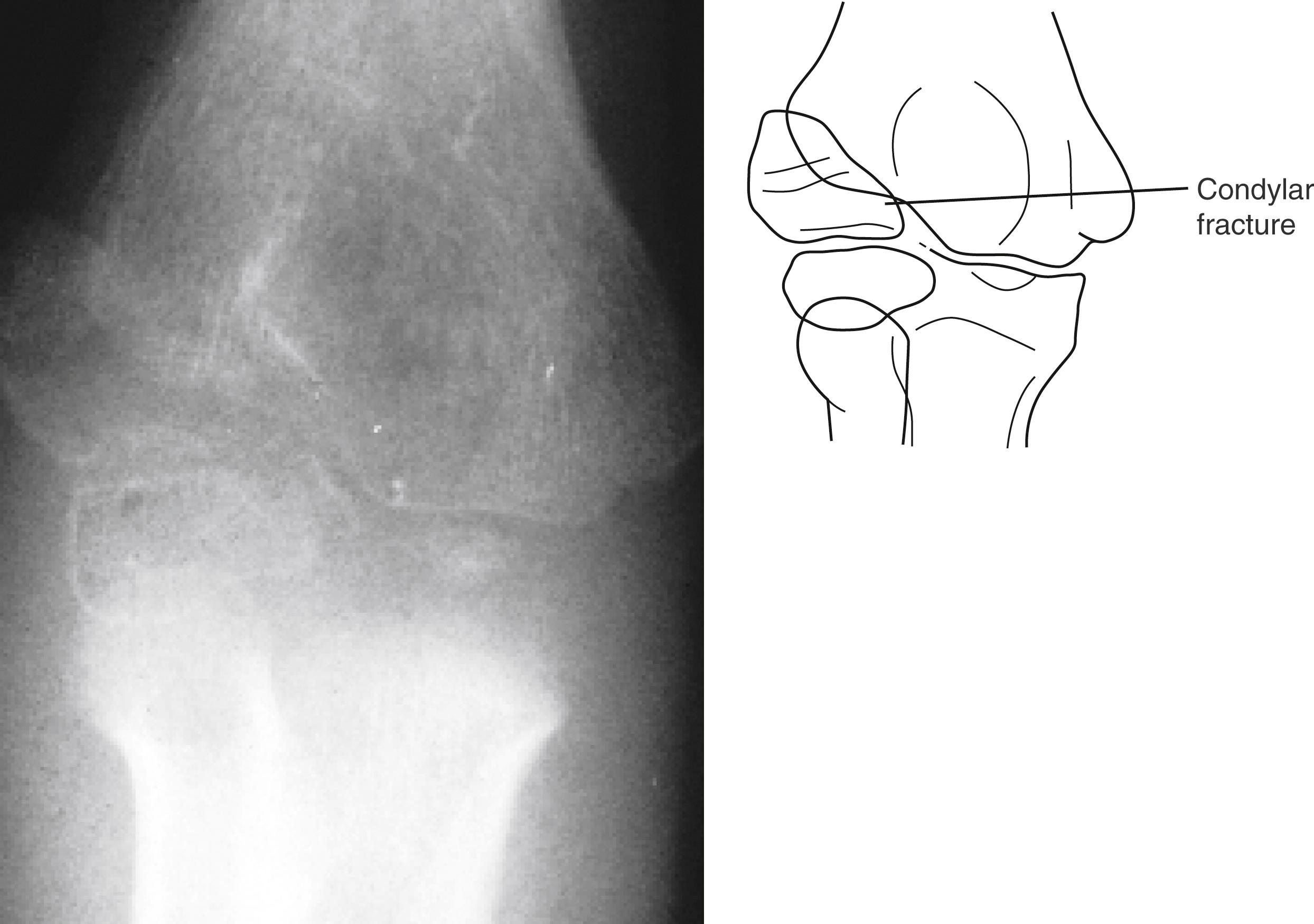
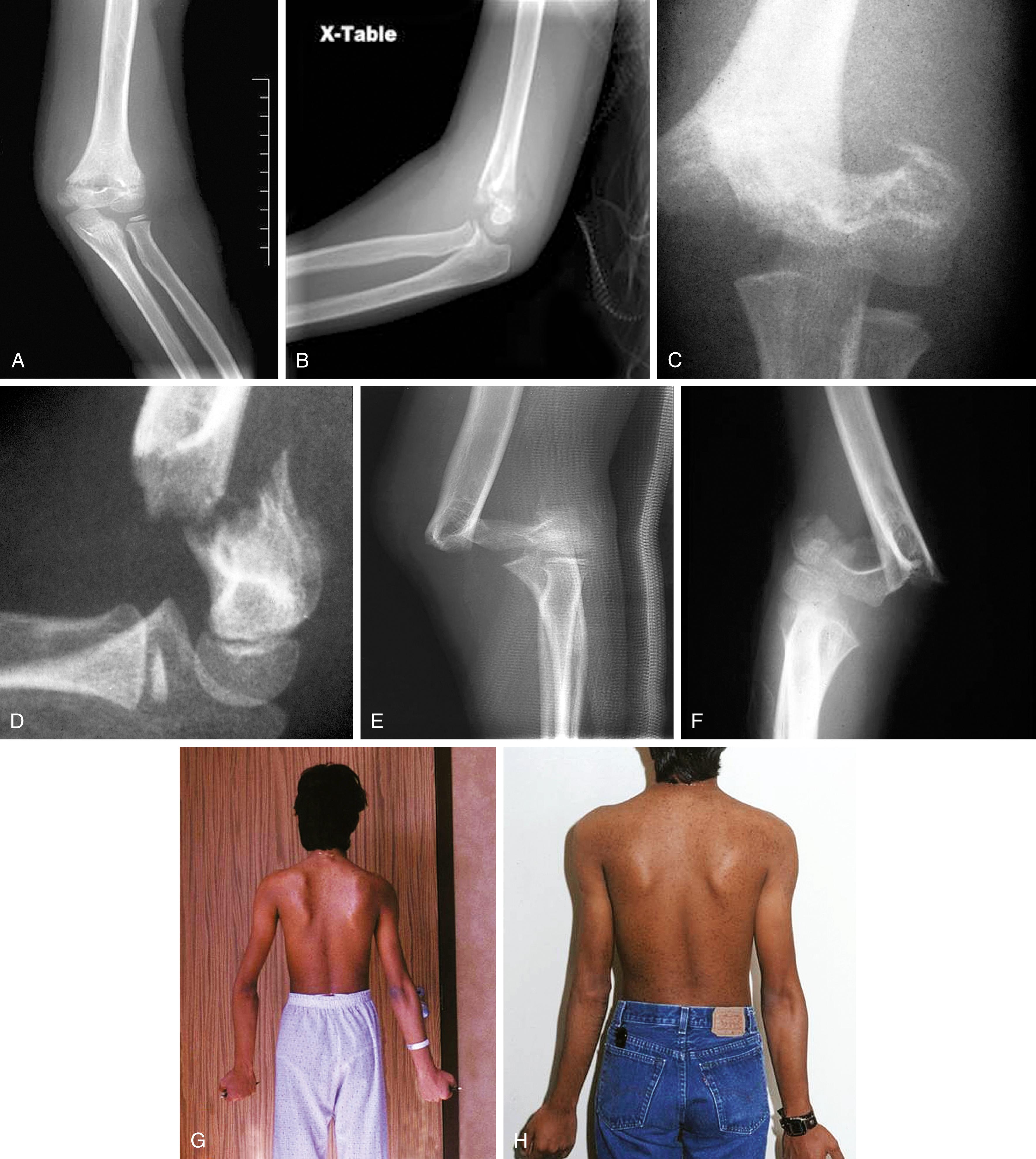
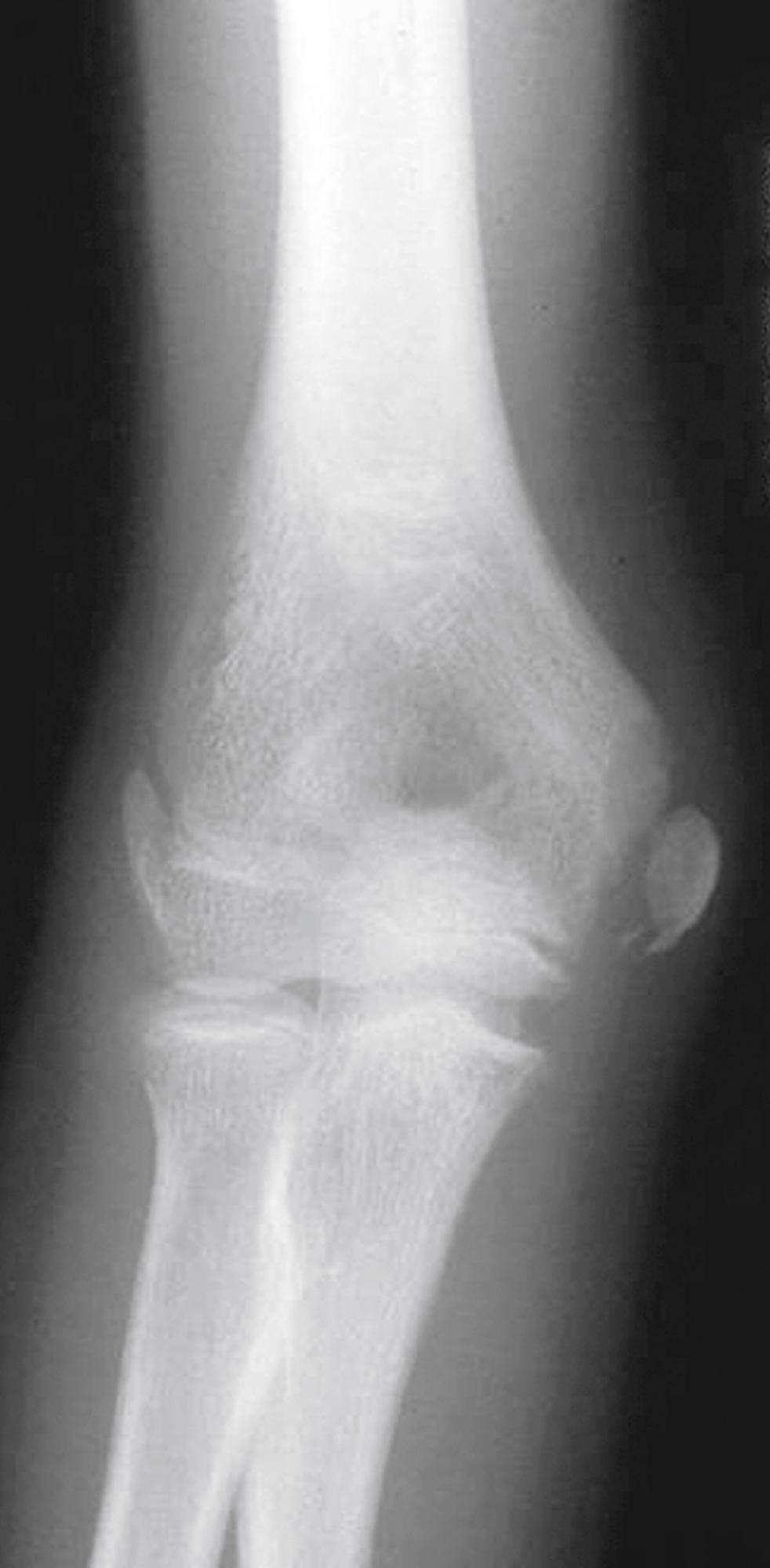
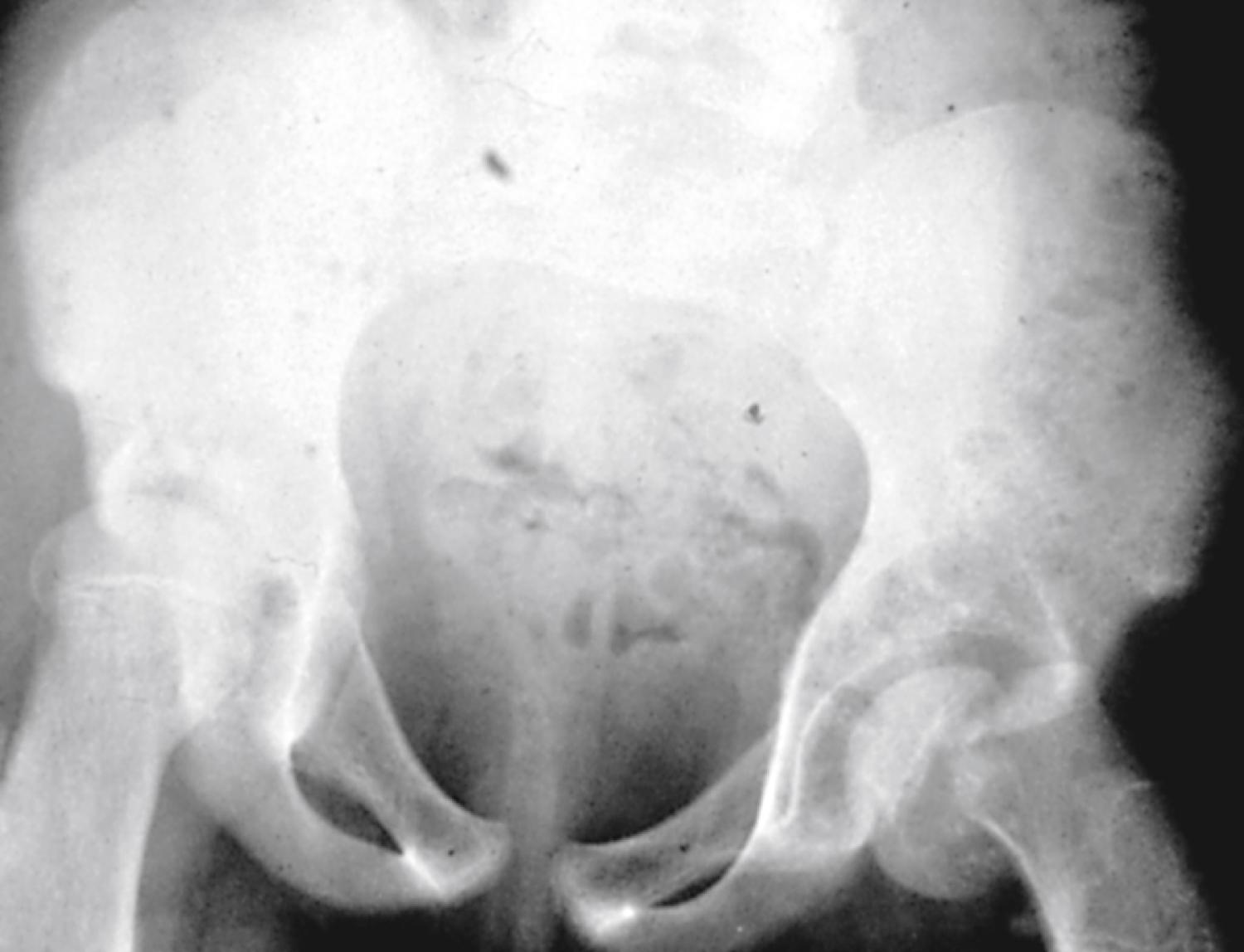
An estimated 15% of all fractures in children involve the physis. Because the adjacent epiphyseal plate is not ossified in the young child and therefore is invisible on a radiograph, the fracture may be mistaken for a minor sprain or missed altogether, and in rare cases, result in growth arrest. Even if diagnosed and properly treated, physeal injuries may still result in longitudinal or angular growth abnormalities. This risk is especially high in children with physeal fractures sustained in high-energy mechanisms and can occur even with appropriate treatment.
Because of the potential for long-term morbidity in patients with physeal fractures, great attention has been focused on the classification, diagnosis, treatment, and prognosis of physeal fractures. The Salter-Harris classification scheme is the system most commonly used in North America to classify physeal injuries ( Fig. 22.37 ).
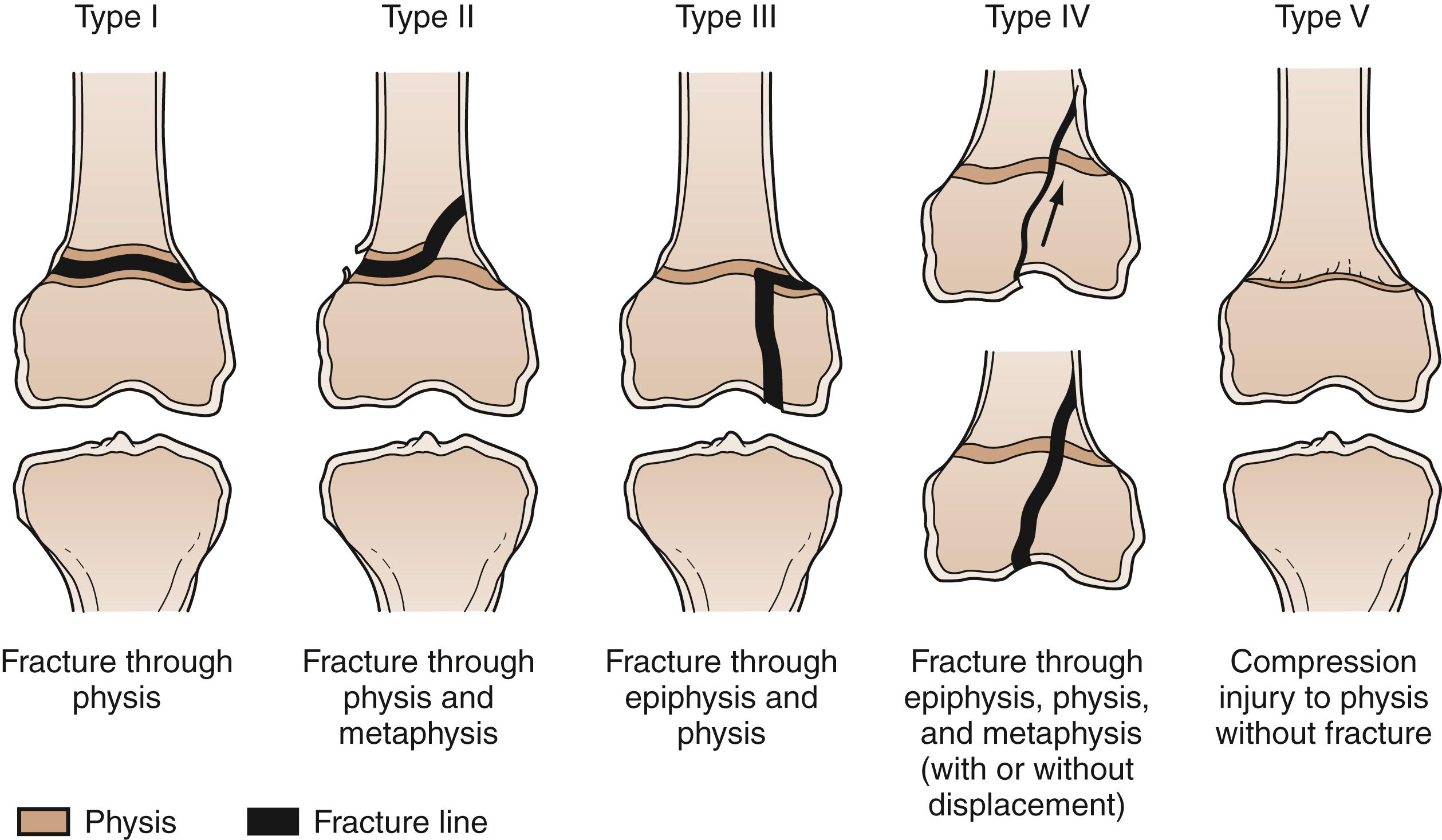
A Salter-Harris type I injury consists of a fracture running horizontally through the physis itself, resulting in a variable degree of separation of the epiphysis from the metaphysis. The amount of separation depends on the degree of periosteal disruption. Radiographs are often normal; hence the diagnosis frequently must be made clinically on the basis of the findings of point tenderness and mild soft tissue swelling over the site of an epiphysis ( Fig. 22.38 ; see Fig. 22.17 ). This type usually has the lowest growth arrest rates.
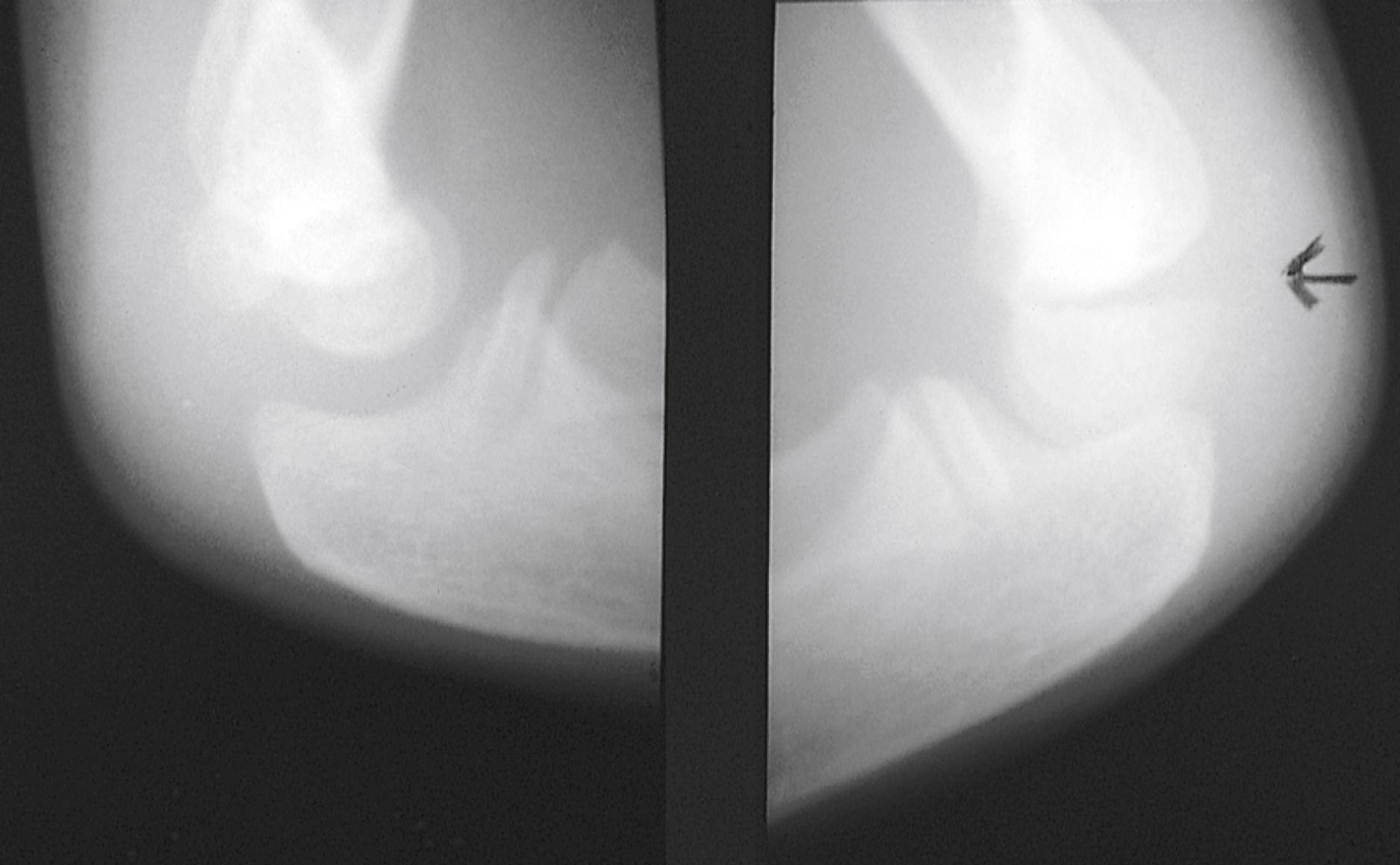
A Salter-Harris type II injury consists of a fracture line running a variable distance through the physis and exiting through the metaphysis on the side opposite the site of fracture initiation. A fragment consisting of the entire epiphysis with an attached metaphyseal fragment is thus produced ( Fig. 22.39 ). With appropriate treatment, growth arrest rates are low.
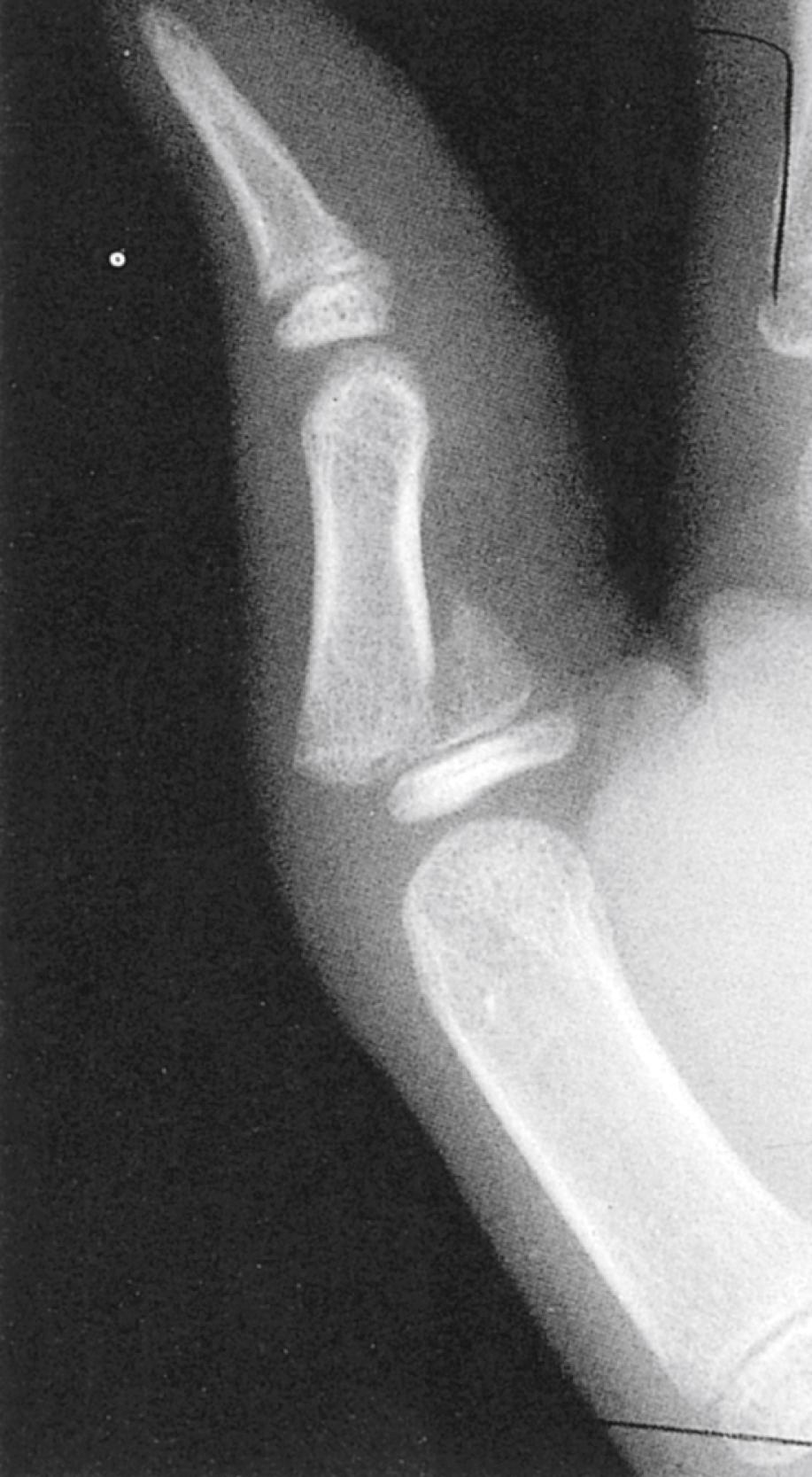
Intraarticular shearing forces can produce a fracture line running from the articular surface through the epiphysis and then exiting through a portion of the physis. This creates a separate epiphyseal fragment with no connection to the metaphysis ( Fig. 22.40 ; see Figure 21.30, Figure 21.32 ). Accurate anatomic reduction is required to achieve the best possible outcome. Growth arrest rates are usually moderate to high depending on the individual injury.
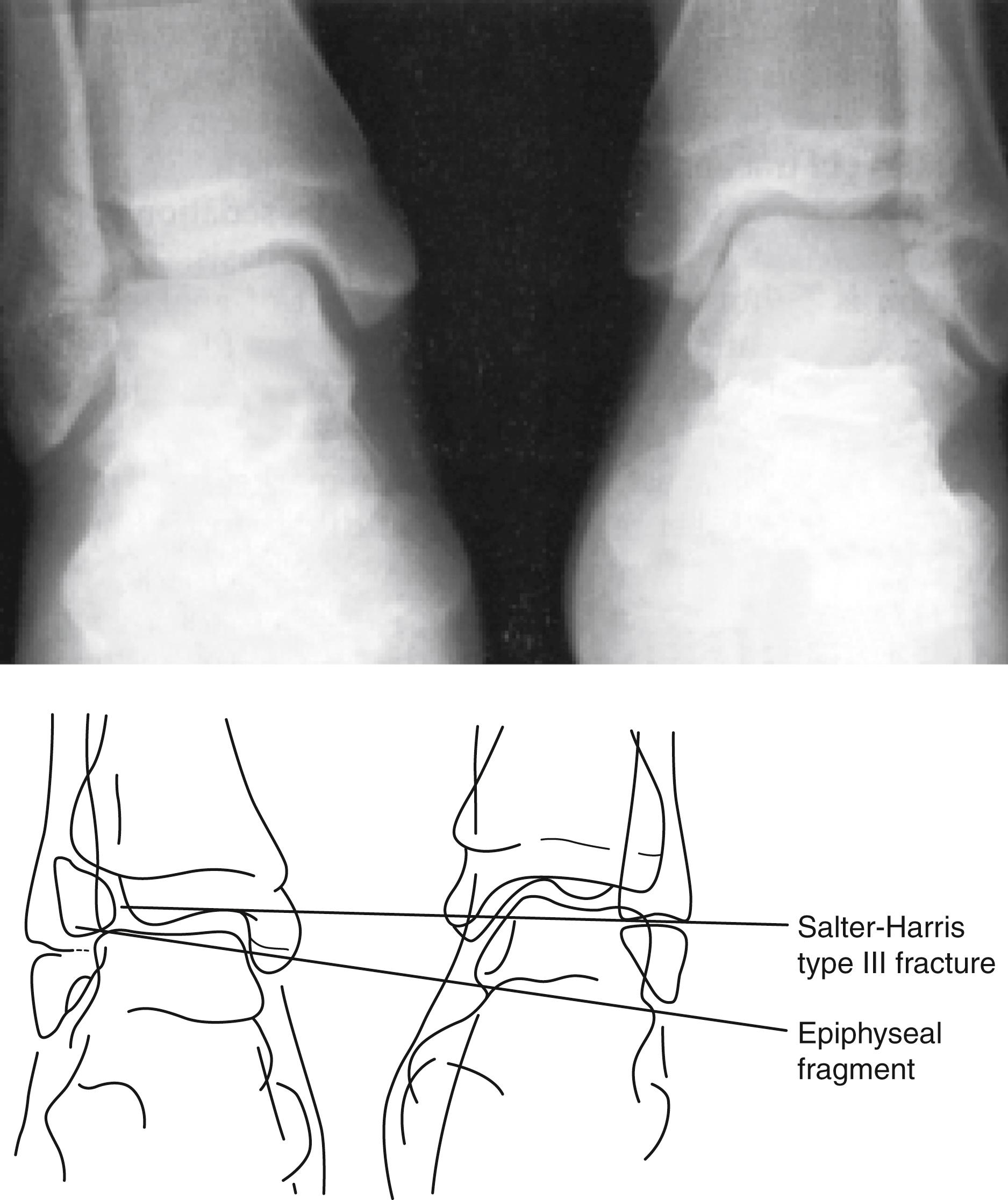
In this fracture, the fracture line starts at the articular surface, runs through the epiphysis across the physis, and exits the metaphysis. A single fragment consisting of both the epiphysis and attached metaphysis is thus created ( Fig. 22.41 ). Open reduction and internal fixation are often necessary. Growth arrest rates are usually moderate to high depending on the individual injury.
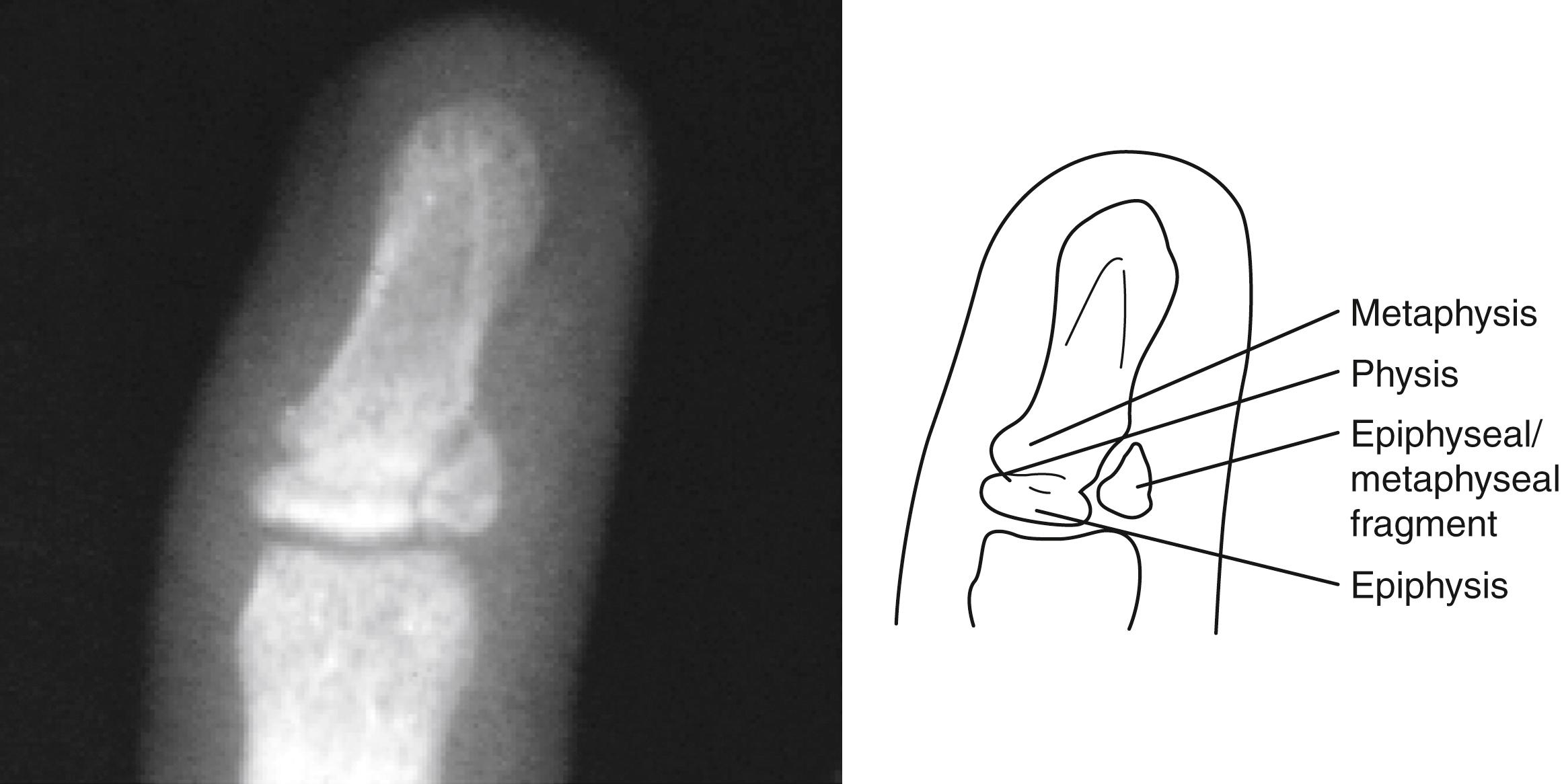
A Salter-Harris type V fracture is the product of a crushing injury to the physis without physeal fracture or displacement. Radiographic diagnosis is virtually impossible to make at the time of injury; hence this fracture must be diagnosed on clinical grounds. Distinction between Salter-Harris type I and Salter-Harris type V fractures is often possible only when a subsequent growth abnormality has been appreciated. These injuries have a 100% growth arrest rate ( Fig. 22.42 ).
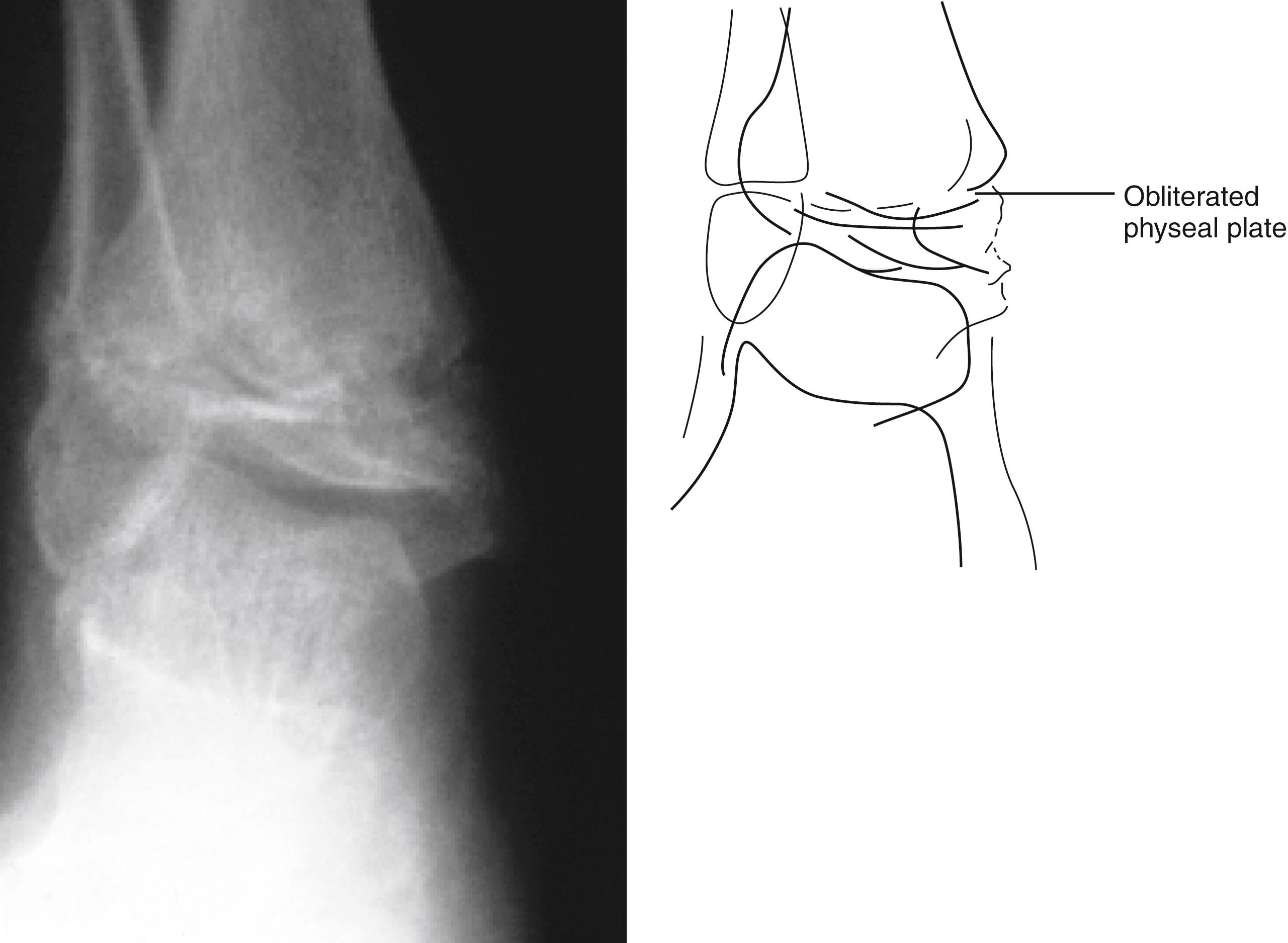
The healing and remodeling capacity of the growing bones of a child is considerably greater than that of an adult; the younger the child and the closer the fracture to an active physis, the greater the capacity for regeneration. As a result, healing is rapid, necessitating a shorter period of immobilization; nonunion is rare. In planning fracture reductions, the remodeling capability and the likely addition to bone length as a result of overgrowth must be considered. For example, in managing a toddler with a femur fracture that is displaced in the plane of motion of the adjacent joint, the bone ends must overlap to account for overgrowth and a degree of angulation can be accepted because this will ultimately be corrected by remodeling. The amount of angulation and the degree of overlap of fracture fragments that can be accepted are difficult to state in numeric terms. Acceptable position is determined in part by the child’s age, the nature and position of the fracture, the bone involved, the appearance and condition of the adjacent soft tissues, and the presence or absence of other systemic injuries. Remodeling has its limitations, however. Rotational deformities and angular deformities that are not in the axis of adjacent joint motion are not effectively remodeled. Growth plates that are not as active as others may not have sufficient growth remaining to complete remodeling. Thus, these must be corrected at the time of initial fracture reduction.
Nondisplaced fractures are simply casted or splinted. Because of the relative rarity of ligamentous injuries before epiphyseal closure, patients with an appropriate clinical history and point tenderness over a physis are presumed to have a fracture and should be treated accordingly, even if radiographs are normal. Most displaced fractures in long bones as well as Salter-Harris types I and II physeal fractures can be treated by closed reduction and casting. As a general rule, open reduction and internal fixation are needed for the management of Salter-Harris type III and type IV fractures, certain open fractures, and fractures associated with neurovascular compromise. Depending on the time of presentation, degree of displacement, and severity of soft tissue swelling, reduction, casting or surgical treatment may have to be deferred pending the subsidence of edema.
After reduction and/or immobilization in a cast or splint, pain should be markedly alleviated, although some analgesia is likely to be necessary for 3 to 4 days. Closed treatment of fractures in children almost never requires oral narcotics at home and these should not be prescribed. Ibuprofen has been proven to provide adequate pain control post-closed reduction and should be used in alternation with acetaminophen in the absence of medical contraindications. No negative impact of ibuprofen on fracture healing in children has been reported.
Persistence or recurrence of considerable discomfort after appropriate treatment of fractures signifies a complication and warrants prompt reevaluation. Splints and casts must be reexamined and loosened immediately in the case of tight application as these may cause compartment syndrome. The consequences of a loss of reduction pale next to the consequences of untreated compartment syndrome. Patients complaining of heel pain after application of lower extremity splinting must be taken seriously, the splint or cast removed and the heel assessed for ulcers before reapplication of one with better padding and technique.
Care must be taken in describing the nature of the injury and its prognosis and in explaining the rationale for proposed treatment measures to the parents. A simpler explanation in terms geared to his or her developmental level should be given to the child. Written instructions regarding home care measures, necessary parent observations, and worrisome signs that signal the need for prompt reevaluation are invaluable.
Fractures of the clavicle are common. They are caused by lateral compression forces (as can occur in the process of delivery of the newborn or in falls onto the shoulder), by transmission of forces through the glenohumeral joint in a fall to the side on an outstretched arm, or occasionally by a direct blow or impact on the clavicle itself. Most involve the mid shaft or distal clavicle (see Fig. 22.20 ). Clinically, the child complains of pain in the shoulder, is noted to avoid moving the arm on the involved side, and often splints it by holding the arm close against the chest. Tenderness and mild swelling are evident on palpation of the fracture site. Complications are rare, and treatment consists of measures to decrease pain while the fracture heals such as swathing, sling or a figure-of-eight splint for 2 to 3 weeks. Adolescents near skeletal maturity with severely displaced clavicle fractures may require a discussion of surgical treatment. Forewarning parents that a hard bump will appear as the fracture heals and that this is due to callus formation is advisable because the clavicle’s superficial location makes the site of callus formation prominent. Medial clavicular fractures are rare and are caused by high-impact forces and often are associated with injuries of mediastinal structures. Thus, they warrant meticulous evaluation including chest CT and often angiography. Fractures involving the distal tip of the clavicle in infants (beyond the neonatal period) and toddlers are likely to be the result of abuse (see Chapter 6 ).
One of the most common orthopedic injuries seen in children between 1 and 5 years old is the toddler’s fracture. The child usually has a sudden onset of refusal to bear weight on one leg or of an antalgic limp immediately following a traumatic event. The mechanism is often twisting of the leg; the child may fall with the leg caught under the body, or the leg may be caught while traveling down a play slide in an adult’s lap. Not uncommonly, the actual fall is unwitnessed, and the parents are unsure about the nature of the accident. The injury results in a spiral or short oblique fracture of the distal tibia or the junction of the mid and distal tibia ( Fig. 22.43 ). Because the thick periosteum tends to be only partially disrupted, soft tissue swelling is often minimal and tenderness may be subtle. Furthermore, many of these fractures are radiographically invisible or so subtle as to be difficult to detect; treatment is based on clinical presentation.
Treatment consists of either long- or short-leg casting for approximately 4 weeks. Infection must be included in the differential diagnosis of the limping child in this 1- to 5-year-old age group but usually can be ruled out by lack of fever, absence of local erythema, and normal blood values. If there is no clear history of a fall, only a mild limp, no evidence of localized tenderness, and radiographs are normal, it may be best to defer treatment and observe the child closely.
Supracondylar, condylar, intercondylar, and epicondylar humerus fractures and proximal radius and ulna fractures all involve the elbow, and the major mechanism is a fall onto the outstretched arm. In a young infant, a fracture through the cartilaginous portion of the distal humerus at the level of the condyles is known as a transphyseal separation and may appear like an elbow dislocation on plain films. Given the force necessary to cause these fractures, when they are seen in an infant who is not yet standing and walking, nonaccidental trauma must be suspected ( Fig. 22.44 ).
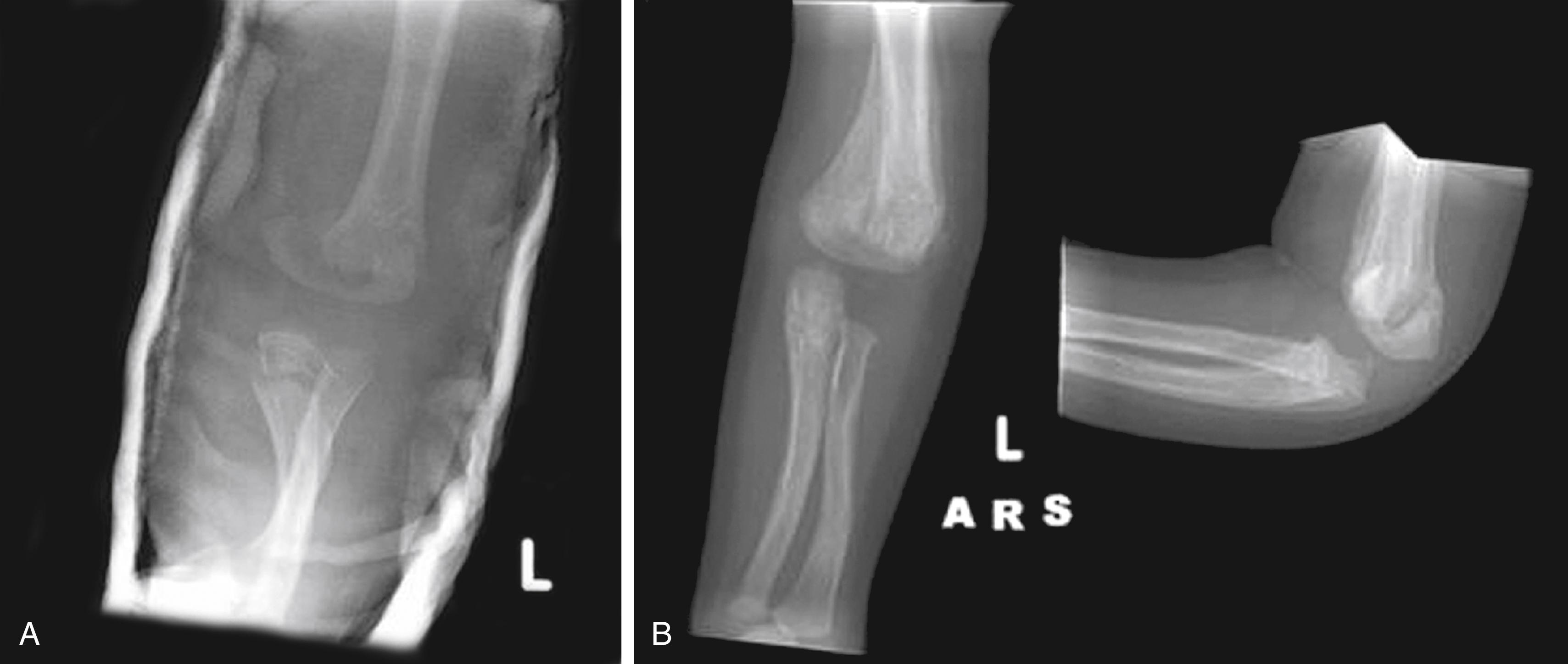
Supracondylar fractures account for about 50% of elbow injuries and usually result from a fall onto an outstretched hyperextended arm, which typically results in some degree of posterior displacement of the distal humeral fragment (see Fig. 22.34 ). A grading system, developed by Gartland and useful in describing severity of injury, includes the following: type 1, nondisplaced; type 2, partial displacement with intact posterior cortex; and type 3, displaced with complete disruption of the posterior cortex. The exceeding majority of these injuries are accidental in nature. More rarely, a direct blow to the point of the flexed elbow is the cause, in which case the distal fragment is hyperflexed. Pain, swelling, and tenderness are most prominent over the posterior aspect of the distal humerus. A significant risk of associated neurovascular injury exists in patients with such fractures. Most type 2, all type 3 and flexion-type supracondylar fractures will require surgical treatment.
Lateral condylar fractures are in part interarticular (see Fig. 22.33 ). Typically, they result from a fall onto an extended and abducted arm. Swelling and tenderness are prominent over the lateral aspect of the elbow. If displaced, these fractures will require open reduction as they involve the joint surface.
Medial epicondylar fractures stem from falls in which the elbow is hyperextended and abducted from the body, subjecting it to a valgus stress (see Fig. 22.35 ). They are also commonly seen in association with elbow dislocations. These children have swelling and tenderness centered over the medial aspect of the elbow. Surgical treatment may be appropriate in certain cases.
Radial head and neck fractures are usually the result of a fall onto an outstretched, supinated arm ( Fig. 22.45 ). Local swelling and tenderness are centered over the proximal radius, although pain is often referred to the wrist. The proximal radial growth plate only contributes 20% of length to the radius and therefore has very limited remodeling capacity, necessitating surgical treatment in certain radial neck fractures.
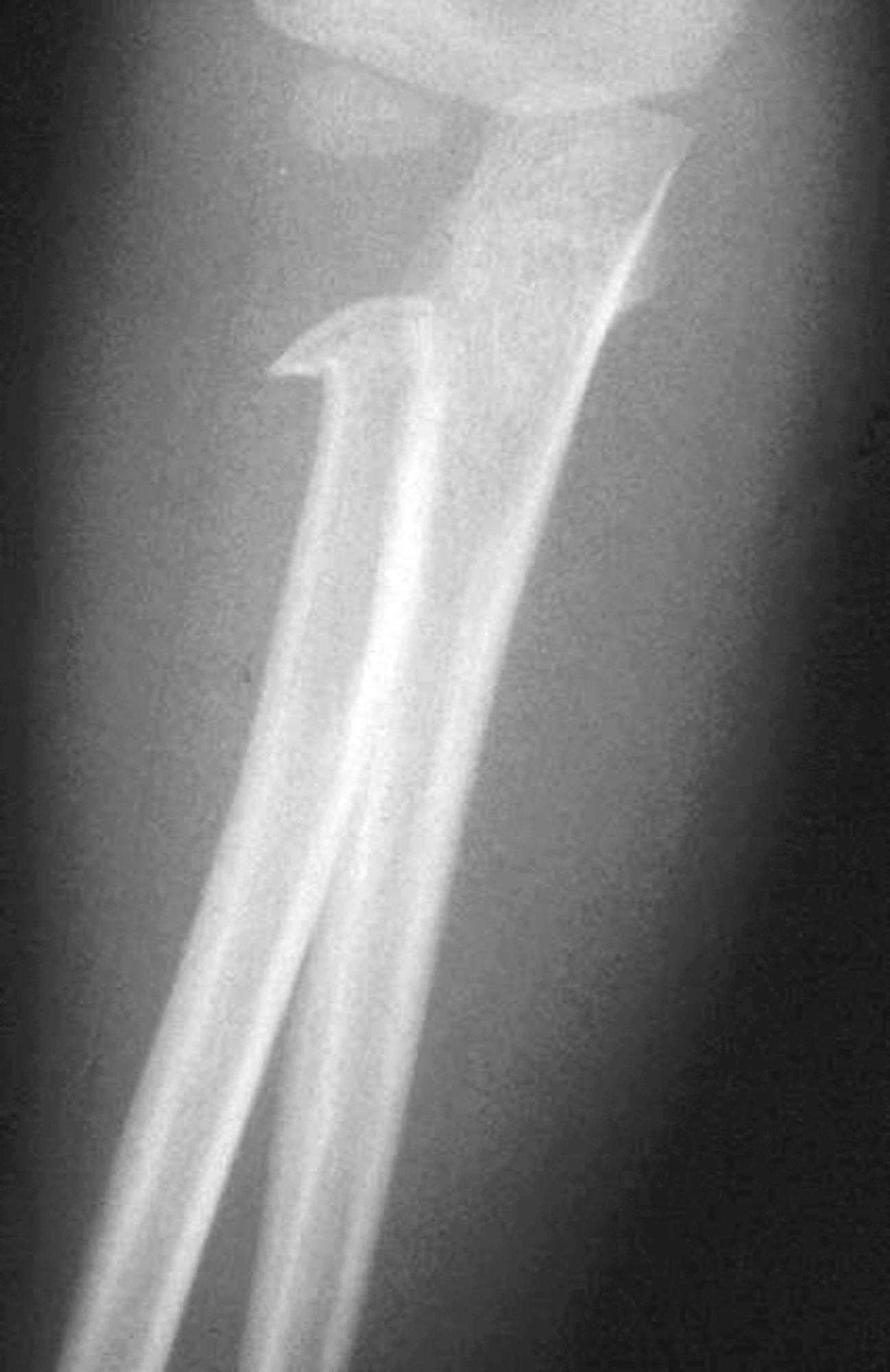
The Monteggia fracture-dislocation is a special injury which occurs due to the close interrelation of the radius and ulna. In this injury, the ulna alone is fractured or plastically deformed, with energy dissipation through the radiocapitellar joint thus resulting in a subluxation or frank dislocation here. A high index of suspicion along with dedicated, high-quality elbow x-rays in the setting of forearm fractures are key in diagnosing this special entity, which, if missed, will result in a poor functional outcome.
Radiographic findings in patients with fractures about the elbow can be subtle, and oblique and comparison views may be necessary to reveal them. Key signs suggestive of a fracture in the absence of fracture lines are the posterior fat pad sign and displacement of the anterior humeral line. The fat pad sign consists of the upward and outward displacement of the posterior fat pad of the distal humerus ( Fig. 22.46A and B ; see Fig. 22.34B ), which is normally invisible. The finding of a fat pad indicates the presence of a hemarthrosis, often due to a nondisplaced fracture, and should warrant long-arm immobilization with splint or cast. The anterior humeral line is a line drawn through the anterior cortex of the humerus and normally intersects the middle third of the capitellum and shifts in fractures where the distal portion of the humerus is displaced posteriorly (see Fig. 22.46B ).

Although a complete discussion of the examination of the hand and hand injuries is beyond the scope of this chapter, several key points require emphasis to prevent long-term dysfunction (see Figs. 22.87 and 22.88 ).
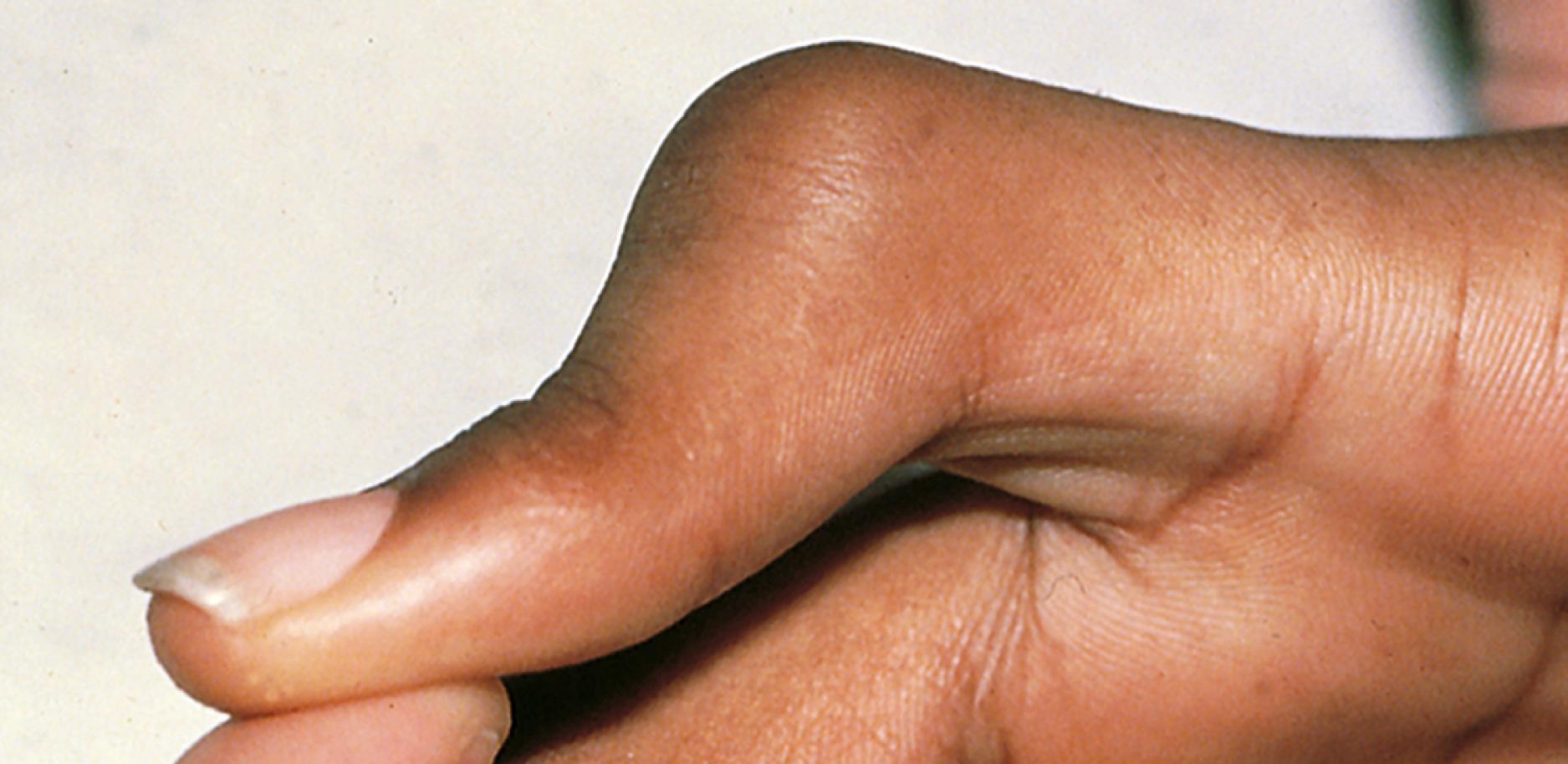
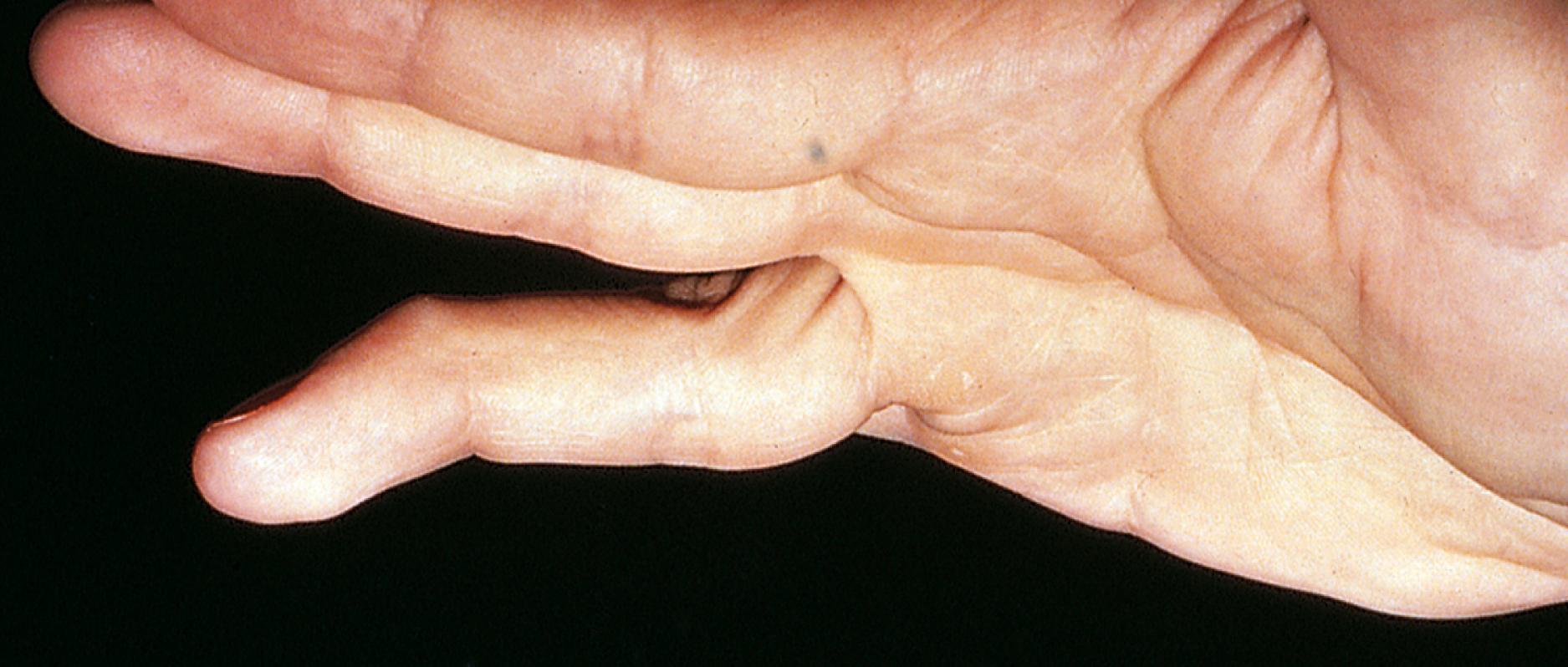
Common mechanisms of injury in the phalanges include crush injuries (finger caught in a door, objects falling), contact sports and fist fights. Patients will present with swelling, bruising and tenderness localized to the injured area of the finger. Appropriate examination will begin with the observation of the patient’s hands at rest and noting differences between the injured digit and its uninjured counterpart. Fractures causing significant deformity must be appropriately reduced to prevent long-term problems ( Fig. 22.47 ). Comparison of the planes of the fingernails of both hands with the forearms supinated and the fingers partially flexed is particularly useful in detecting rotational abnormalities ( Fig. 22.48 ). Fractures associated with deep lacerations must be evaluated for tendon rupture and circulation distal to the wound. In older children, flexion and extension of the digits should be tested individually with the others held immobile. Flexor digitorum profundus function can be assessed with immobilizing the finger at the middle phalanx and evaluating flexion of the distal interphalangeal joint.
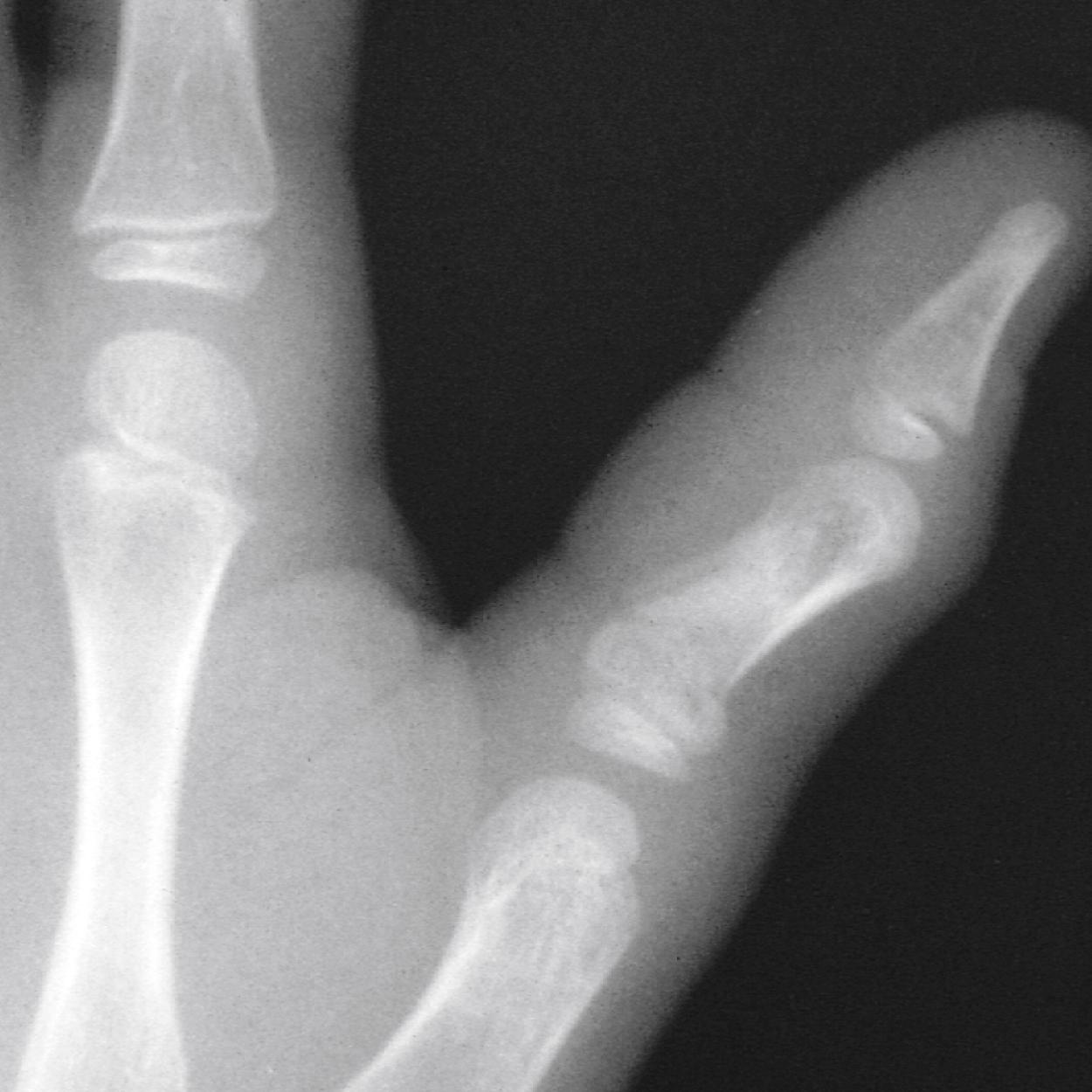
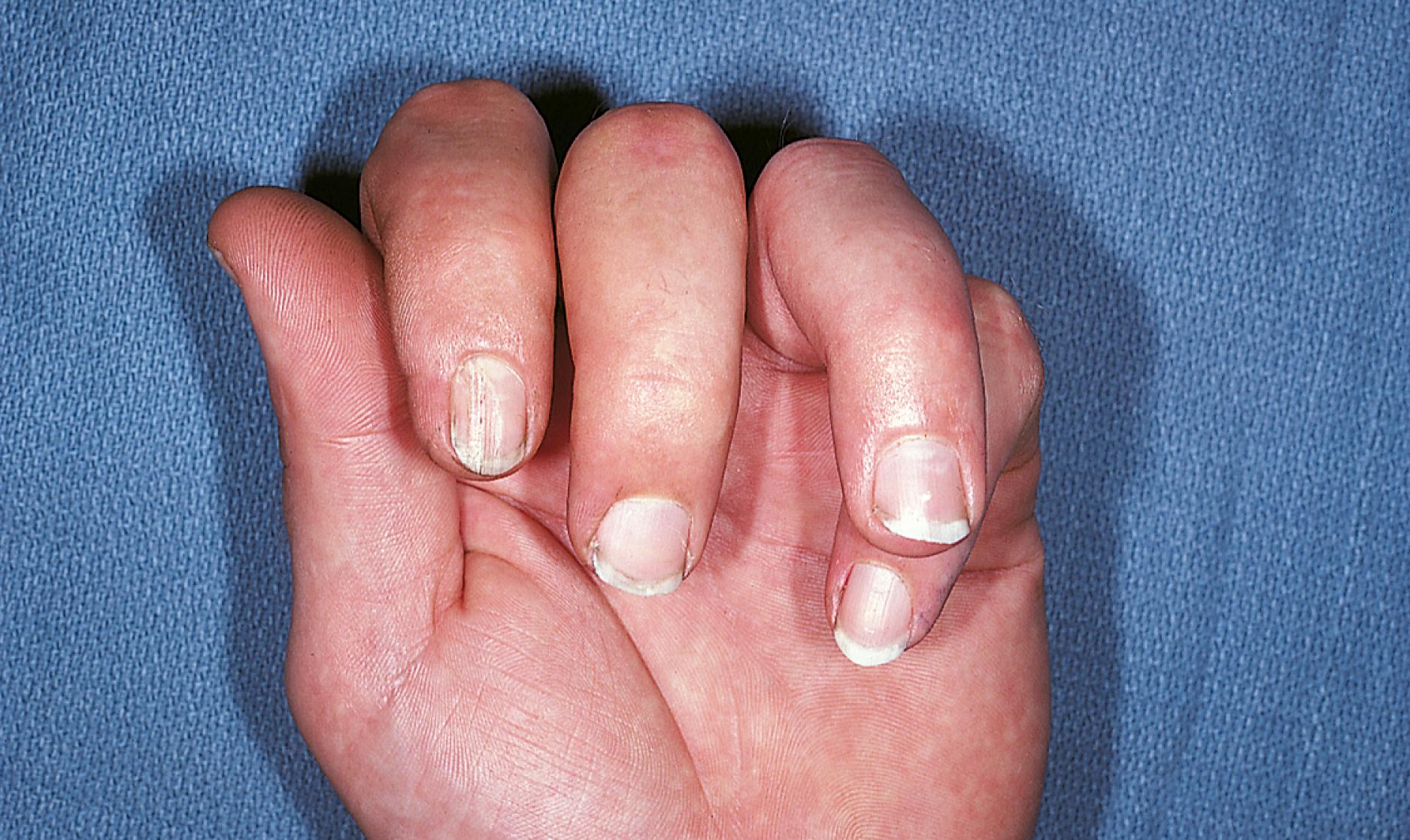
Meticulous attention must be paid to the assessment of neurovascular and tendon function to detect subtle abnormalities that may reflect significant injury. Clinically, an extensor tendon injury may be manifested by flexor tendon overpull ( Fig. 22.49 ), and conversely, flexor tendon injuries may result in extensor overpull (see Fig. 22.7 ). This can be difficult in young children. However, much information can be gained from observing the position of the hands at rest and during spontaneous movement, as well as by watching motion as the parent hands objects to the child.
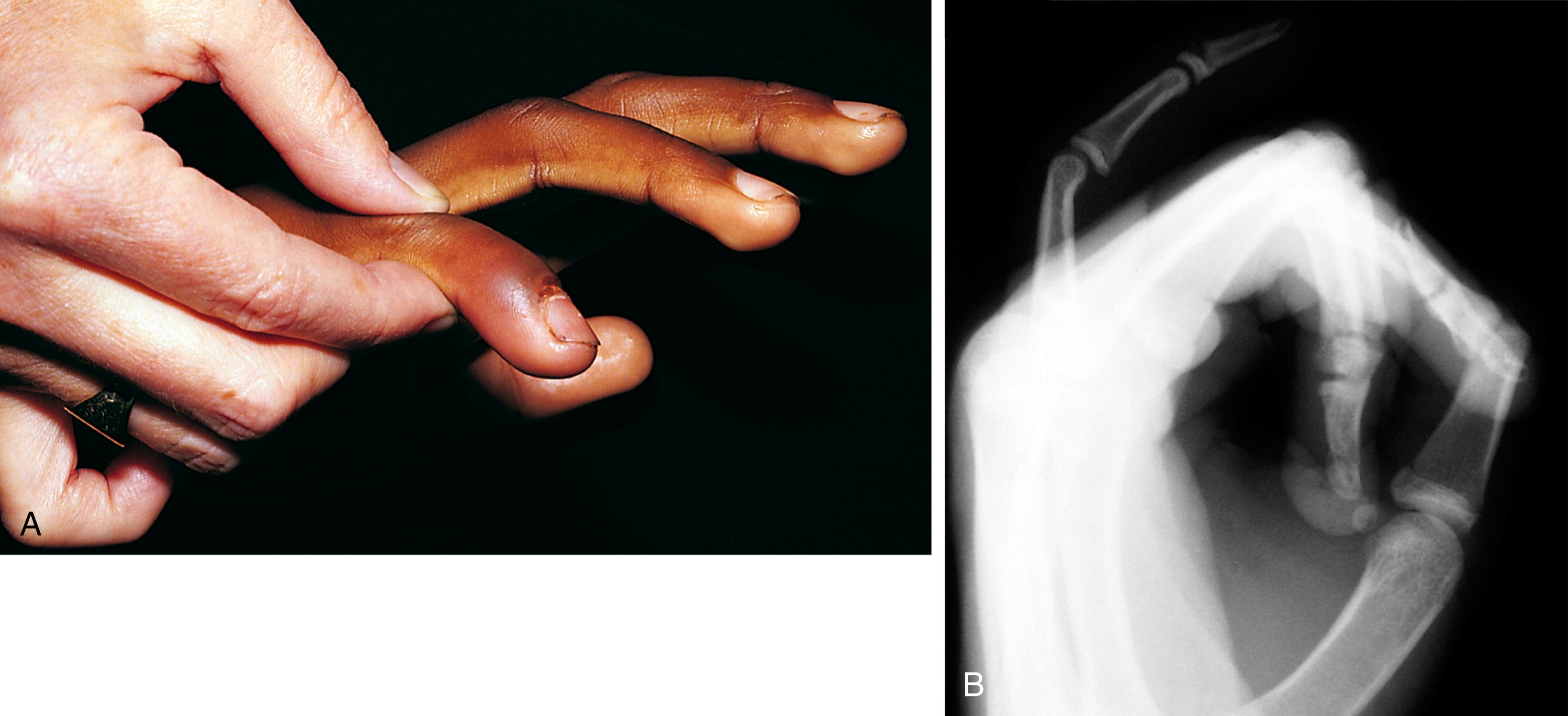
Radiographs are key in the evaluation of phalangeal fractures. Anteroposterior, lateral and oblique views are essential and comparison views may provide additional information.
Growth plate fractures of the phalanges are common and rarely result in significant growth arrest. Salter-Harris type II fractures of the middle and proximal phalanges, provided adequate alignment is achieved with reduction, can be treated symptomatically with casting, finger splints or buddy taping. Significantly displaced growth plate fractures of the distal phalanx, especially those where there is a laceration near the nail bed, may signify a special injury with the eponym “Seymour’s Fracture.” These are open fractures of the distal phalanx and must be treated with appropriate irrigation and debridement, reduction and repair of the nail bed, and post-procedure antibiotics. Other crush injuries of the distal phalanges associated with partial or complete nail avulsions may also result in open fractures and lacerations of the nail bed ( Fig. 22.50 ) and should be treated similarly.
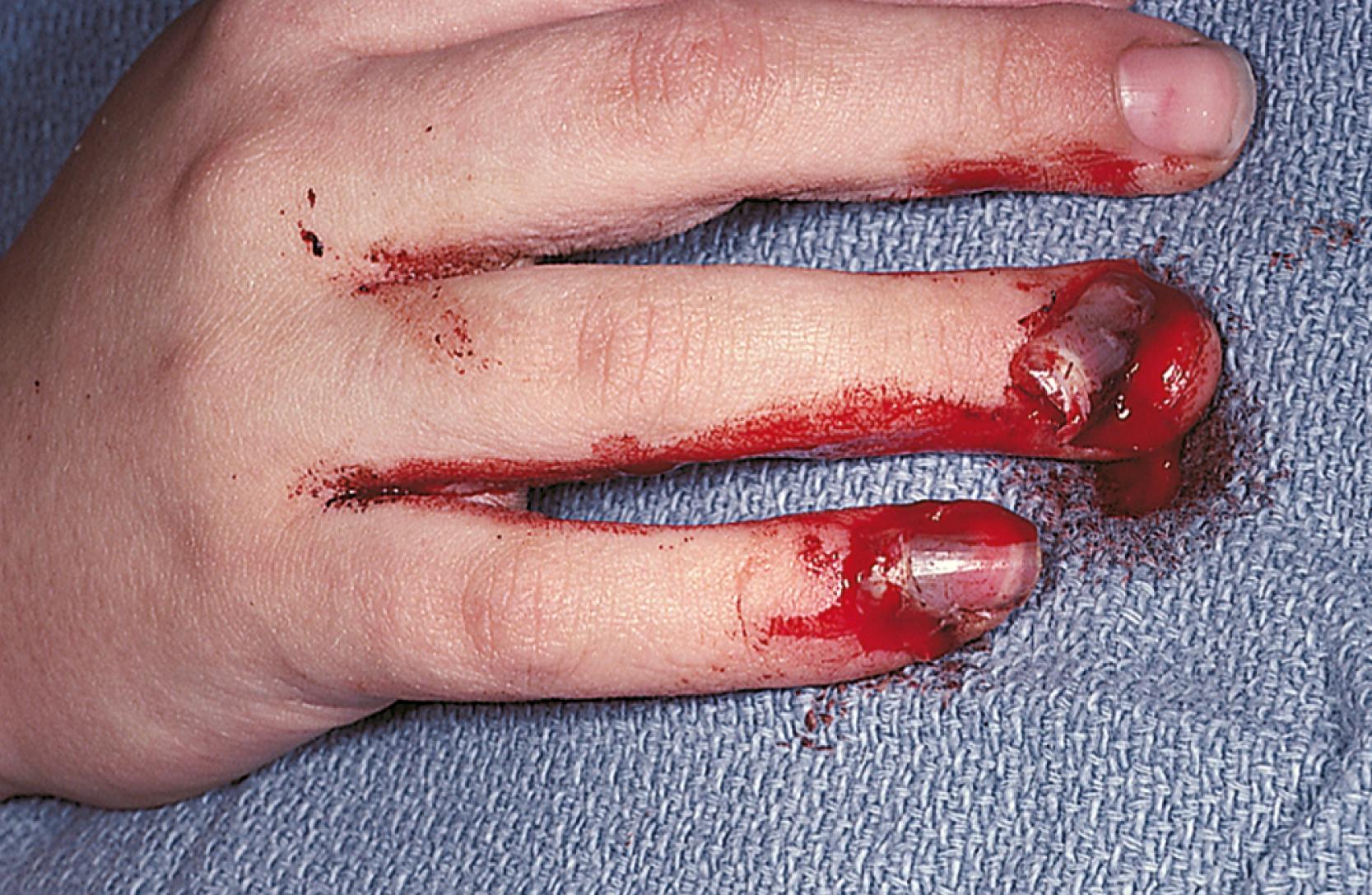
Fractures near the phalangeal condyles (phalangeal neck) are rarer patterns but important to recognize as, while appearing minimally displaced on radiographs, they cause significant rotational deformity of the digit. Similarly, intraarticular fractures will require anatomic reduction and can benefit from a referral to the orthopedic or hand surgery service.
The volar plate is a cartilaginous plate located at the base of the middle phalanx of each finger. It may easily cause an avulsion type fracture in injuries with a hyperextension mechanism. Clinically, pain and swelling are especially marked over the volar aspect of the PIP joint. The vast majority of these are benign injuries and as long as there is no hyperextension deformity of the involved PIP with fingers extension, or locking with flexion, can be treated symptomatically. Volar plate injuries may also accompany dislocation of the PIP joint (see the Ligamentous Injuries section, later).
The boxer’s fracture, an impacted fracture of the neck of the fifth and often the fourth metacarpal, is among the most common of these injuries ( Fig. 22.51 ). It occurs as a result of direct impact with a partially clenched fist (typically resulting from punching another person or a wall) and is most commonly seen in adolescents. Less commonly, it can also result from a fall onto a clenched fist. Clinically, depression of the involved knuckle or knuckles may be noted, along with more proximal swelling and discoloration. The involved metacarpals may also appear shortened. An associated rotational deformity, if present, is manifested by rotation of the nails of the corresponding fingers (see Fig. 22.48 ). If the injury stems from punching another person in the mouth, care must be taken to check for overlying breaks in the skin caused by the opponent’s teeth. These are infection-prone wounds and may communicate with metacarpophalangeal joints. Radiographically, volar angulation of the distal segment is typically found. If this exceeds 15 to 20 degrees or a rotational deformity is noted, the patient should be referred to an orthopedist or hand surgeon for reduction. Nondisplaced, minimally angulated fractures can be treated with an ulnar gutter splint.
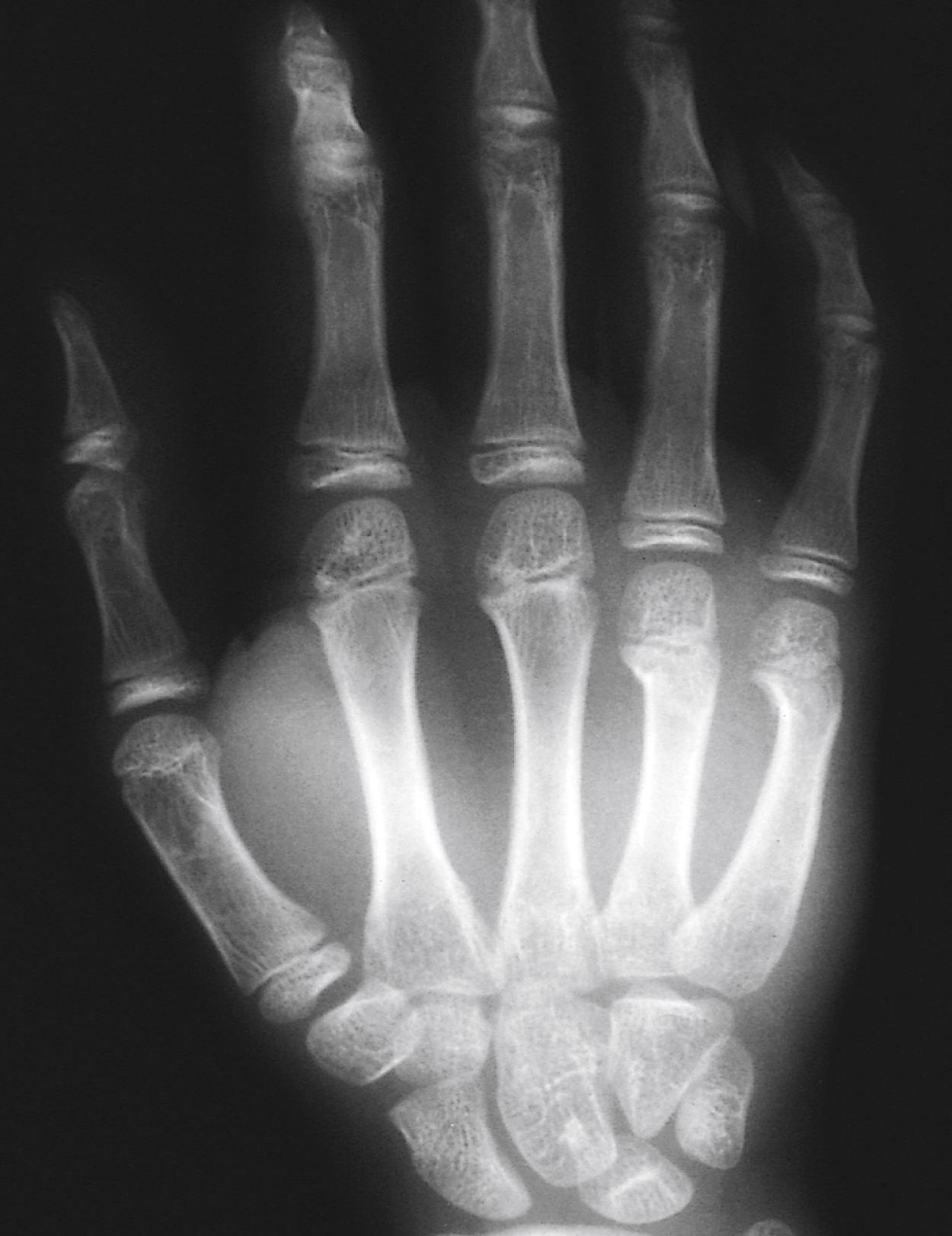
Most metatarsal fractures are the result of a heavy object dropping onto the foot and thus are crush injuries. Falls in which the patient twists the forefoot or in which the forefoot is caught in plantar flexion can produce transverse fractures ( Fig. 22.52 ), and injuries of the foot with the ankle inverted and the foot in plantar flexion can avulse the tuberosity from the base of the fifth metatarsal. Mild, localized swelling and point tenderness are noted over the site of a metatarsal fracture; weight bearing is painful, if not impossible. A short-leg cast or controlled-ankle motion (CAM) boot provides maximal relief. This must be distinguished from the normal finding of a secondary ossification center, which is called the os vesalianum, at the base of the fifth metatarsal. Absence of point tenderness on examination can help differentiate ( Fig. 22.53 ).
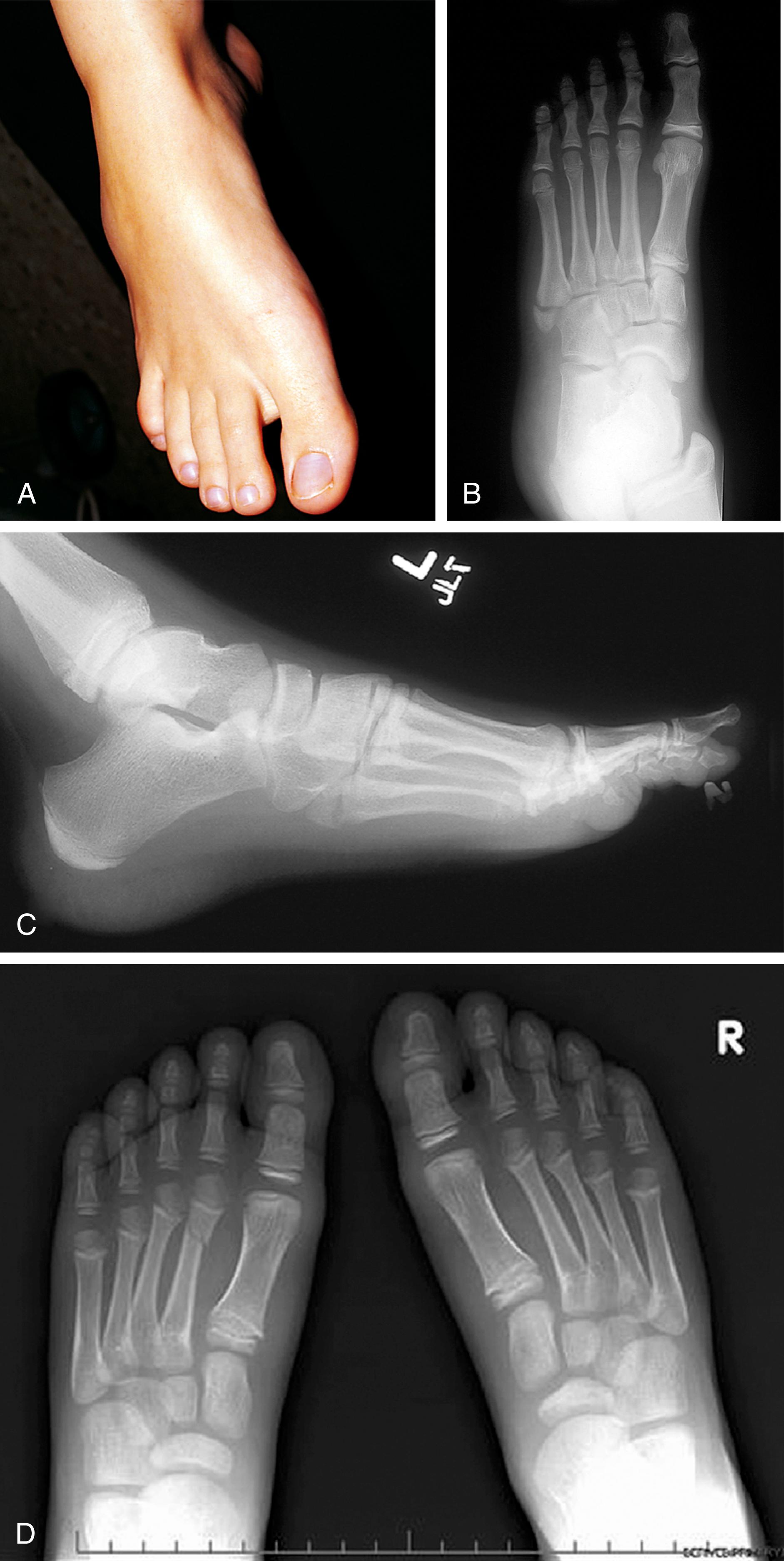
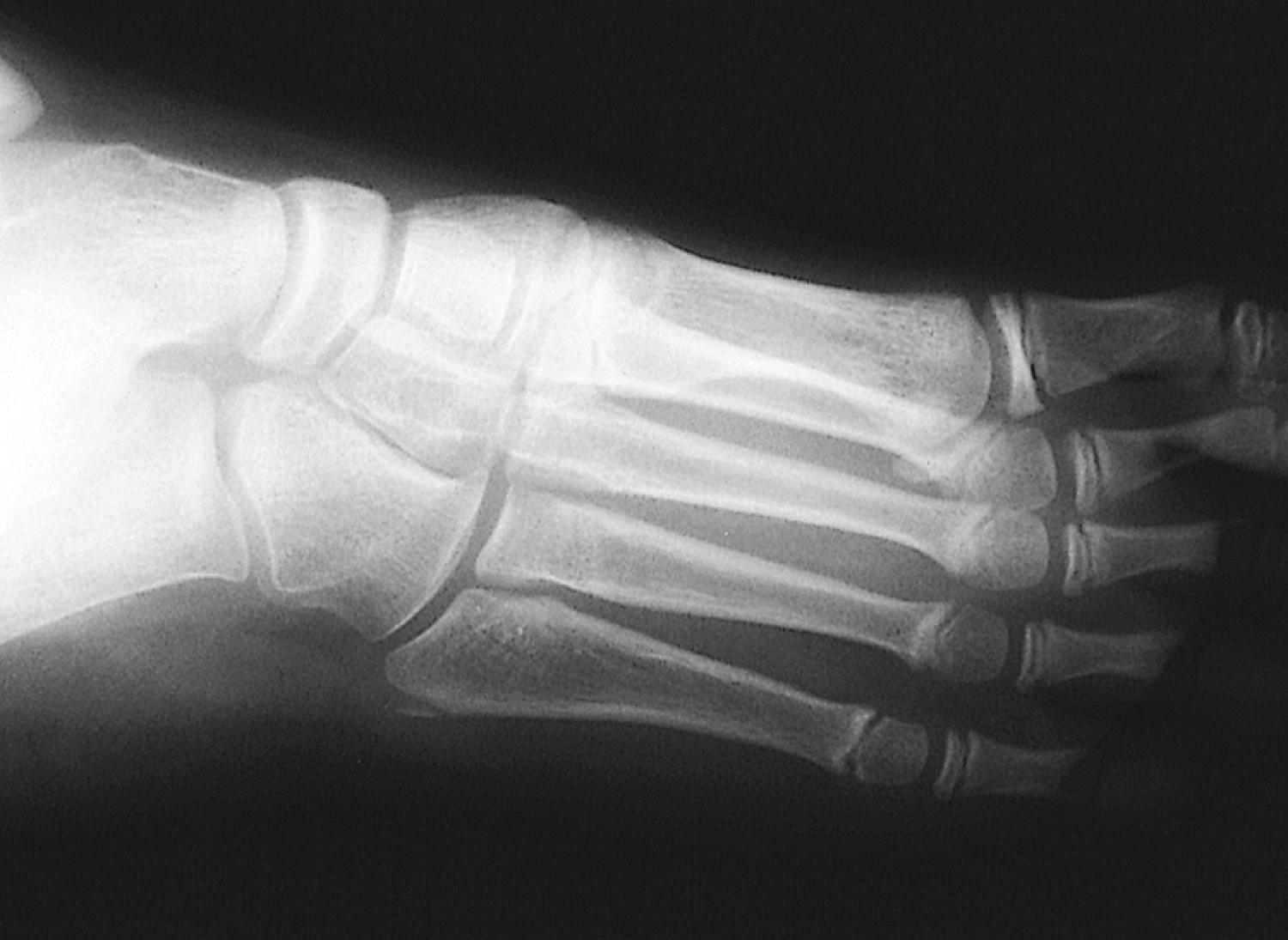
The use of seat belts to prevent serious multiple trauma in auto collisions has resulted in an increase in the incidence of lap belt fractures in children. In a head-on collision, the head and torso of a child wearing only a lap belt are thrown forward, resulting in hyperflexion of the lumbar spine over the fulcrum of the lap belt and often causing a flexion/distraction injury. This may produce a compression fracture of a lumbar vertebra or, more likely, a shear fracture through the body of the vertebra, as well as the pedicle and spinous process. This is best seen on a lateral radiograph of the lumbar spine ( Fig. 22.54 ). An anteroposterior view of the spine may show lateral displacement of a portion of the involved vertebral body. Because the fulcrum of the injury is anterior where the lap belt contacts the anterior abdominal wall, this injury produces a characteristic rectangular bruise and abrasion over the lower abdomen. Associated intraabdominal injury, especially a ruptured viscus, is common, and the resultant abdominal pain may overshadow that of the vertebral injury. Hence whenever a lap belt bruise is seen during the physical examination, great care should be taken in palpating the back for localized tenderness or spasm, and immobilization of the torso and lower back should be maintained until CT scan of the lumbar spine is obtained.
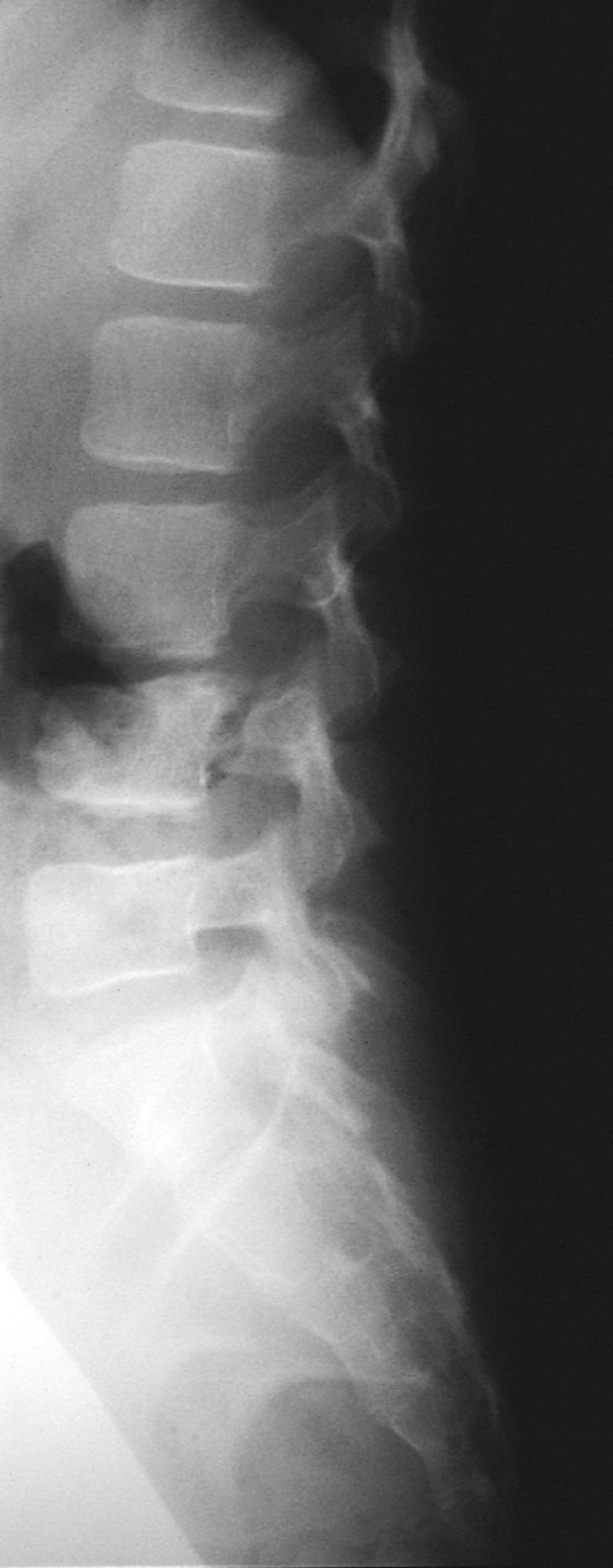
Pelvic avulsion fractures are a phenomenon unique to adolescents, with a peak occurrence between 13 and 14 years old in girls and 15 and 17 years old in boys. This stems from the fact that the secondary centers of ossification in these young people have not yet fused to the pelvis. These fractures are typically seen in adolescents who are involved in competitive sports, especially track and field (e.g., sprinting and jumping), soccer, and football, but household falls and collisions may also be the cause. Most result from a sudden, violent muscular contraction while the ipsilateral extremity is held in a static position or when a muscle is suddenly lengthened during isometric contraction. As the muscle power exceeds the strength of the tendinous unit, it is torn from the apophysis or secondary ossification center. Avulsion fractures of the ischial tuberosity are the most common. They tend to occur during sprinting and are due to the sudden, powerful contraction of the hamstring muscles when the hip is flexed and the knee extended (see Fig. 22.55A ). Avulsions of the anterior inferior and anterior superior iliac spines ( Fig. 22.55B and C ) are caused by strong contractions of the rectus femoris and sartorius muscles, respectively. These, too, tend to happen during running, often during an abrupt directional change. Some cases of anterior inferior/superior iliac spine avulsions occur with kicking. At the time of injury, the patient experiences sudden pain at the site and difficulty walking. On examination, point tenderness and swelling are noted over the involved apophysis and weakness on active hip motion is seen secondary to pain.
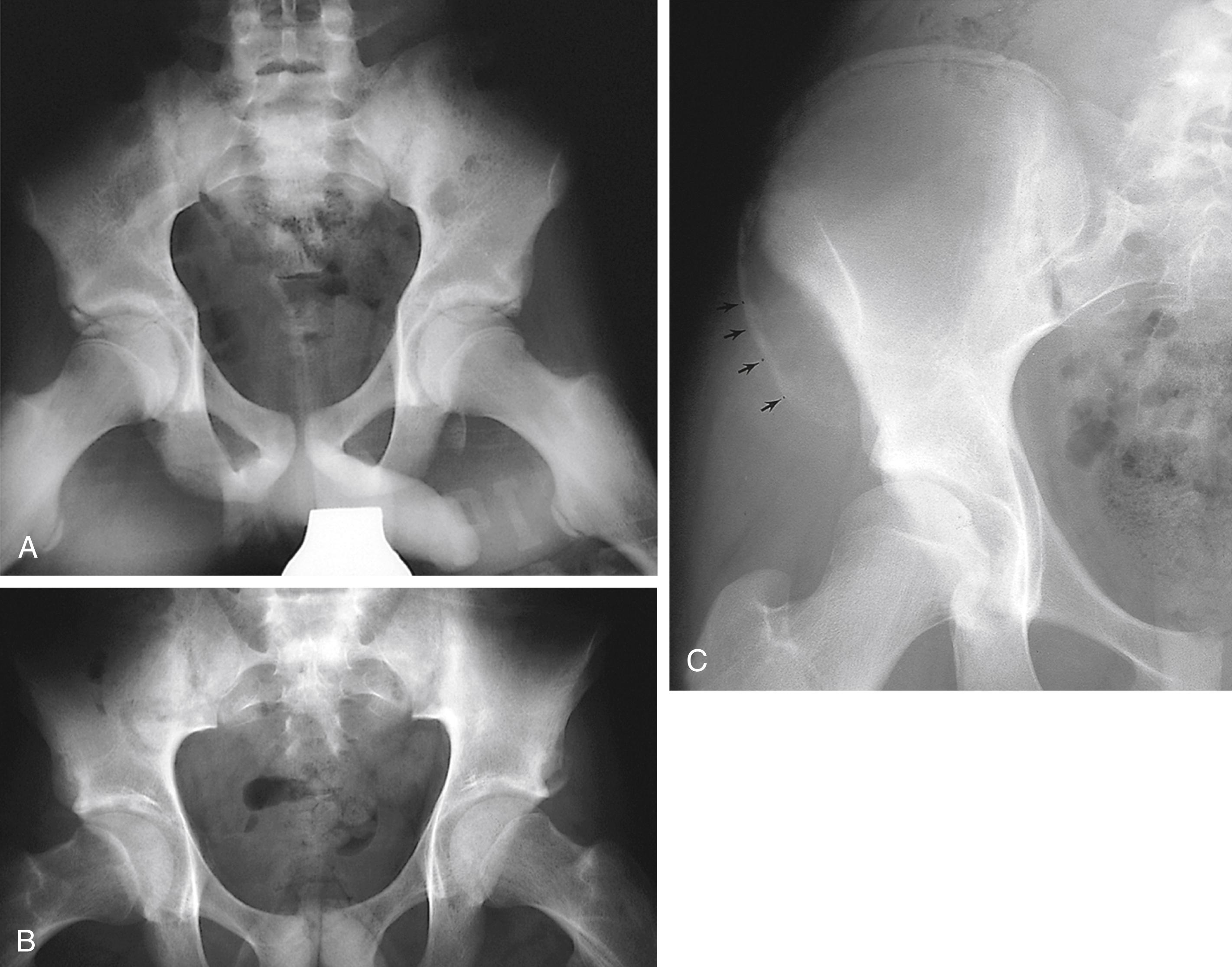
In viewing radiographs, it is important to compare the involved side with the normal side to detect displacement of the avulsed fragment and to avoid mistaking a normal apophysis for a fracture.
Treatment is conservative and consists of a few days of bed rest until the pain subsides, followed by 2 to 6 weeks of crutch-walking, with a gradual increase in weight bearing as pain allows. Thereafter, careful reconditioning facilitates a safe return to full activity, usually within 6 to 10 weeks.
Children with severe osteopenia or osteoporosis, whether stemming from an inherited disorder or disuse secondary to neurologic or neuromuscular disease, are at considerably increased risk of incurring fractures as the result of minor falls or even during routine physical therapy exercises. Localized bone lesions, including those caused by osteomyelitis, tumors, or cysts, can cause localized cortical thinning as they expand. Impact on the involved bone can then also result in a pathologic fracture. Examples of some of these conditions and representative fractures are presented in Chapter 6 .
Compartment syndrome arises whenever the interstitial tissue fluid pressure exceeds the capillary perfusion pressure within a muscle compartment. In clinical practice, the interstitial pressure elevation must reach approximately 35 to 45 mm Hg for this to occur. Because the enclosed fascial boundary of the involved muscle compartment is unyielding, hemorrhage or edema within it can cause interstitial pressure to rise to such levels, resulting in muscle ischemia and neurovascular compromise. Compartment syndromes are not rare in childhood and can be seen after open or closed fractures, crush injuries, prolonged pressure on an extremity, which can occur in a comatose child who has been lying on an extremity for several hours, and extravasation from vascular lines. Anatomically, it is more likely to occur in the forearm or lower leg, complicating fractures of the tibia, the forearm and supracondylar humerus. Open fractures are just as likely as closed fractures to result in compartment syndrome due to higher energy mechanisms of injury. This may appear counterintuitive; however, the wound associated with the open fracture is rarely large enough or anatomically oriented to effectively decompress the fascial compartment.
Prompt and accurate diagnosis of a compartment syndrome is essential because permanent neuromuscular damage will result if definitive treatment is not implemented within 4 to 6 hours of onset. The clinical findings in compartment syndrome are classic in the alert patient. There will be severe pain that is unrelieved by elevation and immobilization, resulting in a spike of narcotic requirement. The patient will be agitated and difficult to distract. The involved extremity is swollen and tense to palpation. Passive movement of the terminal digits (fingers or toes) exacerbates the pain, and active motion is avoided. Pulselessness is a very late finding and should not be required for diagnosis. In the uncooperative, younger child or in obtunded patients, diagnosis requires a high index of suspicion and prophylactic fascial release is often considered due to the devastating consequences of compartment syndrome if missed. Commercial devices to aid with measurement of compartment pressures exist and can aid in these instances; however, compartment syndrome remains a predominantly clinical diagnosis.
Emergency surgical decompression of the fascial covering of all involved compartments is necessary to prevent irreversible muscle and nerve damage (fasciotomy). After fascial decompression, relief of pain and return of active muscle power are immediate.
The ligaments of a child have great elasticity and are relatively strong compared with bony structures, especially the physis ( Fig. 22.56 ). Consequently, joint dislocations and ligamentous disruptions are rather unusual in childhood; when seen, they are usually the result of severe trauma and are commonly associated with fractures. In some instances, the dislocation is obvious and the fracture subtle or even invisible radiographically ( Fig. 22.57 ), but often the fracture is the prominent clinical finding and the dislocation less apparent. Hence, the emphasis in pediatric orthopedics is on examining the entire extremity and on including the joints proximal and distal to a suspected fracture site in the radiographic examination. Failure to diagnose the full extent of injury can result in permanent morbidity. It must also be remembered that in infants epiphyseal separations before ossification can simulate dislocations. For example, separation of the distal humeral epiphysis in infancy presents a radiographic picture suggestive of posterior displacement of the olecranon. The most frequent sites of dislocation in children are the hip, shoulder, elbow, patellofemoral joint, and interphalangeal joints. Shoulder and patellofemoral dislocations are discussed in greater depth in the Sports Medicine section, as these injuries are commonly encountered in young athletes.
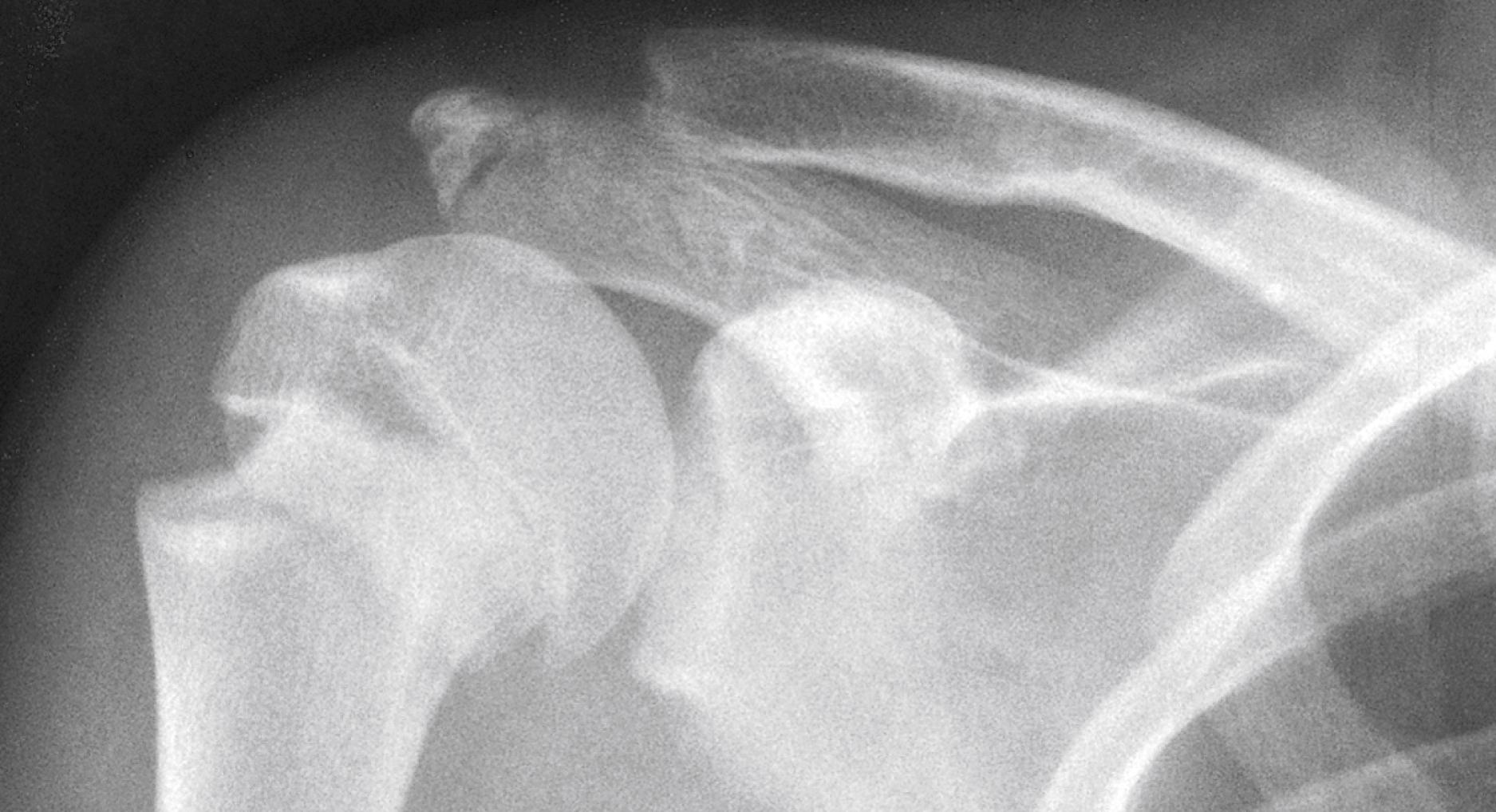
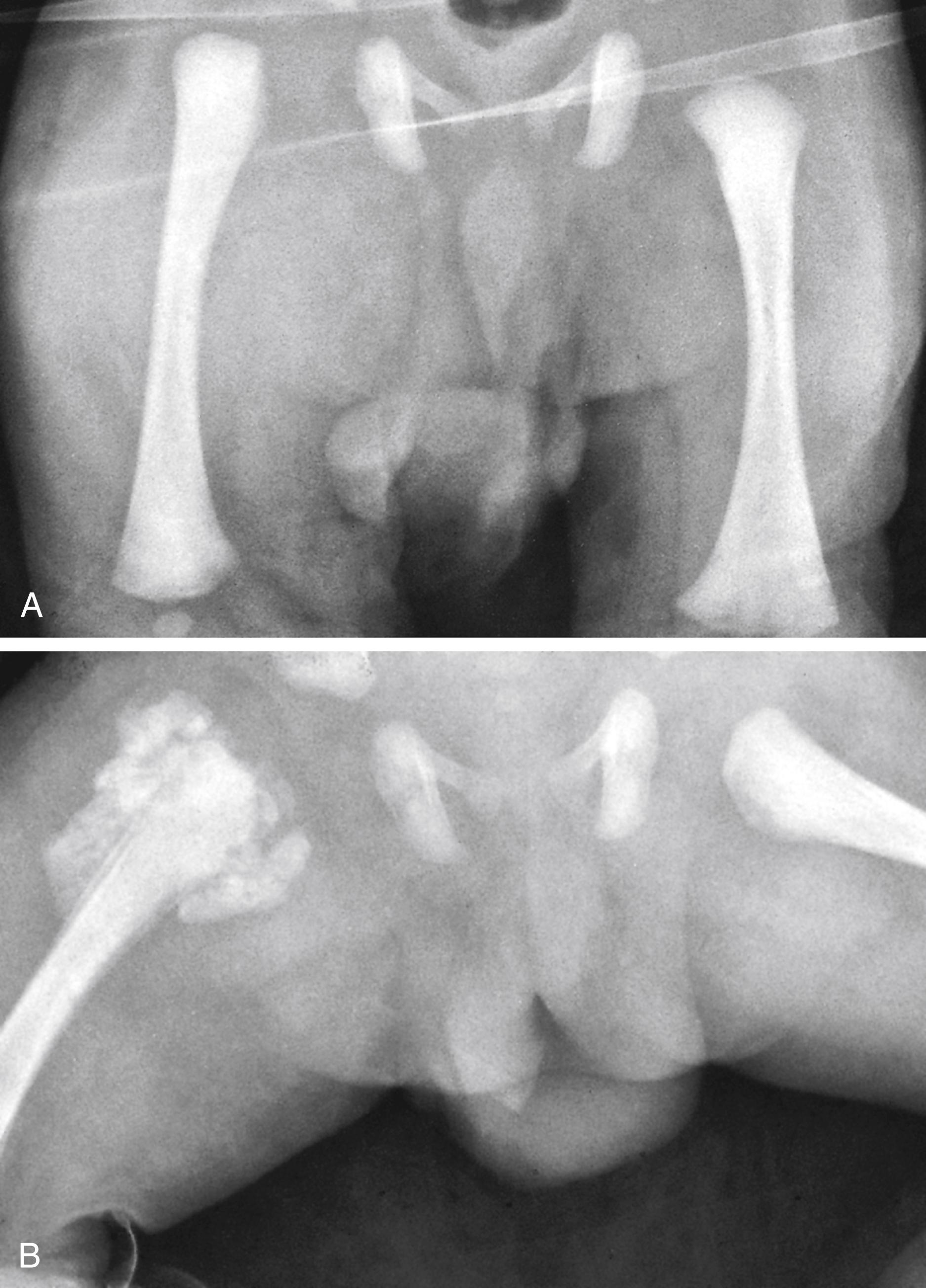
Hip dislocations in the young are usually the result of falls. In children younger than 5 years old, the softness of the acetabulum and relative ligamentous laxity enable dislocation without the application of extreme force, and thus there may be no associated fractures. In older children, violent force is required and dislocation is commonly accompanied by fractures of the femur and acetabulum. In most instances, the femoral head dislocates posteriorly. The child presents in severe pain with the involved leg held in adduction, internally rotated and flexed ( Fig. 22.58 ). A position of extension, external rotation, and abduction is adopted by patients with the less common anterior dislocation. When the child also has an impressive femoral fracture, his or her pain may be attributed to that and the positional findings missed, unless the clinician specifically looks for them. Even in patients without an obvious associated fracture, epiphyseal separation or avulsion of an acetabular fragment may have occurred. Prompt reduction is important, both to relieve pain and to reduce the risk of secondary avascular necrosis of the femoral head. Controversy exists as to where the reduction should take place, with some proponents of paralytic medications available in the operating room adding potential protection to the proximal femoral physis during closed reduction maneuvers. Postreduction films are important because these are more likely to disclose the fact that an epiphyseal separation has occurred and tend to show incomplete reduction if a radiolucent intraarticular fragment is present.
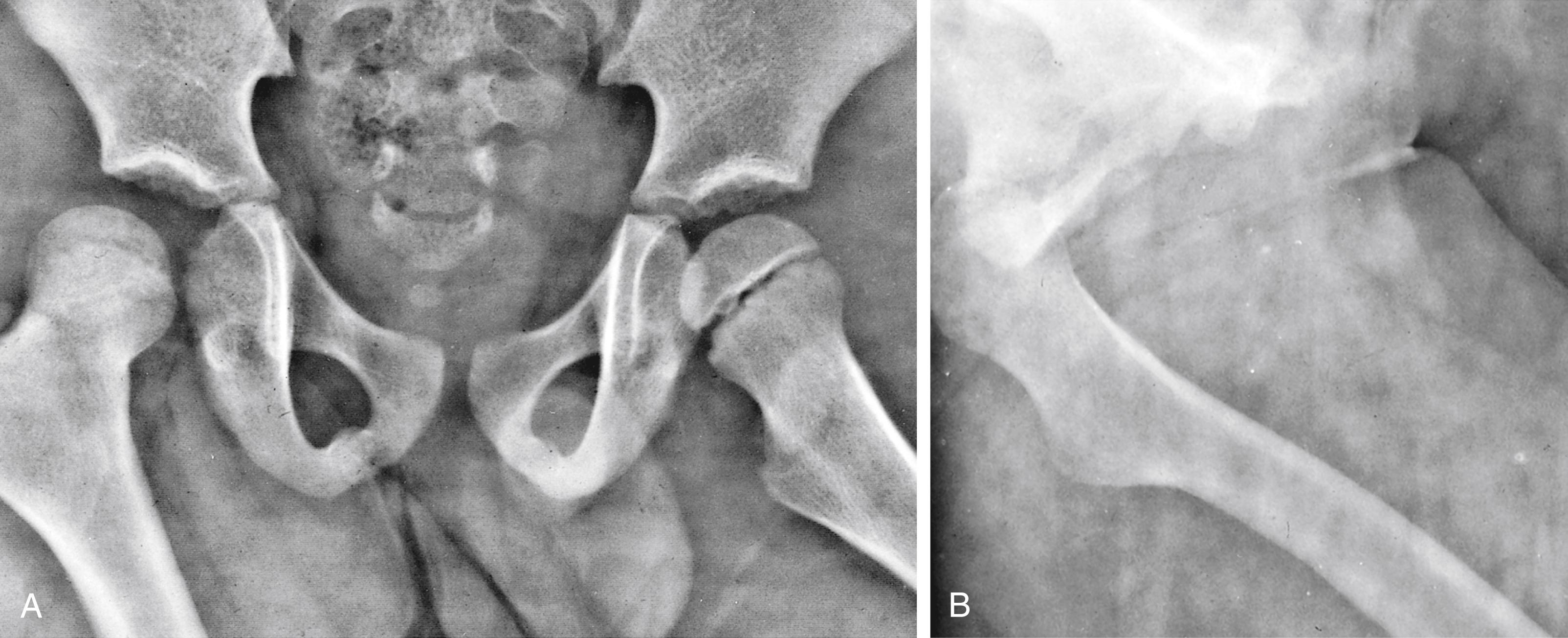
In patellofemoral dislocations the patella usually dislocates laterally ( Fig. 22.59 ). This may occur as the result of laterally directed shearing forces or of a hyperextension injury. In most instances, the patella has relocated by the time the patient is seen. Typical findings on examination include prominent swelling and hemarthrosis, tenderness along the medial patellar border, a positive apprehension test (see the Knee section and Fig. 22.11 ), and increased lateral mobility of the patella. See the Sports Medicine section for further information.
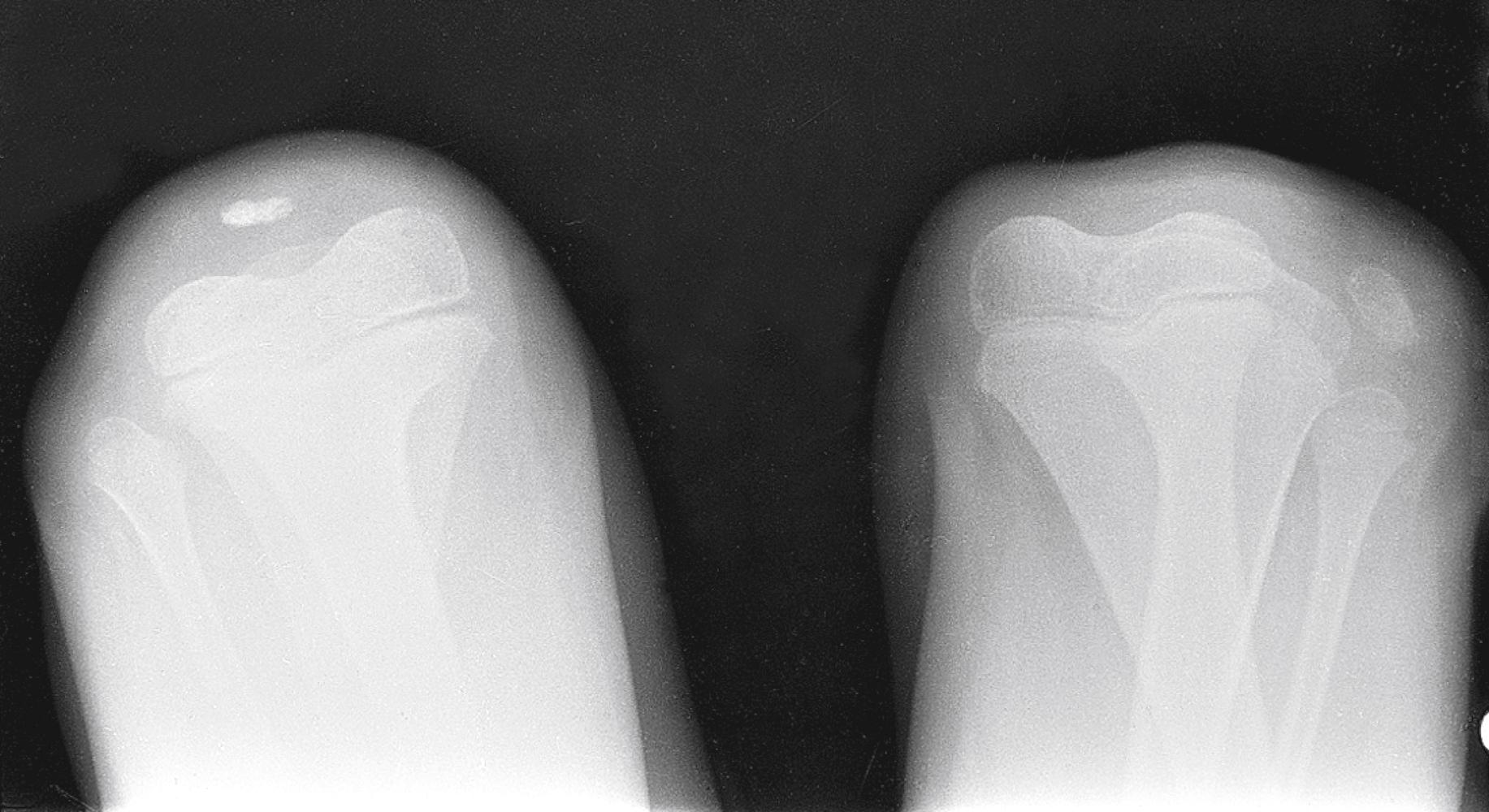
True shoulder dislocations are seen only in adolescents after epiphyseal fusion. On examination of the shoulder, a loss of the rounded contours lateral and anterior to the acromion is found. When the humeral head dislocates anteriorly, it is displaced medially beneath the coracoid process, where it can be palpated ( Fig. 22.60 ). See the Sports Medicine section for further information. Separation of the proximal humeral epiphysis or major fracture/dislocations are seen in younger children subjected to forces that would cause shoulder dislocation after puberty (see Fig. 22.56 ).
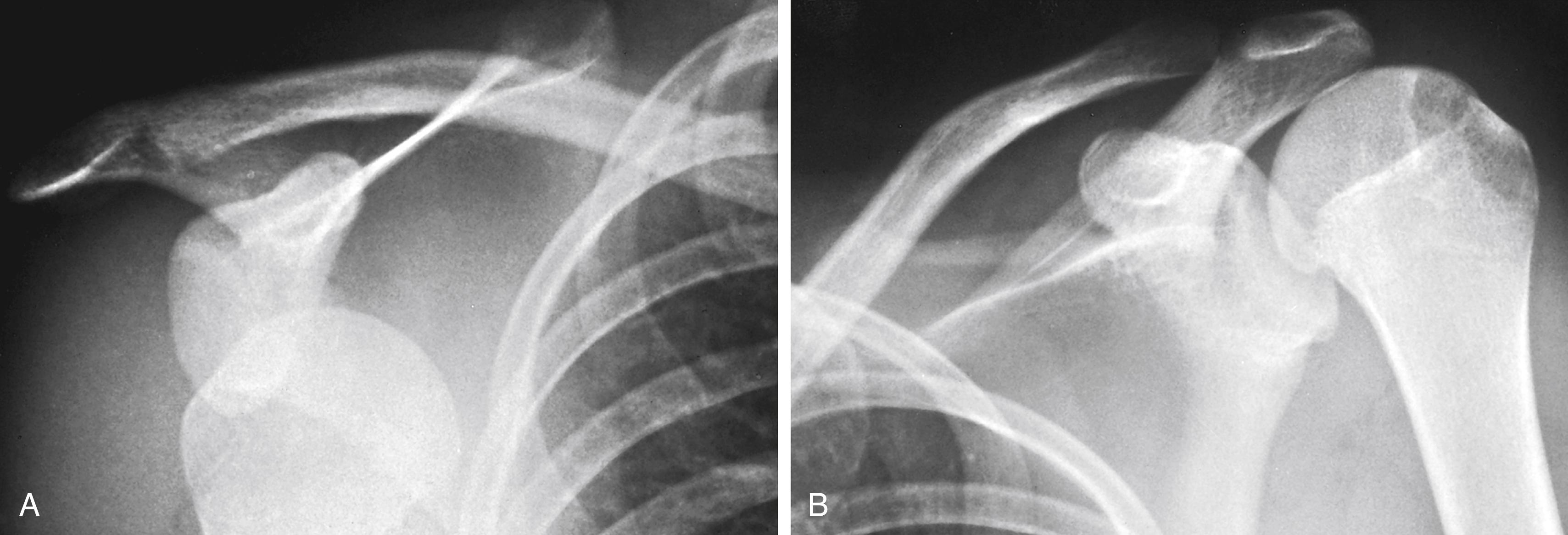
Elbow dislocations are rare in the absence of an associated fracture. The fracture may be as subtle as a nonossified fragment avulsed from the medial epicondyle or the ulna or as prominent as a displaced fracture of the ulna or radius. An example of the latter is the Monteggia fracture, which results from a fall onto the hand with the elbow extended and the forearm rotated radially, producing a varus stress. In this situation, a displaced fracture of the proximal ulna is accompanied by dislocation of the radial head. A radial dislocation should be suspected if a line drawn through the long axis of the radius fails to pass through the capitellum on any view ( Fig. 22.61 ). Less frequently, fractures of the radius are associated with dislocation of the radioulnar joint, and fractures of the olecranon may be accompanied by dislocation of the radius. A fall onto an extended or partially flexed arm with the forearm supinated can result in posterior dislocation of both the radius and ulna with tearing of the anterior portion of the joint capsule and of the medial collateral ligaments. This injury may be associated with fracture of the medial epicondyle (see Fig. 22.35 ), the coronoid process, the olecranon, or the proximal radius. Clinically, the forearm is shortened, and there is an obvious deformity and marked swelling of the posterior aspect of the elbow. A high risk of neurovascular compromise and compartment syndrome exists in patients with this injury.
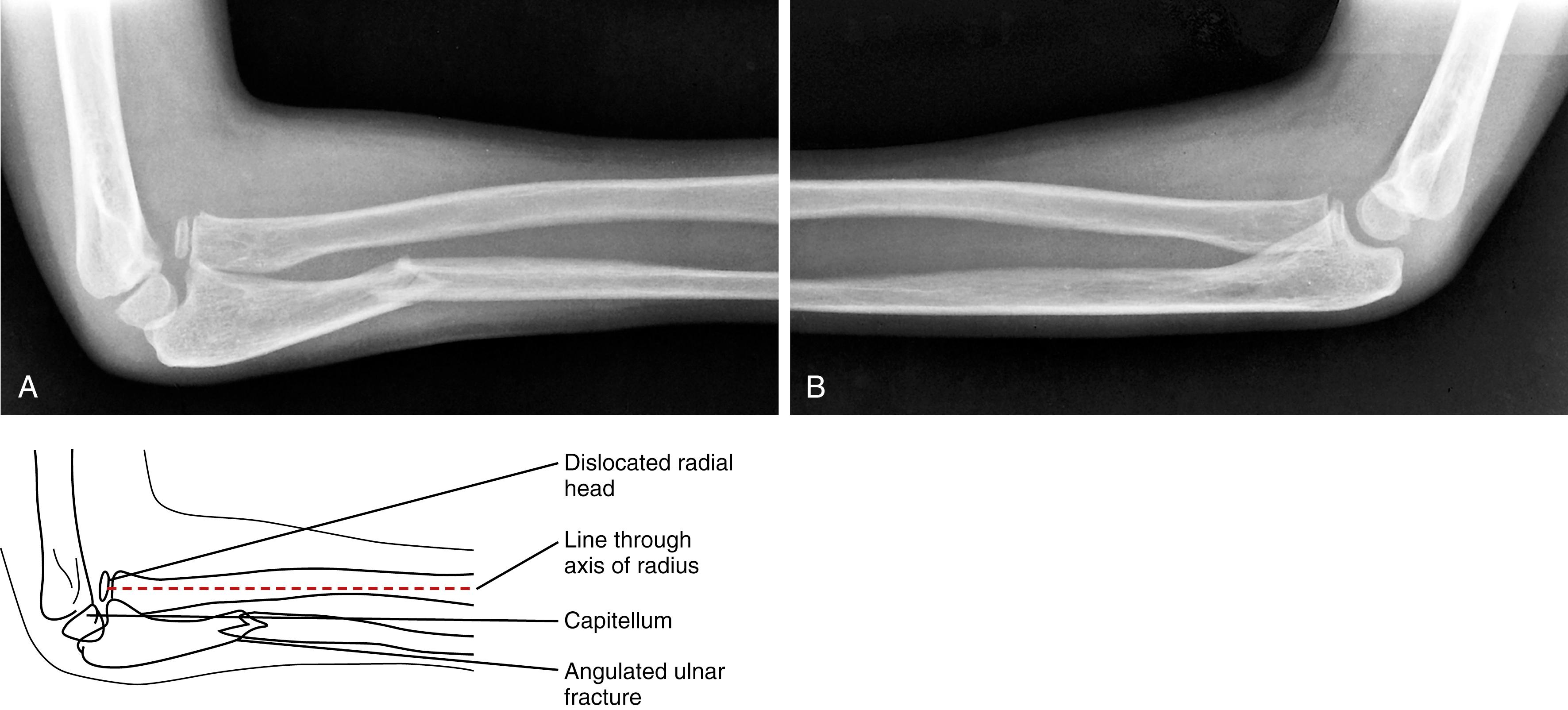
Dislocation of an interphalangeal joint results in an obvious deformity and is an intensely painful injury ( Fig. 22.62 ). Avulsion fractures, volar plate fractures, and tendinous or capsular injury may be associated with it and difficult to detect radiographically. These must be suspected if range of motion is incomplete after relocation. In some cases, the associated injury makes closed reduction impossible.
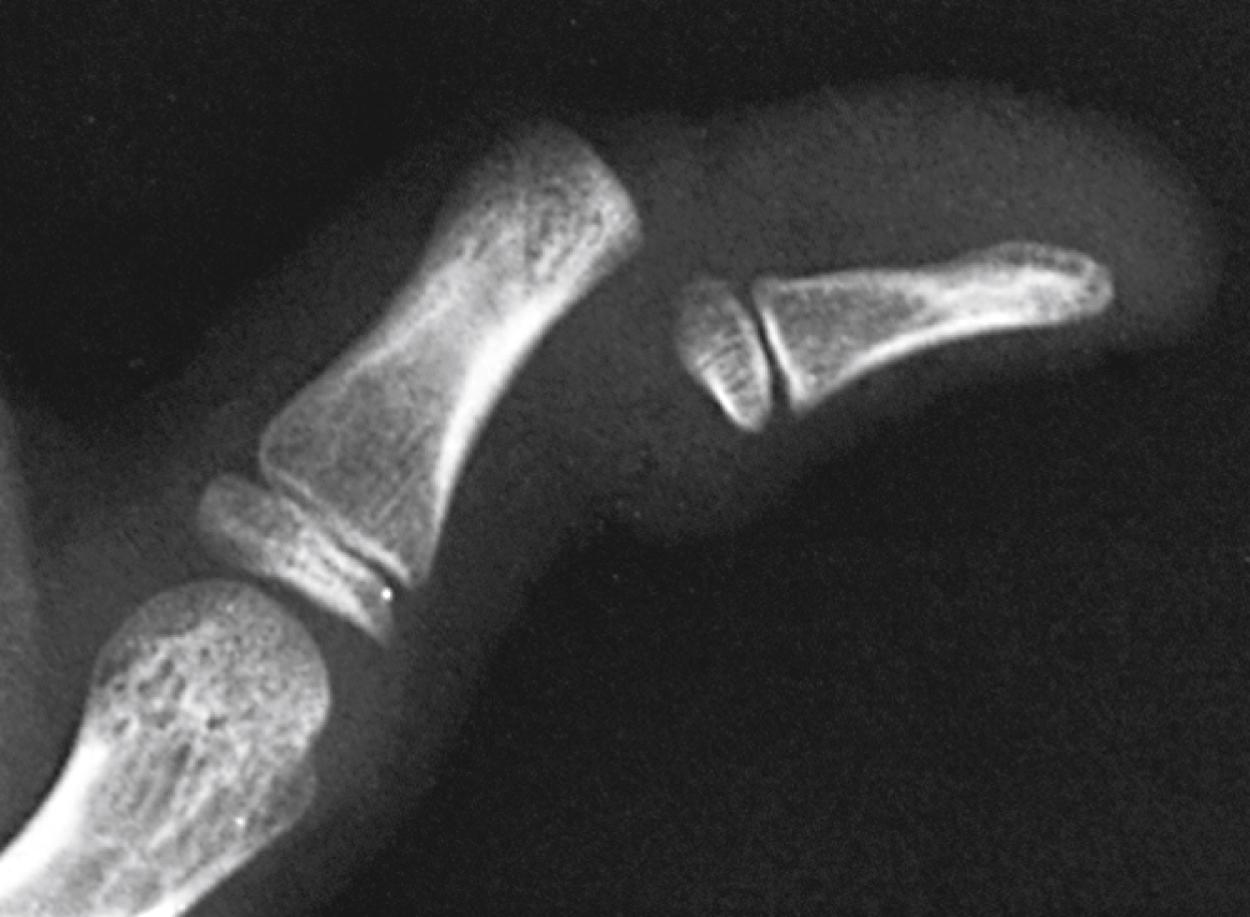
Become a Clinical Tree membership for Full access and enjoy Unlimited articles
If you are a member. Log in here